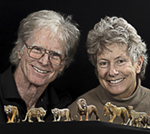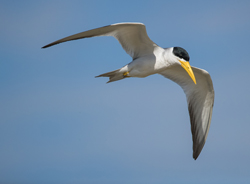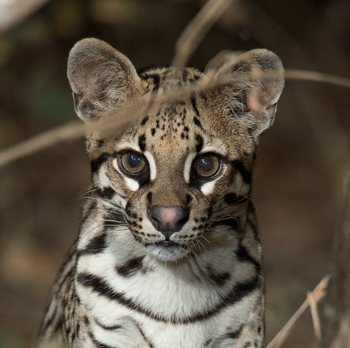
The Pantanal 2017
This summer Mary and I had a special treat, as we were asked to do private Photo Tours to the Pantanal, one of our all-time favorite destinations. Almost ten years ago two friends and I were the pioneers in doing Jaguar tourism here -- via our great outfitter, of course, and on that first trip there was only one other boat looking for Jaguars, and that boat was via that same outfitter. Over the years, probably as much because of our trip reports broadcasting the incredible shooting, Jaguar tourism has flourished, and for a few years it was getting chaotic, crazy, and borderline distasteful. If things weren't done, the area would be ruined.
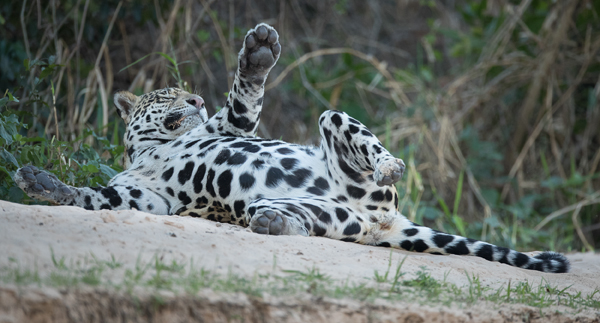
Well, I'm happy to report that I have never been so pleased with the operation as I was this year. Boatmen and guides behaved wonderfully, cooperating with one another and not playing a stupid cut-you-off-screw you- attitude. So the shooting was very pleasant BUT...
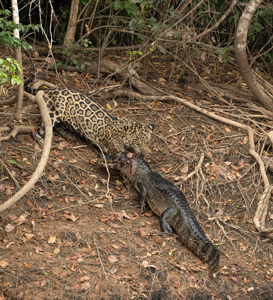
The shooting was also INCREDIBLE. We had two extremely productive trips. Our first involved a serious group of photographers we met at a camera club conference where we were speakers. Our second group was a family, with teenage boys and girls that were a joy to be with. The luck we had ... it could hardly have been better.
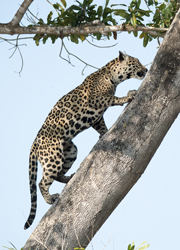 Highlights between the two trips included a Jaguar climbing a tree (a first!), Jaguars mating in the open (Several firsts), an incredible Caiman kill by a Jaguar, a Capybara kill, a Jaguar on a riverside log (my dream shot), and scores of other shots. Read on and you'll see ...
Highlights between the two trips included a Jaguar climbing a tree (a first!), Jaguars mating in the open (Several firsts), an incredible Caiman kill by a Jaguar, a Capybara kill, a Jaguar on a riverside log (my dream shot), and scores of other shots. Read on and you'll see ...
The only good thing is in just three weeks we'll be back again with our 'regular' Photo Tour. Otherwise, I'd be going crazy waiting until next year. Speaking of which, we're doing TWO trips next year .. Join Us, it is incredible!.
Join us in 2018 - we will be doing at least two Photo Tours. Read the Brochure.
Trip One
Day One, July 29th.
We met the group at the Marriot Hotel lobby at 6:30PM, everyone having arrived safely and with their luggage. Mary and I were pleasantly surprised to find ourselves upgraded to Business Class on the flight down – a 9 hour flight that allowed us to stretch out and be comfortable. We did a brief orientation, had dinner, and a reasonably early bedtime, ready to begin the adventure.
Day 2, July 30th.
We left the Marriot at 7:30AM, again fortunate not to have other passengers crowding the bus and potentially creating an issue. Again, we were upgraded, which in this case gave everyone in our group to cluster behind us in line and board the plane first. The flight was uneventful and comfortable, and in Cuiaba we met Marcos, my friend and guide for the past six years. Lunch was at the restaurant we’ve used for years, but it has now been upgraded to a Brazilian barbeque alcedo, with skewers of meat constantly presented, and deliciously cooked. We all ate too much. The drive into the Pantanal provided some opportunities for seeing distant Red-legged Seremias, Greater Rheas, and a large variety to the usual, roadside birds. It was a productive drive.
Just returned from our afternoon/evening game drive, an unexpected bonus on our first day in the Pantanal. Normally, because of flight schedules we do not arrive at one of our lodges until near or after sunset, but today we reached Pueso Allegre by 3:45. At 4 Pm we met our group, all primed and ready for an orientation around the grounds. With enough light to make a drive by our truck/safari vehicle worthwhile we changed plans and headed out for a game drive, a good breaking in for the group and what to expect. It was a productive afternoon.
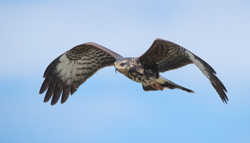 We headed out on to the main game track, then headed more into the brush country and where, in years past, we’ve filmed Giant Anteaters, Tapirs, Tayras, and birds. We didn’t expect much, as this was a reccie, but our drive still produced a lot of good subjects. They included Snail Kites, Egrets, and some landscapes – for shooting, but a lot of birds and wildlife for identification and familiarity – including Great Black Hawks, Savannah Hawks, Roadside Hawks, Crested Caracara,
We headed out on to the main game track, then headed more into the brush country and where, in years past, we’ve filmed Giant Anteaters, Tapirs, Tayras, and birds. We didn’t expect much, as this was a reccie, but our drive still produced a lot of good subjects. They included Snail Kites, Egrets, and some landscapes – for shooting, but a lot of birds and wildlife for identification and familiarity – including Great Black Hawks, Savannah Hawks, Roadside Hawks, Crested Caracara, 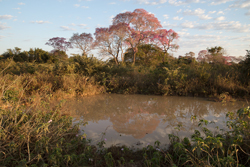 Jabiru Stork, Whistling, Coqui, Black-crowned Night, Capped, and Striated Herons, Green and Plumbeous Ibis, and several songbirds.
Jabiru Stork, Whistling, Coqui, Black-crowned Night, Capped, and Striated Herons, Green and Plumbeous Ibis, and several songbirds.
I was hoping to spot a Tamandua or Giant Anteater but we had no luck. At sunset we were treated to a nice sky but an anchoring foreground was lacking, although we still shot the brilliant colors. We returned to the lodge by 5:45, the sun already set.
Day 3, July 31, 2017
Marcos, our guide, has boundless energy and was anxious for us to do a pre-dawn game drive, the best time to encounter nocturnal animals still roaming the Pantanal. We left at 4:45, 45 minutes or so before sunrise, and the early departure was worth it. Soon after leaving the lodge we had an Ocelot that stayed in view for several minutes, seemingly oblivious to us or the spotlight as the Ocelot walked a game trail and finally meandered out of sight. For Suzanne and Kim the cat was their morning highlight.
We continued on, stopping for numerous birds and several Red Brocket Deer, a small species that inhabits forests and resembles an African Duiker antelope. This similarity was reinforced with a view of one male, its antlers are mere spikes which, on a Duiker, would be horns. Brocket Deer are somewhat pear-shaped, as are the forest-dwelling Agouti, a rodent, designed for squeezing through the undergrowth.
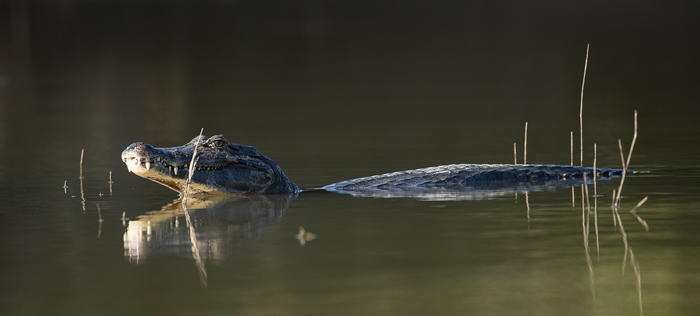
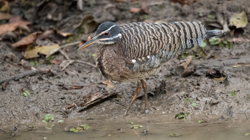 At the same pool where, yesterday afternoon, we had a Capped Heron and a Sunbittern, we again had the latter, which eventually captured a large Giant Waterbug. The wildlife watching and the birding and the shooting was so good that we didn’t return for breakfast until 8:15, and soon after eating we headed back out.
At the same pool where, yesterday afternoon, we had a Capped Heron and a Sunbittern, we again had the latter, which eventually captured a large Giant Waterbug. The wildlife watching and the birding and the shooting was so good that we didn’t return for breakfast until 8:15, and soon after eating we headed back out.
Our post-breakfast game drive took us to a large roadside pool where Large-billed Terns soared, swooped, and fished; Yacare’ Caimans gathered in huge numbers, and the occasional Black-crowned Night Heron or Snail Kite flew by.
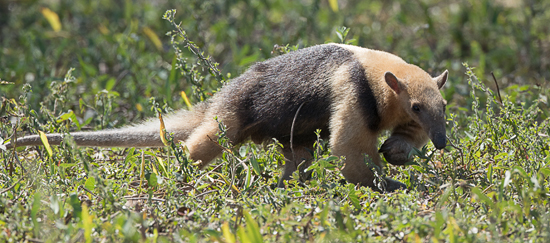
The other great highlight for the morning was a Lesser Anteater or Tamandua that Marcos spotted when we stopped en route to a Roseate Spoonbill nesting colony. The Anteater was en route between forest hammocks and although we intercepted its route the Anteater never stood up defensively and, when we had some shots, continued on his way to another hammock. The Spoonbills were not very satisfying, as birds were not on the nest and flew off at our approach. While we photographed around the nearby pond birds returned, but the light was high and presented no worthwhile shots.
PM. At 4PM we headed out, with finding a nicely isolated tree for a sunset shot the main priority. We found two – on the same route we were on for the Spoonbills. As we explored possibilities we found a flock of well-camouflaged Nacunda Nightjars, the largest species of nighthawk or nightjar (same thing, a Goatsucker). Phil got an outstanding shot of one flying by, parallel to him, but Becky and my luck wasn’t as good – all I managed were tail-end views.
After locating a tree we continued on, stopping for a cooperative Southern Lapwing and a nice view of distant, acrobatic Howler Monkeys – several leaping from tree to tree, before returning to the sunset tree where we finished the day with some scenic shots.
August 1, Day 4. Pueso Allegre to Santa Theresa Lodge
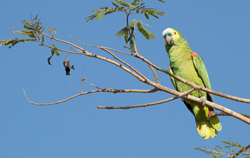 We stayed around the grounds for our pre-breakfast and post-breakfast shooting, with our group somewhat scattered about, principally looking for Hyacinth Macaws. Mary and I, separately, had headed down the main lodge road, where – just minutes after leaving my room – I had the most cooperative Green Ibis I’ve ever had. After breakfast we worked on Hyacinth Macaws and Turquoise-fronted Parrots.
We stayed around the grounds for our pre-breakfast and post-breakfast shooting, with our group somewhat scattered about, principally looking for Hyacinth Macaws. Mary and I, separately, had headed down the main lodge road, where – just minutes after leaving my room – I had the most cooperative Green Ibis I’ve ever had. After breakfast we worked on Hyacinth Macaws and Turquoise-fronted Parrots.
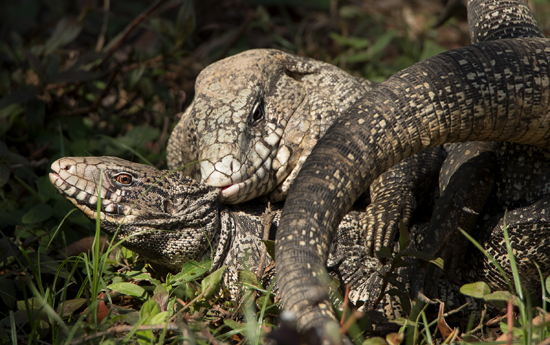
Several Black and White Tegus had crawled out from the shed where they spent the night and sunned. Marcos got a few eggs and these hen-house raiders avidly snatched up the eggs that were tossed their way. Male Tegus have an almost ruff-like neck, a big swelling that reminded me of a bull elephant seal. Females are slender and stream-lined, and both were present. After the egg-eating, one of the males seemed interested in a female and so I remained, filming the male as he followed the female, very much like a snake courts a female. He hitched himself along, rubbing his chin against her tail and moving upwards to her hips, finally coming to rest with one foreleg draped over her back.
The female invariably moved off, and the male would circle about, finally returning to her tail and repeating the process. Twice, a smaller male appeared and came close, and the first time this occurred the male left the female and charged after his potential rival. The second time, another male circled about as the couple lay entwined, but the male did nothing. Finally, the female slipped from beneath him and walked off, within only a few yards of the other male. About ten seconds later the original male moved, following the female and then grabbing her in a bite around the neck. Seconds later they entwined in a big U, with the male’s tail held high, and they mated. The coupling lasted about thirty seconds, when with a jerk they disengaged and both lizards went their separate ways. I videoed the entire sequence.
At 10:15 we left for ST, arriving around 11:45. At 1, Mary, Marcos, and I headed out to the Ocelot blind to set up flashes. The setup this year is completely different from last, being much more diverse and photogenic, however the foreground was given little thought, and obstructing vines block views. I used some cord to tie back a vine, but I’d have far preferred to have permission to trim the vines back as they played no role. I had planned to use makeshift lightstands out of bamboo I lashed into tripods, but the ground was too solid and hard and, instead, I ended up strapping the flashes to tree limbs. An hour after started we were set up and ready for the evening.
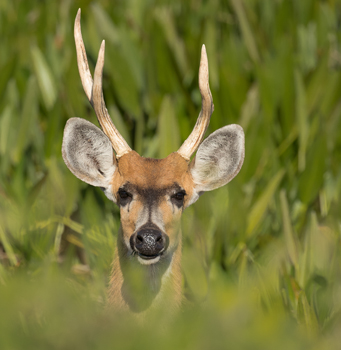 We were scheduled to do a boat ride at 3:30, and around 3:15 a buck Marsh Deer and two does came down to a pond that is now invisible from the road. No one except me was interested in checking it out, and when I fired a motor drive all three grew alarmed, with the two does running to opposite ends of the pond. After several minutes of quiet the deer relaxed, but just then Mary called for me to come to the boat – an unnecessary move as the boatmen were still ten minutes late!
We were scheduled to do a boat ride at 3:30, and around 3:15 a buck Marsh Deer and two does came down to a pond that is now invisible from the road. No one except me was interested in checking it out, and when I fired a motor drive all three grew alarmed, with the two does running to opposite ends of the pond. After several minutes of quiet the deer relaxed, but just then Mary called for me to come to the boat – an unnecessary move as the boatmen were still ten minutes late!
The boat ride was fairly successful, with one good pass with a Black-collared Hawk and several with Ringed Kingfishers. For the first time we had a Roadside Hawk also swooping down for a fish, as did a Yellow-headed Caracara. Everyone got something, but I must admit my timing, or my focus, was just terrible and I missed almost all the Kingfisher dives – sometimes being out of focus by just an inch or so!
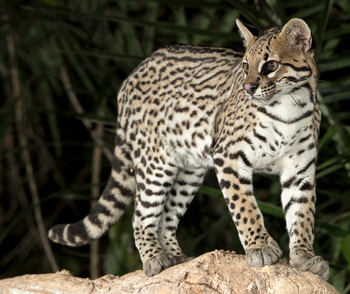 At 7PM, right after dinner, we headed to the Ocelot blind. Mary and I arrived a few minutes early to turn on the flashes and transmitters and receivers, but the group arrived just as we finished. An Ocelot, hungry and anxious, sat only a few yards from Mary as she stood by the bait station, as I checked the flash exposures. Within ten minutes of our settling in the Ocelot returned and put on a show. After three re-baitings we were out of meat, just as another, even larger Ocelot arrived. Our first Ocelot yeowed her complaints and, finding no food, the new cat, a male, followed her into the brush. We packed up and were back at the lodge by 8:40.
At 7PM, right after dinner, we headed to the Ocelot blind. Mary and I arrived a few minutes early to turn on the flashes and transmitters and receivers, but the group arrived just as we finished. An Ocelot, hungry and anxious, sat only a few yards from Mary as she stood by the bait station, as I checked the flash exposures. Within ten minutes of our settling in the Ocelot returned and put on a show. After three re-baitings we were out of meat, just as another, even larger Ocelot arrived. Our first Ocelot yeowed her complaints and, finding no food, the new cat, a male, followed her into the brush. We packed up and were back at the lodge by 8:40.
August 2, Day 5.
The group did some shooting before breakfast, of Toco Toucans, songbirds, and for Phil and Ellen, the scaffold tower for the Jabiru Stork nest. We left the lodge around 8:30 for the drive to Porto Joffre, arriving around 11:05 where we met our boats for the cruise up the Cuiaba River and the Flotel, in Jaguarland. After a brief orientation on arriving, we had lunch and unpacked for a 2PM departure for a game drive/cruise.
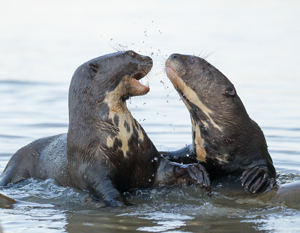 Almost immediately, my boatman, John, spotted a Neotropical Otter, the rarer of the two species found here, grooming itself on a riverside log. We tried to get into position but the Otter slipped into the water and disappeared. Mary, with Ellen and Phil, stopped along a sandbank for a Pied Plover and Capybara, while we continued, finding three Giant Otters in the beginning of the Black Lagoon. They were exceptionally tame, grooming themselves on a log in good light, and we had them for nearly a half hour. We continued up the lagoon, but were called away for a Jaguar sighting, back up the Three Brothers River.
Almost immediately, my boatman, John, spotted a Neotropical Otter, the rarer of the two species found here, grooming itself on a riverside log. We tried to get into position but the Otter slipped into the water and disappeared. Mary, with Ellen and Phil, stopped along a sandbank for a Pied Plover and Capybara, while we continued, finding three Giant Otters in the beginning of the Black Lagoon. They were exceptionally tame, grooming themselves on a log in good light, and we had them for nearly a half hour. We continued up the lagoon, but were called away for a Jaguar sighting, back up the Three Brothers River.
Kim and Becky, with Marcos, as well as Mary’s boat did have a brief glimpse of the cat when it stood up and turned around, lying down again about 10 feet into the forest. We missed it. We spent the rest of the afternoon searching for the cat, as periodically it was spotted, but nothing became of the encounter.
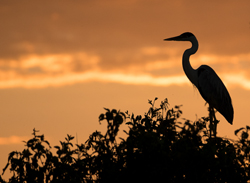 As we headed back towards the Flotel, at 5PM, our boat pulled into the Charles Creek for a final search for jaguars but had no cats, but we did have a great sunset with trees framing the sky, then a Coqui Heron landing and silhouetting nicely against the orange-gold sky. Mary’s vehicle had a dugout w fisherman cruising by for another nice silhouette. We arrived at the boat around 6, as darkness was finally setting in.
As we headed back towards the Flotel, at 5PM, our boat pulled into the Charles Creek for a final search for jaguars but had no cats, but we did have a great sunset with trees framing the sky, then a Coqui Heron landing and silhouetting nicely against the orange-gold sky. Mary’s vehicle had a dugout w fisherman cruising by for another nice silhouette. We arrived at the boat around 6, as darkness was finally setting in.
Day 6, August 3.
Our first full day in Jaguarland, and we started the day at 6, leaving the Flotel to surprisingly cool, or cold, temperatures. Within minutes of cruising we were wearing everything we brought along, and most of us were still cold. The high today was predicted to be 82, and the morning started at 60, but it felt much colder.
My boat headed upriver, eventually arriving at the Black Lagoon. Caimans were not yet in courtship, and our best shooting included perfect reflections of a Caiman and a Wattled Jacana that eventually grabbed a slug from the water hyacinths. That’s when we got our first Jaguar call.
Mary’s boat had gone far upriver on the Piquani, almost to the fishing village, prime territory for Tapirs. On the way back, quite close to the Flotel, they had a family of six Giant Otters feeding on a log. Then, past the Flotel, they spotted a female Jaguar with two cubs, a bit over 18 months old. They were on an open sandbar and they got shots of all three together before the three, in five minutes or so, disappeared back into the brush. Which is when our other two boats arrived – too late!
We continued to the Three Brothers River, and our boat turned into Charles Creek after a short pause at a sandbar where a large flock of Black Skimmers were roosting. At the Charles we received another radio call, and we raced back – right to the Skimmer beach and up the Cuiaba River where, at the far end of the sand bar, a female Jaguar was walking along, then disappeared into the tall river grass.
We followed, catching occasional glimpses of the vegetation moving, but eventually she stepped into the clear for some nice shots. And then she continued upriver, following the bank and providing numerous chances as she stepped out of the brush, or walked along the tall river bank, or slid down into a gulley to walk closer to the edge.
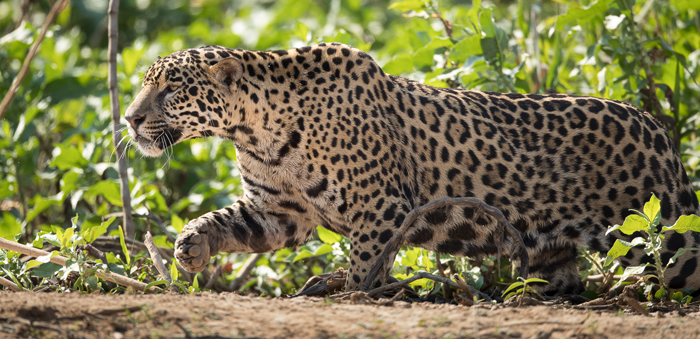
At least 18 boats arrived, but everyone was remarkably cooperative. One boatman was often just behind our boat and was careful not to push forward and block our view. Later, I had a chance to compliment him on his courtesy and professionalism, and later still, he came by again to say he had met me, or seen me, last year when he was driving a Nat’l Geo photographer around. We chatted for a few minutes and again complimented him on his work, and told him he was a great role model that other boatmen should follow. He appreciated the recognition – well deserved!
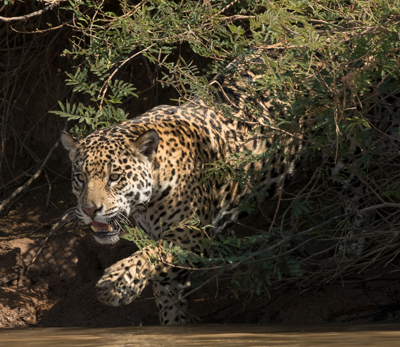 At one point our Jaguar seemed to disappear and about half the boats raced upriver where another Jaguar was spotted. We stayed behind, and our cat reappeared and walked up river. Eventually the two cats met – Marcos told us they were grown sisters, recently independent from Ruth, their mother. Our two cats were named …
At one point our Jaguar seemed to disappear and about half the boats raced upriver where another Jaguar was spotted. We stayed behind, and our cat reappeared and walked up river. Eventually the two cats met – Marcos told us they were grown sisters, recently independent from Ruth, their mother. Our two cats were named …
Our cat wanted nothing to do with the second cat, her sister, who at times jogged along, following our cat. Several times our cat stopped and doubled back, snarling and grimacing her displeasure. The second cat would just sit down and wait her out. In their last confrontation the two came close but didn’t touch, before our cat moved away from the river and temporarily disappeared. The second cat turned around and headed back up river and we followed, until she, too, headed into the brush.
We moved downriver and found ‘our’ Jaguar again, who presented a few more shooting opportunities before disappearing – either to rest or to move away from the river. We headed towards home, at 11:15, arriving back at the Flotel around 11:50.
The group had 5 Jaguars today, 3 with Mary, and another 2 that all of us had. Our total – 6 to date.
PM. We left at 2PM, heading downriver towards the Cuiaba. Almost immediately we had 3 of the 6 Giant Otters Mary had had in the AM. Now, they were grooming and scent marking on the river bank, presenting full views as they scratched, belly scraped, and slid back into the water. Another Jaguar call took us to the Black Lagoon.
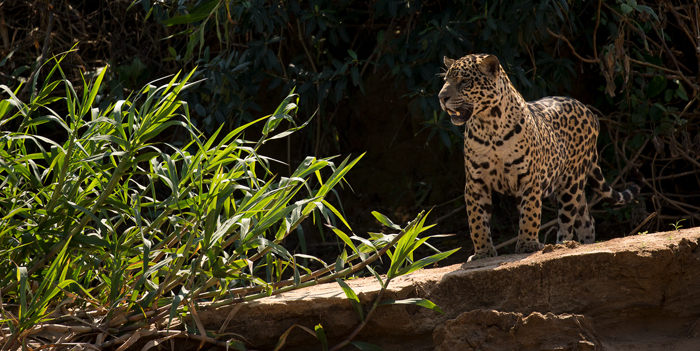
Another female Jaguar was walking along the river bank, but the shooting was marginal and eventually the Jaguar moved into a grassy canal. We waited, and she reappeared, but still another Jaguar radio call had us heading back to the Cuiaba. Mary, with Phil and Suzanne, had enough with the crowds and left early, spending the rest of the day exploring and doing birds. The rest of us headed to the river.
My boat arrived a few minutes after Marcos’s boat, and Marcos saw a Jaguar grab a baby Capybara, bite it, and drop it. I arrived in time to see the Jaguar leap like a fox through the high grass, apparently catching another baby Capybara. I honestly didn’t think we’d see the Jaguar again since it had a kill, but Marcos stayed, and I followed his lead – he had seen the Jaguar drop the first baby.
About 15 minutes later the Jaguar appeared, her face bloody from eating. We shot a couple images, then she reached down and picked up the first baby Capybara! This was only the second time I’ve seen a jaguar with a Capybara, and the light and the situation was great. Again, she turned and disappeared into the grasses.
We didn’t see it, but apparently the Jaguar then crossed the river further downstream. We got the call and headed to her, and after the first 15 minutes of very flighty views, she reappeared in full view, lying in the open on the river bank to groom. Afterwards she continued to hunt, stopping often for great portraits, and we stayed with her until 5PM, when in the last light of the day we headed out for scenic.
Ellen and Becky had left earlier and enjoyed themselves on the Charles River, shooting landscapes and birds. We went to the Black Lagoon, shooting some trees and a Heron we tried to line up with the sun. On the way back to the Flotel I had the most cooperative Nightjar keeping pace with our boat, just soaring and flapping overhead, but I hadn’t anticipated this and didn’t have a flash ready. Mary, on her return, stopped at the Cuiaba and saw ‘our’ Jaguar – giving her boat 7 for the day.
With tonight’s two Jaguar sightings – 8 to date.
Day 6, August 4, 2017
Three more Jaguars this morning – 11 to date.
Mary’s boat, with Becky and Jack, headed up the Cuiaba River, eventually doing the shortcut through the Caiman channel back to the Three Brothers. They were too far out of range to return when they had a radio call about Jaguars in the Black 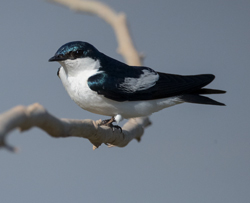 Lagoon, where my boat, and Marcos’, spent much of the morning. Nonetheless, Mary’s boat had a great experience with a Jaguar on the shore just above an Otter den. The six Otters were in the water, screaming a vocalization Mary had never heard before. Eventually the Jaguar moved off, and the Otters settled down, until they spotted the cat further down river. The screaming resumed until the Otters lost interest. Mary’s folks got some nice shots of the Jaguar lying on
Lagoon, where my boat, and Marcos’, spent much of the morning. Nonetheless, Mary’s boat had a great experience with a Jaguar on the shore just above an Otter den. The six Otters were in the water, screaming a vocalization Mary had never heard before. Eventually the Jaguar moved off, and the Otters settled down, until they spotted the cat further down river. The screaming resumed until the Otters lost interest. Mary’s folks got some nice shots of the Jaguar lying on
Meanwhile, our other boats headed up the Black Lagoon. On the Piquiri River, we had a Tapir at the water’s edge but it retreated before we could get any shots. The morning had started cloudy and the light was low – ISO 5000 at 1/80th, so any shot would have been marginal.
At the lagoon we had Mary’s 6 Otters, with one perched at a branch chewing away at one of the vividly striped catfish. We were so still I could do some great video as they munched. A Jaguar radio call pulled us away …
Marcos, with Kim and Suzanne, had the Asian Water Buffalo and two Jaguars. Marcos thought they might try tackling it (improbable) but the Buffalo charged the two, scattering them where they remained separated for the rest of the morning. We alternated checking out both, with some great riverside shooting of one. At one point the Jaguar leaped at a Capybara but missed – Marcos’s boat had it, but the grasses were too high and the cat some distance away for shots. I had a chance to get some video of the Jaguar walking along the shoreline.
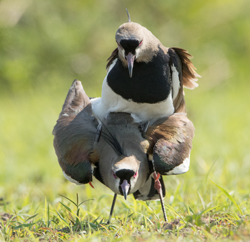 Between Jaguars, as they spent much time sitting, we cruised up the Black Lagoon, getting eye-level shots of Southern Lapwings on the shore. They were scouting out a nesting spot and while we watched they mated, straight on in front of us. Their vivid red spurs jutted out prominently from the elbows of their wings, something not often seen. We had several great bird and Caiman opportunities, including a nice landscape/caiman shot on the Charles Creek.
Between Jaguars, as they spent much time sitting, we cruised up the Black Lagoon, getting eye-level shots of Southern Lapwings on the shore. They were scouting out a nesting spot and while we watched they mated, straight on in front of us. Their vivid red spurs jutted out prominently from the elbows of their wings, something not often seen. We had several great bird and Caiman opportunities, including a nice landscape/caiman shot on the Charles Creek.
We arrived back at the Flotel at 11:45, and Mary, held up by the Jaguar-otter encounter, at 12:05.
PM. We left at 2PM, and a half-hour into our cruise my boatman spotted a Jaguar walking through the forest on the Piquiri River. Upstream there was a small family of Capybara – two young and three adults, and we motored up to them, waiting for the Jaguar. I kept focused on the Capybaras, expecting the rodents to explode into flight, while Kim saw the cat as it began its charge. As expected, the Capybaras charged into the water and, in the far left side of my frame the running cat appeared. Oddly, the ONLY two shots that the cat was totally in the frame the cat is out-of-focus, as is the splashing water. Nothing is in focus and I can’t explain what happened.
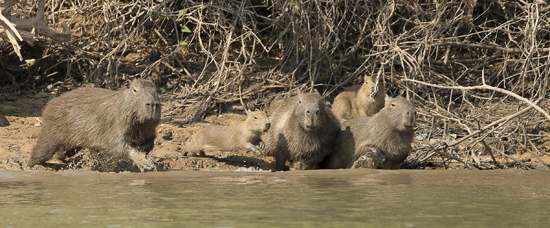
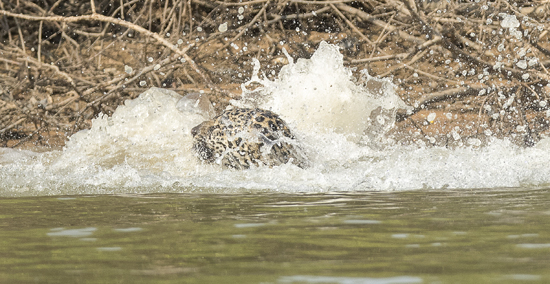
At any rate, the Jaguar missed, and came out of the water while Capybara heads appeared, snorting their alarm barks. The cat walked into the forest and disappeared.
We continued, and on the Cuiaba River we had another family of Capybaras, this time with six or seven very tiny pups. They were along a steep river bank so the shooting was somewhat constricted, and eventually the rodents took to the water and swam to a patch of thick vegetation, with all six babies trying to hitch a ride on their mother’s back as they swam upstream.
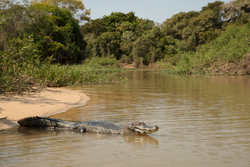 Ellen and I continued up the Three Brothers, turning at the side channel that forms one of the borders for St Peterson’s Island. Caimans were everywhere, and we did several shots with Caimans with their mouth agape. Tiger-Herons, Ringed Kingfishers – including one smacking a catfish repeatedly upon a limb, Bare-faced Carrasows, and a small Caiman with a large catfish – just some of our subjects.
Ellen and I continued up the Three Brothers, turning at the side channel that forms one of the borders for St Peterson’s Island. Caimans were everywhere, and we did several shots with Caimans with their mouth agape. Tiger-Herons, Ringed Kingfishers – including one smacking a catfish repeatedly upon a limb, Bare-faced Carrasows, and a small Caiman with a large catfish – just some of our subjects.
At the end of the day, just after shooting a Giant Otter in the golden light, we had another Jaguar radio call, at the Black Lagoon. We raced there in the failing light, finding the Jaguar in the open but in shade, in very dull light, with several boats already blocking any possible good view. Wisely, we abandoned this subject and concentrated our remaining time shooting sunset landscapes, as some clouds had gathered and gave color to the western sky.
Day 7, August 5, 2017
Three more Jaguars this morning, for a total of 14.
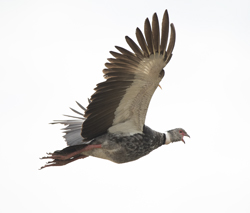 We left the Flotel at 6 with a few scattered clouds in the sky and slightly warmer temperatures than yesterday. Still, it was quite chilly as we started the cruise, and it remained cool, or cold, for the first hour or so. We headed towards the Black Lagoon, pausing to take sunrise shots of the colorful sky and silhouetted trees.
We left the Flotel at 6 with a few scattered clouds in the sky and slightly warmer temperatures than yesterday. Still, it was quite chilly as we started the cruise, and it remained cool, or cold, for the first hour or so. We headed towards the Black Lagoon, pausing to take sunrise shots of the colorful sky and silhouetted trees.
Mary headed upriver first, spending two hours on the Piquiri River. They had a great Neotropical Otter who was sharing a fish with her baby and, when swimming away, grabbed the half-grown pup in her mouth and carried her like a kitten. They also had a wonderful display of three Capped Herons, presumably two males dipping and showing their cap to a female, and picking up leaves and twigs as presents. They had a view of one shy Jaguar, which Mary spotted at nearly 300 yards. Later, she saw Hero at the Black Lagoon – my boat heard of it but we were over 45 minutes away and decided to stay on the Peterson’s creek. Later, when we had completed our shooting on that Creek we had another Jaguar Radio call – and we raced to that location.
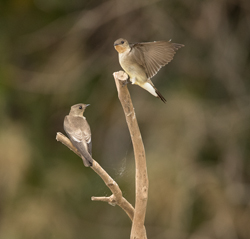 Prior to that, however, we had our own view of Hero, on the Three Brothers, as he walked along a high bank at a sharp dog-leg on the river. I was in the process of tying in our boat to a tree trunk sticking out of the river when the cat appeared, and holding a rope wrapped around the tree with one hand, I managed to grab my monopod and shoot the Jaguar as it walked by. Surprisingly, several shots were OK in the composition!
Prior to that, however, we had our own view of Hero, on the Three Brothers, as he walked along a high bank at a sharp dog-leg on the river. I was in the process of tying in our boat to a tree trunk sticking out of the river when the cat appeared, and holding a rope wrapped around the tree with one hand, I managed to grab my monopod and shoot the Jaguar as it walked by. Surprisingly, several shots were OK in the composition!
That cat disappeared, and we continued to the Caiman Lagoon where we had a great immature Tiger-Heron preening and completely oblivious to us. A few minutes later we had a pair of Rufous-tailed Jacamars along the bank, sky-hawking insects and digging into the river bank, probably building a nest. As we headed out we had a very cooperative Jacare Caiman that allowed us to get close enough to lean over the side and, using Live View, compose wide-angle shots at water level. Wonderful shots!
On the Peterson we had the immature Black Hawk again, more Caimans, and a lot of mosquitos. We had just turned around and started back down the creek when we got the call, arriving just as the Jaguar show was getting good. The female walked along the top of the bank, then down and into the river, where she swam parallel to us before climbing back, repeating the process, and then disappearing – where she laid down to sleep. Sadly, a young Caiman was just a hundred yards or so up ahead, and had she continued … We staked out the Caiman but the reptile eventually swam off.
Meanwhile, Kim and Ellen switched places with me and I moved into Mary’s boat to continue the watch while the rest motored home. After 10 minutes or so we too left, and we headed to the Black Lagoon for a final check. Caimans were everywhere, but nothing of note and we headed back, arriving around12:05.
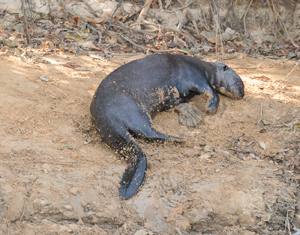 PM. Because of the heat our group wanted a later departure, and so we left at 3PM … without any negative repercussions for doing so! The day’s heat had broken by the time we started cruising but it was still hot when we’d stop for photography.
PM. Because of the heat our group wanted a later departure, and so we left at 3PM … without any negative repercussions for doing so! The day’s heat had broken by the time we started cruising but it was still hot when we’d stop for photography.
Our first subject was two Giant Otters wrestling and grooming each other on the Cuiaba. Mary’s boat eventually dropped an anchor and we attached our boat to her’s – otherwise, our shooting was somewhat difficult because one stick blocked a good view. We continued on, and received a radio call that a Jaguar was seen far upriver. With nothing else in view we headed there, to find a Jaguar lying in the open on a rise of a sandy beach, the first time I’ve ever seen a cat on that beach. The cat was very relaxed, and spent most of her time sleeping, but as time went by she rose, looking out over the river where she had heard something. Eventually she dropped back down to rest, and in the last light of the day we raced 3 minutes up river where another Jaguar lay completely in the open. This one had had some type of interaction with two Giant Otters, but I had no details.
Marcos’s boat, with Suzanne and Becky, had one incredible sighting – a Giant Anteater swimming across the Three Brothers River! It disappeared into the forest as soon as it crossed.
Day 8, August 6, 2017
We left at 6 under a clear sky, cool temperatures, and a misty fog rising from the warm waters. With the rising sun we stopped for a silhouette of the inverted hand-like tree mid-river, with the sun hidden behind a branch, creating a starburst effect. We stopped for a pair of Capped Herons, skittish as usual, and a small family group of Capybara that were catching the first morning light. While we were doing so my boatman yelled ‘Tapir,’ which had swam up behind us and which we 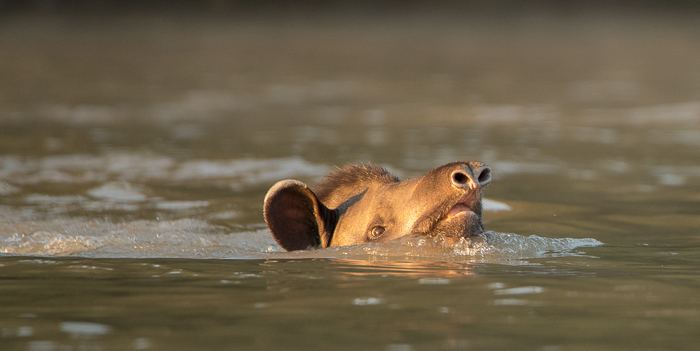
had a couple of shots before it disappeared into the forest. We were disappointed in missing it when we noticed another Tapir also swimming across – and we headed out to follow it to the shoreline. Its prehensile snout rose above the water at times as it swam, but it never disappeared from sight.
We had a male Jaguar along the Cuiaba, a big, ugly male with a cut lip. It was hunting, but eventually disappeared into the forest.
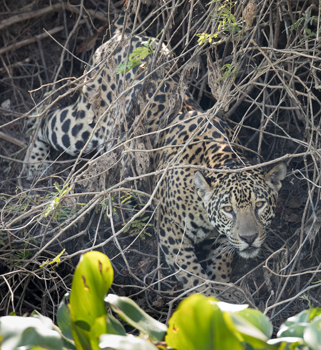 We headed up the Black Lagoon when we had a Jaguar radio call, a cat about 30 minutes up the Cuiaba. We decided to pass, and only two minutes later my boatman spotted a Jaguar on the shoreline – right in front of us. Good choice! We followed the cat as it headed upstream, then down, and surprised us when she climbed a tree – climbing about 30 feet to a limb, where she turned around and started back down. To do so she went backwards, hitching herself along, half-sideways, facing us, as she jerked down the tree trunk until turning and leaping the last few feet. The cat moved downriver again, finally settling in the shade for nearly 45 minutes before walking back upstream, and disappearing into the forest.
We headed up the Black Lagoon when we had a Jaguar radio call, a cat about 30 minutes up the Cuiaba. We decided to pass, and only two minutes later my boatman spotted a Jaguar on the shoreline – right in front of us. Good choice! We followed the cat as it headed upstream, then down, and surprised us when she climbed a tree – climbing about 30 feet to a limb, where she turned around and started back down. To do so she went backwards, hitching herself along, half-sideways, facing us, as she jerked down the tree trunk until turning and leaping the last few feet. The cat moved downriver again, finally settling in the shade for nearly 45 minutes before walking back upstream, and disappearing into the forest.
At 10:30 the group was hot and folks transferred into two boats to head back, leaving me alone with my boatman to stake out the cat. It never reappeared, although we did several passes, but we did have another, so-so view of an enormous female Jaguar, as big as most big males. I did a final pass in the Lagoon, where we encountered the Giant Otters again (we had them earlier in the morning, too!), with
at least five of the six Otters feeding on Armored Catfish. It was a feeding frenzy and, alone in the boat, I could do motionless video – I only shot a few stills.
It was a tremendous morning, with 3 Jaguars, 2 Tapirs, Giant Otters, and assorted birds.
Our Jaguar count is now 17.
PM. Our count is now 20.
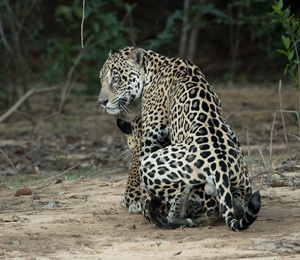 We left at 3PM, one hour later than the other two tourist groups, all of us headed towards a pair of mating Jaguars about 30 minutes upstream. We arrived around 3:30, with both cats lying in view beneath a fallen log. Later, the female came to the bank where she continued her nap. At 4:30, she walked over to the river’s edge to drink, and the male rose and went to meet her. They semi-snarled at one another as they butted heads, then she turned, faced away from us, and the two mated, amidst a bit of snarling. The male leaped over her, she rolled on her back a few times, and the two then lay down again a short distance apart. A few minutes later both cats disappeared into the forest. For Marcos, this was only the third time he’d ever seen mating in the open, and it was Mary and my first.
We left at 3PM, one hour later than the other two tourist groups, all of us headed towards a pair of mating Jaguars about 30 minutes upstream. We arrived around 3:30, with both cats lying in view beneath a fallen log. Later, the female came to the bank where she continued her nap. At 4:30, she walked over to the river’s edge to drink, and the male rose and went to meet her. They semi-snarled at one another as they butted heads, then she turned, faced away from us, and the two mated, amidst a bit of snarling. The male leaped over her, she rolled on her back a few times, and the two then lay down again a short distance apart. A few minutes later both cats disappeared into the forest. For Marcos, this was only the third time he’d ever seen mating in the open, and it was Mary and my first.
The group left, but Mary transferred to my now-empty boat and we stayed behind, hoping that the two would return. They did not, and at 5:10 we headed home, spotting another Jaguar on the river bank that retreated into the brush, our 20th cat for this trip.
Day 9, August 7, 2017
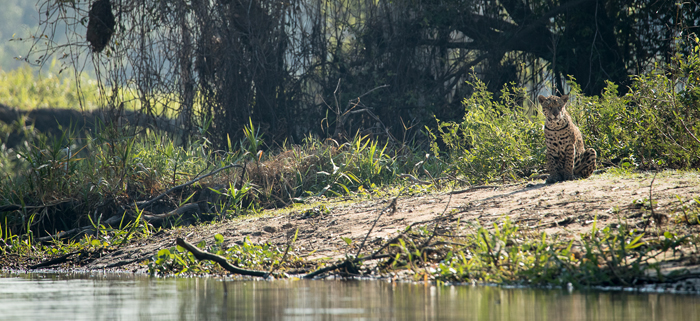
We had a final Jaguar cruise this morning before heading back to Porto Joffre and the bus ride to our next lodge, Santa Theresa. It was spectacular.
We started with the Inverted Hand Tree, this time framed with some clouds and color in the sky, before heading to the Black Lagoon. At its entrance we had an extremely cooperative Black-capped Donocobious, a swamp wren that is normally rather furtive. This one stayed on a branch and a thicket of thatch for several minutes. We continued up the lagoon a short distance before turning to the Charles Channel, for another Jaguar radio call.
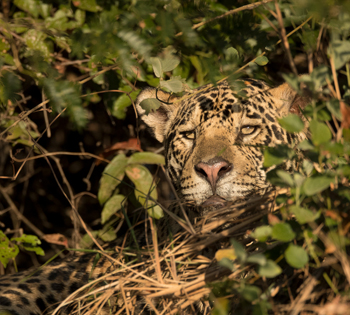 When we arrived, South Wild’s Photo Boat was in position across the narrow channel from a male Jaguar mostly hidden in the vegetation. Its eyes and snout was visible through openings in the vegetation, making a nice cryptic scene. After a few yawns the Jaguar stood and started walking along the river bank top, towards us, and making following the cat very easy. Because of the very high shooting profile of the Photo Boat, my boat could parallel that one and shoot below it – from a closer position. Our other two boats were a bit upriver, getting a bit more distant views that were, nonetheless, nice head-on shots. Our Jaguar finally came to rest in a small, very clear opening directly in front of our boat, giving us incredible front-on views. A group of five Giant Otters were chattering away near Mary’s boat, and the group eventually swam by our Jaguar, but did so underwater. Our cat took interest, getting up and jumping through the grasses to follow, but the otters disappeared and our Jaguar settled in what may have been an even better position. Now, reflected light from the channel bounced back onto the cat, giving a nice eye highlight and a golden cast to the cat. Finally, it headed downstream, and at a swampy area turned and disappeared.
When we arrived, South Wild’s Photo Boat was in position across the narrow channel from a male Jaguar mostly hidden in the vegetation. Its eyes and snout was visible through openings in the vegetation, making a nice cryptic scene. After a few yawns the Jaguar stood and started walking along the river bank top, towards us, and making following the cat very easy. Because of the very high shooting profile of the Photo Boat, my boat could parallel that one and shoot below it – from a closer position. Our other two boats were a bit upriver, getting a bit more distant views that were, nonetheless, nice head-on shots. Our Jaguar finally came to rest in a small, very clear opening directly in front of our boat, giving us incredible front-on views. A group of five Giant Otters were chattering away near Mary’s boat, and the group eventually swam by our Jaguar, but did so underwater. Our cat took interest, getting up and jumping through the grasses to follow, but the otters disappeared and our Jaguar settled in what may have been an even better position. Now, reflected light from the channel bounced back onto the cat, giving a nice eye highlight and a golden cast to the cat. Finally, it headed downstream, and at a swampy area turned and disappeared.
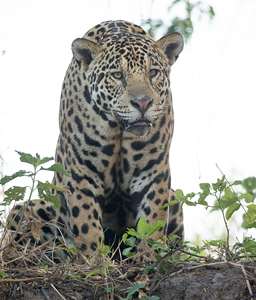
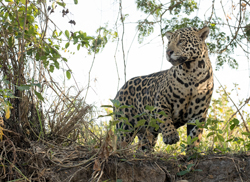
We found it a few minutes later, after a cruise to the end of the channel, but the cat moved off and, after our first experience, this one was nothing. Mary headed back to the Black Lagoon, and later she had a Jaguar that swam and hunted, going from the entrance of the lagoon into the Cuiaba. Accordingly, she was the last boat to arrive – an hour late! We were eating lunch, and our departure wasn’t until later so there was no problem in a late arrival, especially for the potential of a hunting Jaguar.
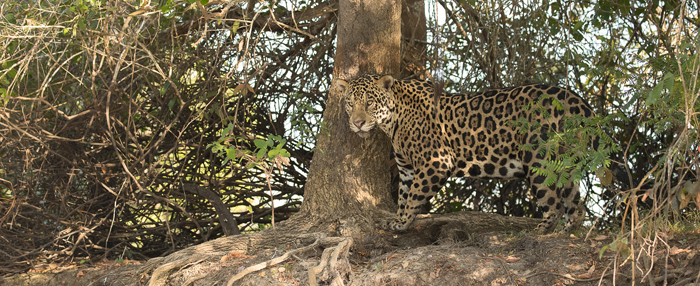
Meanwhile, we had a radio call of another Jaguar, on the Cuiaba. When we arrived the Jaguar was lying on a sand bank and, while we watched, another Jaguar, a male, was spotted directly opposite our female cat, on the other side of the river. A family of Capybaras with one tiny baby were just upstream from our Jaguar, and their attention was riveted upon the walking cat far on the other side. Our cat finally got up and started walking towards the Capybaras, and eventually saw them. The distance was only thirty yards or so, but thick grassy vegetation separated the two. At one point our cat craned her neck high, looking at the rodents, but her prey didn’t spot her.
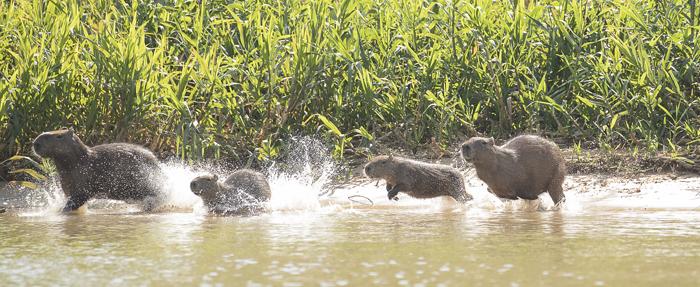
We kept focus on the Capybaras, watching as the baby wandered about, sometimes putting its mother between her and the water. Finally, the cat charged, and the Capybaras exploded into flight, and in three frames or so everything was obscured by a wall of splashing water. In that same motor drive sequence the Jaguar smashed into the water, creating another big splash, but nothing was visible. When the water settled – still in the 12fps sequence – the cat reappeared, without prey.
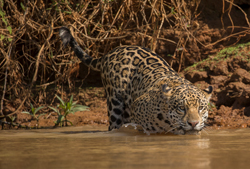 We followed the cat for another half hour or so as it moved up river, sometimes along the river bank, sometimes wading in shallow sandy bays, and tantalizing us as she walked by, stopped, and then went on – from overhanging trees that would have been perfect for some shots. By 10AM she had moved into the forest and we headed to the Flotel, for an early lunch and transfer to the bus.
We followed the cat for another half hour or so as it moved up river, sometimes along the river bank, sometimes wading in shallow sandy bays, and tantalizing us as she walked by, stopped, and then went on – from overhanging trees that would have been perfect for some shots. By 10AM she had moved into the forest and we headed to the Flotel, for an early lunch and transfer to the bus.
PM. We arrived at Santa Theresa by 3, but kept the afternoon free for people to relax or shoot. At 7:30PM we did a night game drive, with a bright full moon, and as Marcos had predicted, there was little activity. A Great Horned Owl in flight, a couple of Nightjars …. That was it, and we returned by 9PM, very dusty from the ride.
Day 10, August 8, 2017
Everyone was out by 6AM for birds or landscapes. I walked a quarter mile up the road to frame various epe’ trees, now resplendent with pink blossoms. These trees generally flower in early August and for the last several years we’ve been here too late, so this was a treat.
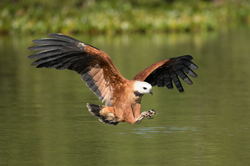
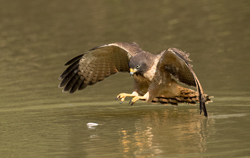
At 7:30 we did a cruise, targeting Ringed Kingfishers and Black-collared Hawks. We had multiple passes with the Kingfishers, and although it seemed like we were getting nothing we actually did fairly well. Our 4 passes with the Hawks produced success as well. Oddly, there were no Great Black Hawks on the river, but a Roadside Hawk snatched fish three different times. By 10:30 the group was hot and ready to call it for the morning and we headed back.
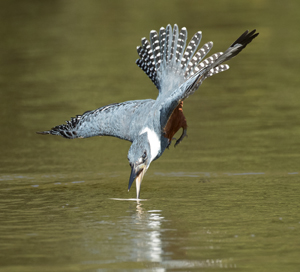
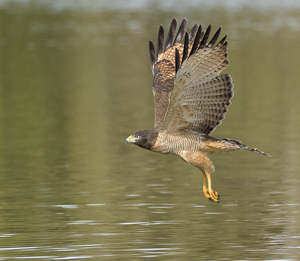
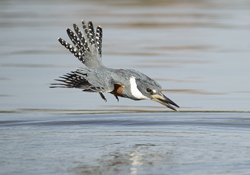
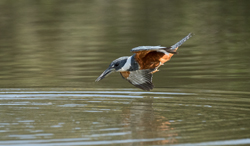
When we arrived, I jokingly asked if anyone wanted to go for a jungle hike – no one did, but I did go out, carrying a 7D with the Rogue Safari flash attachment. 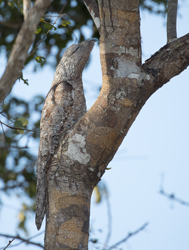 Although the hike in was hot, in the forest it was bearable, and soon after entering, about 5 minutes passed the Ocelot setup, I had a troop of Brown Capuchin Monkeys come investigate me. With the camera rig I was using it was easy to maneuver and I got some very nice shots. I made it back by lunch, and offered to take folks back to the monkeys afterwards, but the heat is fairly discouraging and I had no takers. Still … there were great monkey shots to be had!
Although the hike in was hot, in the forest it was bearable, and soon after entering, about 5 minutes passed the Ocelot setup, I had a troop of Brown Capuchin Monkeys come investigate me. With the camera rig I was using it was easy to maneuver and I got some very nice shots. I made it back by lunch, and offered to take folks back to the monkeys afterwards, but the heat is fairly discouraging and I had no takers. Still … there were great monkey shots to be had!
PM. We left at 3:30PM, with the temperature at close to 100. We headed downriver, hoping to find an Agami Heron, a strikingly colorful heron that stays deep in riverside vegetation. I spotted one – it was so dark that only its very long (longer in proportion to other Herons) bill gave it away. There were no shots.
We did have, however, all five Kingfishers. The Pigmy Kingfisher was especially 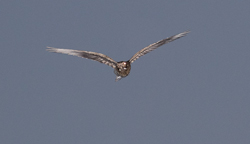 cooperative, flying to a branch along the river’s edge, and with flash the images still looked quite natural. On our cruise back we had several large flocks of Egrets, both Snowy and Cattle, that, unfortunately, took off at our approach. Hopefully they’ll return to the roost after we passed. We finished the day shooting Nightjars with flash, as they soared quickly overhead. Talk about a challenge!
cooperative, flying to a branch along the river’s edge, and with flash the images still looked quite natural. On our cruise back we had several large flocks of Egrets, both Snowy and Cattle, that, unfortunately, took off at our approach. Hopefully they’ll return to the roost after we passed. We finished the day shooting Nightjars with flash, as they soared quickly overhead. Talk about a challenge!
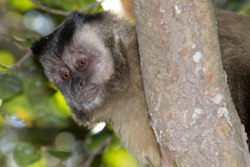
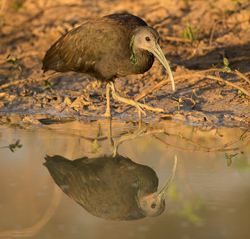
August 9, 2017
We left at 6AM for the group, and Mary, to return to Cuiaba and their flights home while I was dropped off at Pueso Allegre where I’d meet my next group in two days. I did some filming around the lodge and took several bike rides, with camera, out along the road but had a fairly relaxing day.
August 10, 2017
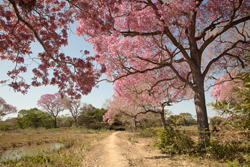 After a sunrise shoot where I photographed Snail Kites and blooming epe’ trees and breakfast, I decided to ride a bicycle to the ‘hide’ at the waterhole. There I did some voice-over narrations for the video, while spotting a Tamandua and several Capuchin Monkeys. At 11:30, with only 1 water remaining, I started back in the heat, and on the sloggy sandy road I had to walk the bike for the first third of the trip back. By the time I reached the lodge I was out of water, and fried, worried a bit about heat stroke. After about a gallon of water and a cold shower I recovered.
After a sunrise shoot where I photographed Snail Kites and blooming epe’ trees and breakfast, I decided to ride a bicycle to the ‘hide’ at the waterhole. There I did some voice-over narrations for the video, while spotting a Tamandua and several Capuchin Monkeys. At 11:30, with only 1 water remaining, I started back in the heat, and on the sloggy sandy road I had to walk the bike for the first third of the trip back. By the time I reached the lodge I was out of water, and fried, worried a bit about heat stroke. After about a gallon of water and a cold shower I recovered.
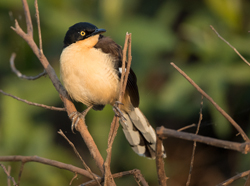 In the afternoon, once the heat broke, I went back to the boardwalk spanning a swamp to try a Range IR setup, hoping that an Ocelot or a Puma might use the bridge for easy travel. I was woefully unprepared, and had to return – via bike and only a third of a mile trip – twice to get either AA batteries, a camera battery, or a CF card! Duh!
In the afternoon, once the heat broke, I went back to the boardwalk spanning a swamp to try a Range IR setup, hoping that an Ocelot or a Puma might use the bridge for easy travel. I was woefully unprepared, and had to return – via bike and only a third of a mile trip – twice to get either AA batteries, a camera battery, or a CF card! Duh!
I completed the setup right at dusk, with mosquitos gathering, but everything was working. That evening, by the dining area, I photographed a Ferruginous Pigmy Owl that hangs out, catching mole crickets attracted by the light.
August 11, 2017
My group was supposed to arrive by mid-afternoon but flight delays had them miss a flight, and so they arrived at 4PM in Cuiaba, and they would not arrive at PA until after 9PM. At sunrise I photographed more epe’ trees and birds, and after breakfast more voice-overs in a forest, where I also taped ambient sounds. At that point I did not know the group wouldn’t arrive until late, and so I had planned to relax until they reached PA.
After lunch, however, I learned the news and at that point I really thought I’d have a quiet, peaceful afternoon. But then I met a nice German couple who, upon learning I did not have a vehicle, invited me to join them on an excursion. I accepted.
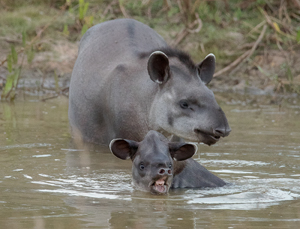 As we started out at 3:30PM I asked them what they’d like to see, and they hoped to see a Tapir. Coordinating with one of my former guides, Raphael, who was leading a rude birding group, we headed to the ‘hide’ first, as their noisy and impatient group would be there later. I took the couple into the forest where I’d see the Tamandua, and had great views of Capuchin Monkeys and a Brocket Deer. When we exited, and despite our leaf-crunching noise in the forest, a Tapir was in the pond!
As we started out at 3:30PM I asked them what they’d like to see, and they hoped to see a Tapir. Coordinating with one of my former guides, Raphael, who was leading a rude birding group, we headed to the ‘hide’ first, as their noisy and impatient group would be there later. I took the couple into the forest where I’d see the Tamandua, and had great views of Capuchin Monkeys and a Brocket Deer. When we exited, and despite our leaf-crunching noise in the forest, a Tapir was in the pond!
Eventually we got great shots of the Tapir, both in the pond and in the forest. Afterwards, we looked for Tamanduas, before heading to the main road to a spot where a mother Tapir and baby was supposed to frequent. We found the pair, in a pool near the road, playing in the water. The baby would often be completely submerged, with the mother’s head underwater, presumably pushing and butting the baby. This continued for ten minutes or so, as the pair moved about the pond. Finally the mother exited and bolted, and the baby raced after and passed her – again, in obvious play. We were ecstatic.
At 9:39 my next group arrived, exhausted from a miserable day of travel. Tomorrow, however, we’re leaving at 6AM for the Flotel!
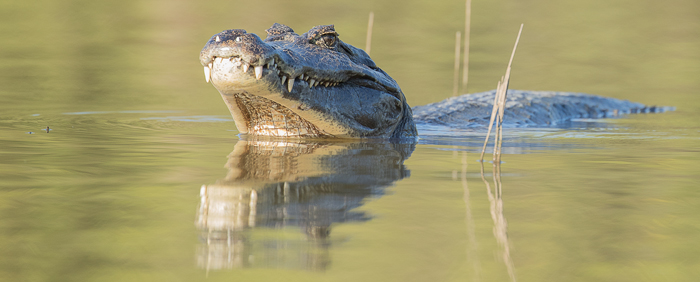
 Caiman eyes after dark
Caiman eyes after dark
Trip Two
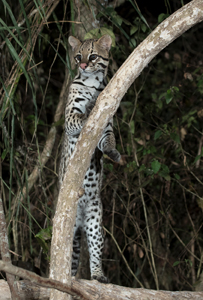 For our second trip in August I was pleased to have the opportunity to do something I rarely do -- I guided a private group, this time a family. Because this was an entirely different trip than our normal, I didn't keep a day-to-day journal. That said, our wildlife and photography experiences were still incredibly rich, and in fact it was one of the most productive shoots I've ever had in the Pantanal -- quite possibly the best-ever Jaguar experience.
For our second trip in August I was pleased to have the opportunity to do something I rarely do -- I guided a private group, this time a family. Because this was an entirely different trip than our normal, I didn't keep a day-to-day journal. That said, our wildlife and photography experiences were still incredibly rich, and in fact it was one of the most productive shoots I've ever had in the Pantanal -- quite possibly the best-ever Jaguar experience.
What was absolutely particularly gratifying to me was several members of the family really wanted to learn photographym, and not just take pictures. Accordingly, they learned, and mastered, Manual Mode - Spot Metering, for making their exposures.That, to me, was one of the true highlights of the trip -- and really underscores what I've often written in our brochures -- and that is, take our Nature Photo Course where we teach exposure and the craft of photography.
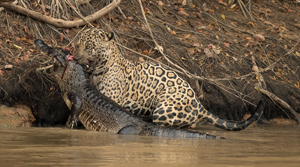
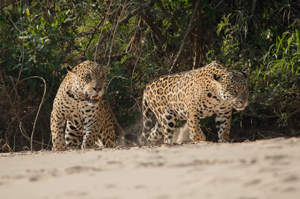
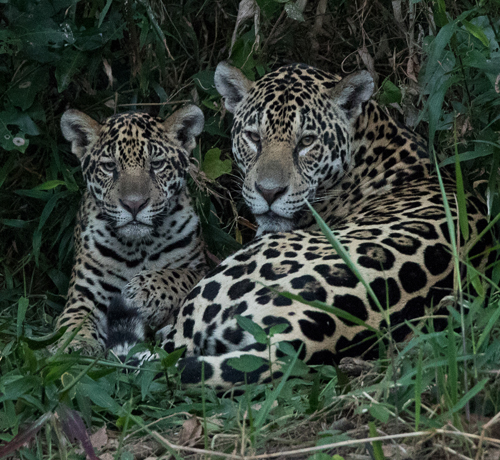
However, we had incredible wildlife hightlights, especially with Jaguars. This included the first time I've had a chance to photograph a mother Jaguar and her cub. I've seen Jaguars a few times with Caimans, and witnessed some distant captures and kills, but on this special trip we had an incredible photo session with a male Jaguar in the end-stages of killing a large Caiman, then dragging it through the water until it finally dragged it ashore. There, instead of straddling the Caiman and walking upward, the Jaguar grabbed the Caiman and dragged it, backwards, until the cat and its prey finally disappeared into the forest.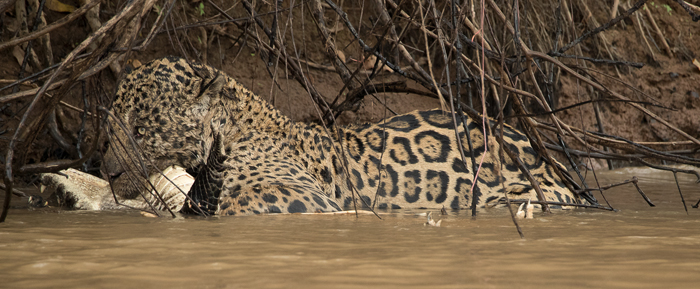
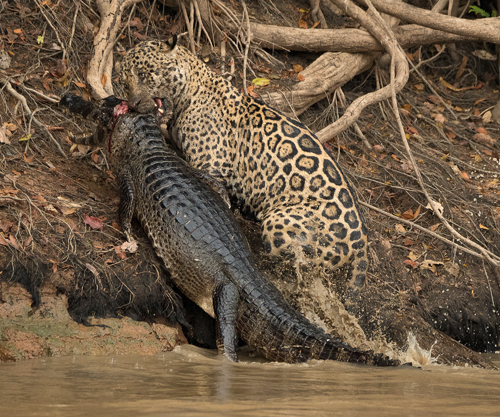
That was an incredible sight, and a wonderful experience, although the moment was spoiled somewhat when a guide in another boat started shouting 'Bravo, bravo!' And then continued, saying 'where is the popcorn for this show.' It was gratingly inappropriate after such a special moment and drama in the life of a Jaguar. Oh well.
On our very last boat cruise in Jaguarland, I finally got a shot I've lusted for since I've been visiting the Pantanal, and that was getting a Jaguar on a riverside log. We were following a cat as it hunted the shoreline, and watched with some frustration as the cat by-passed several trees. Most had their access blocked by thick vegetation, but the cat continued, and so did we, and finally the Jaguar encountered an open log. The Jaguar climbed down the bank and onto the log, where it paused, and looked up the river. I had cautioned all of my groups that if we had this type of opportunity to be sure not to frame in tight and simply shoot a portrait. That's the natural impulse. Luckily, I followed my own advice and kept my lens zoomed out to incorporate the whole scene, which lasted only a minute or so before the Jaguar returned to the bank and continued its hunt.
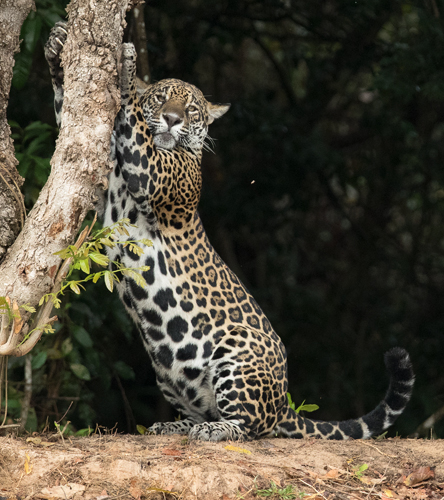
A few minutes later the Jaguar did another behavior I've not seen, and that was standing and scratching a tree. I've seen Tigers and Leopards do so, but I'd not seen a Jaguar do so, and this one was special as the background was the dark understory of the riverine forest. To their credit, the family shooters who were using Manual Mode metered this potentially challenging (and possibly program-mode defeating) lighting situation perfectly. Finally, we had a final near first-time shoot - as a large Caiman was lying along a bank. Unfortunately vegetation obscured the reptile from the passing Jaguar, who continued beyond the Caiman, never knowing it was there. With that, the Jaguar reached thick vegetation lining the river and we lost her, and with that we returned to the Flotel and lunch, before heading to our final destination.
For only the second time ever, we also had a great shooting opportunity to photograph a Jaguar pair mating. The female had just come into heat and she was frisky, and in only one hour the pair mated four times.
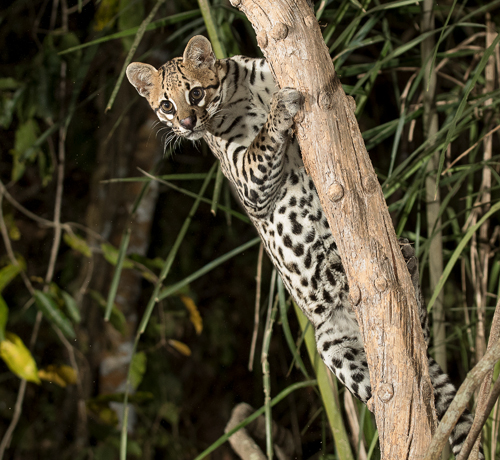
There were other great highlights of course. This included to visits to the Ocelot blind where we had success both nights. In fact, on our first night we had two ocelots climbing through the vines at the same time. Watching this acrobatic cat, sometimes hanging upside down on a vine or limb, or descending headfirst, or prowling the grounds below -- it was an incredible treat.
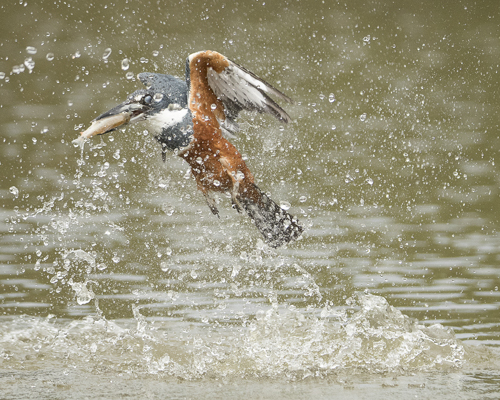
On our river cruises we had great luck with Ringed, Amazon, Green, and Pigmy Kingfishers, and on our last night of shooting one of the best photo ops we've ever had with the rare, elusive, and most beautiful of all the herons, the Agama Heron.
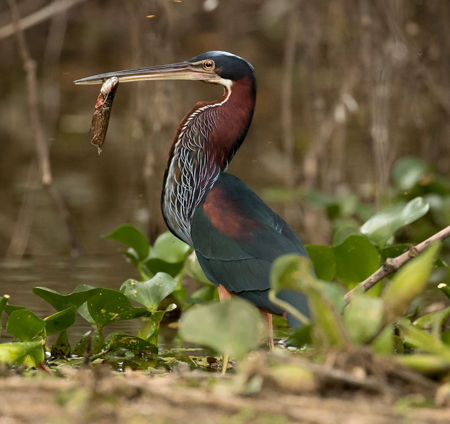
So, although I didn't keep a day-by-day journal, the memories are vivid, and the photos were great. In three weeks Mary and I will be returning to the Pantanal for our last Jaguar trip of the year, and Mary is especially excited because she missed this special trip. Instead, Mary was in Alaska leading the Coastal Bear Photo Tour trip that we had originally planned for that time. Like me, however, she had an incredible time ... as her Trip Report will show.
Here's one of the journal entries, from the first day of the family trip:
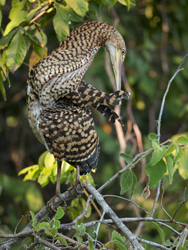 Day 1, August 12, 2017.
Day 1, August 12, 2017.
I’m here with a wonderful family, two boys, ages 18 and 15, and a girl 12, and the keen photography parents. We left PA at 6, but stopped repeated along the road in PA for epe’ tree landscapes, bubble-dancing Caimans (the most active I’ve seen this year) and birds. We didn’t reach the main road until nearly 7:30, but from there we made great time as we headed down the Transpantanera highway to Porto Joffre. By 10:30 we were there, met our boat, and headed upriver.
2PM: We left for our first cruise, in very hot conditions. We stopped at a sandbar for Buff-necked Ibis, Southern Lapwings, and Black Vultures, and then continued to the Cuiaba where I spotted a Jaguar in the distance on a sand bar. It walked to us, crossing the shallows for a wonderful scenic, right to us before disappearing in the brush.
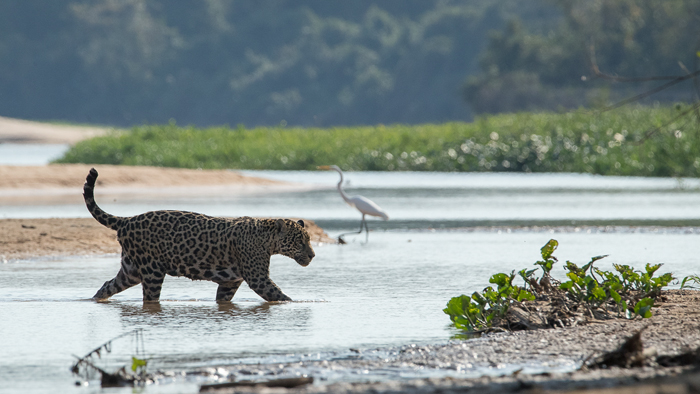
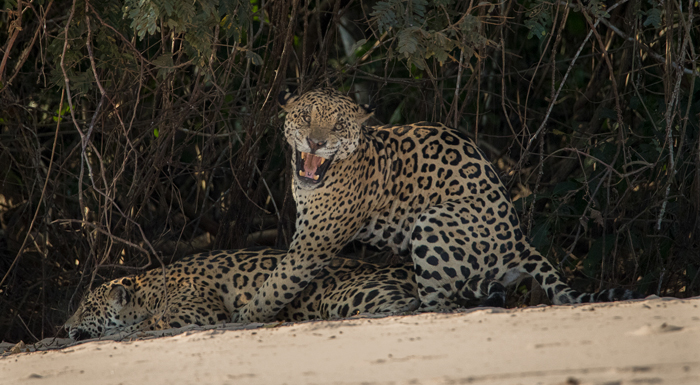
Another radio call had us racing to a mating Jaguar pair only a mile or so upriver. Two Jaguars lay on the beach in plain view. The female must have just come into heat because they mated four times in one hour, and probably twice more in the next hour. In each case, the female initiated it by moving towards the male, then obviously presenting herself in a mating posture. The male would bite her neck, then hop off, but the female never swatted – she just kept her head tilted down and, after he jumped off, would roll onto her belly. A few times the cats 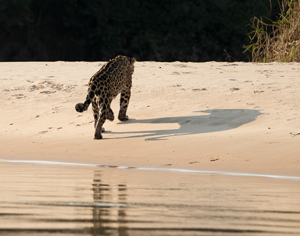 disappeared into the undergrowth but would return, and in the last soft light of the day the two lay on the beach for several minutes. The female was quite close to the water but the male seemed reluctant, and would only move halfway onto the beach before losing his nerve and retreating. Eventually the female would return to him. We finished as the sun was setting and headed home, where en route Marcos spotted two Jaguars – one ran off, while the male remained by the shoreline, but too dark for any real shots. Oddly, this male was richly patterned, more like a Leopard than a Jaguar, while the female we had earlier in the afternoon had enormous rosettes – a classic Jaguar pattern. We reached the lodge at 5:50.
disappeared into the undergrowth but would return, and in the last soft light of the day the two lay on the beach for several minutes. The female was quite close to the water but the male seemed reluctant, and would only move halfway onto the beach before losing his nerve and retreating. Eventually the female would return to him. We finished as the sun was setting and headed home, where en route Marcos spotted two Jaguars – one ran off, while the male remained by the shoreline, but too dark for any real shots. Oddly, this male was richly patterned, more like a Leopard than a Jaguar, while the female we had earlier in the afternoon had enormous rosettes – a classic Jaguar pattern. We reached the lodge at 5:50.
A Word on the Lenses
Because I bought an 800mm for Snow Leopards, I vowed I'd use it often on other shoots, so I brought it to the Pantanal. Tamron had sent me a 150-600 to try out, so between Mary and I we had an 800, 500, 150-600, and 100-400 for our telephotos. Mary and I took turns trying the 150-600, with Mary using the 500, and me the 800, when the other was using the Tamron zoom.
Although I was very impressed with the lens, I wasn't totally sure it was sharp since I was using my laptop. Should have been, but I wasn't going to make a final judgement until I checked out images at 100% on my desktop too. Nonetheless, we loved the lens so much that when Mary went to Alaska, she had a brand-new Tamron 150-600 waiting for her -- we bought one as soon as she got home.
Well, after checking out the images on both computer screens, I can honestly say I love the lens. The price is great -- I'm now seriously considering selling my Canon 200-400 and my 800mm, really! Anyone interested?
Also, I shot a lot of images at very high ISOs, for some low light situations and also to stop action. At one point, we had a Jaguar in near-dark conditions, minutes before dusk turned to night, and I shot a Jaguar at ISO 40,000 with my Canon 1DX Mark II. While the noise may be an issue -- I caught the shot. I also did the mother Jaguar with cub at ISO 10,000 - results are here.
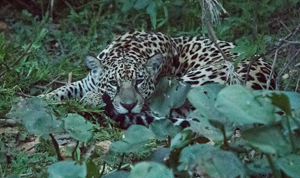
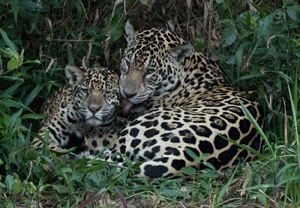
On left, ISO 40,000, and the Mother and cub, ISO 10,000
both were shot with the Tamron 150-600.
Here's comparison shots of a Black-collared Hawk flying right at the camera. If you've done flight shots like this, you know how difficult it can be for a camera or lens to keep up with the subject flying right at you. I love my 100-400, and I think it is an incredibly sharp lens, and the shot is sharp, and at ISO 1,600.
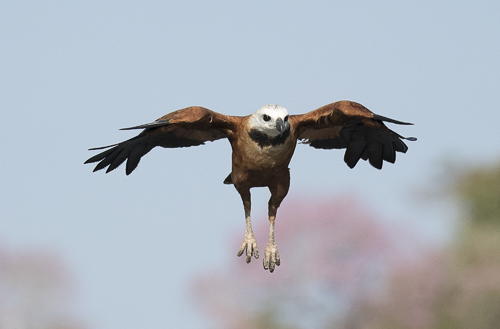
Canon 100-400
The shot below was made at ISO 3,200, and it, too, is very sharp. It is not quite as crisp as the one done at ISO 1,600 but that's a function of the ISO, not the lens. The important thing here is the lens focused fast and accurately.
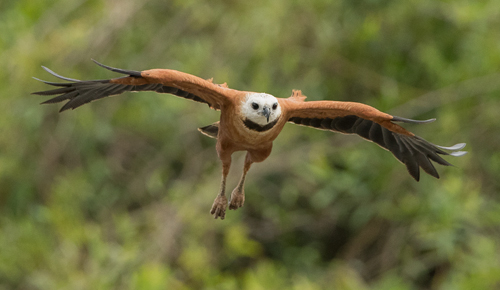
Tamron 150-600
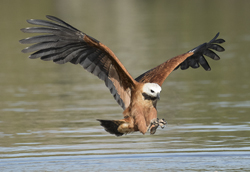
Canon 100-400

Tamron 150-600 Cropped - but see the detail for a bird in flight!
This heron was shot at ISO 2,500 -- and in the original the entire heron is within the frame and occupies about half the image. The lens was zoomed to 300, and followed the subject accurately.
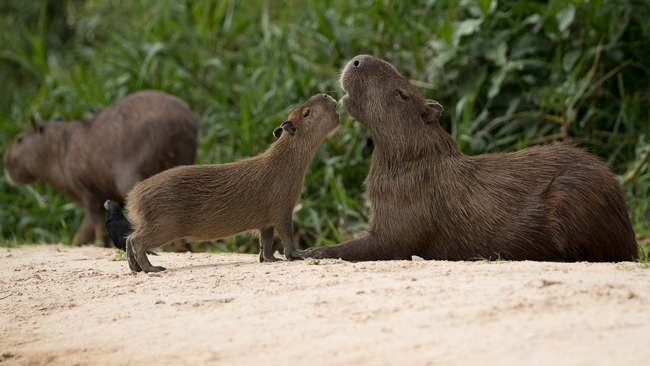
One of my favorite shots of a Capybara occured when the rodents panicked and ran towards the river, probably fearing for a Jaguar. The mother had a mouthful of vegetation when she ran, and after she settled her baby started feeding on the grasses, appearing to be kissing mom. 300mm, ISO 1250, Tamron 150-600.
Here's a Golden-naped Macaw with the Tamron at 600mm - sharp! And a Coqui Heron at 400.
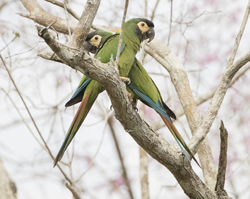
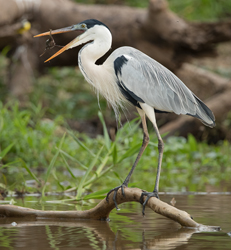
Here's a shot where I followed a Black Vulture in flight - at 552mm.
And here's a swimming otter at 250 - all with the Tamron.
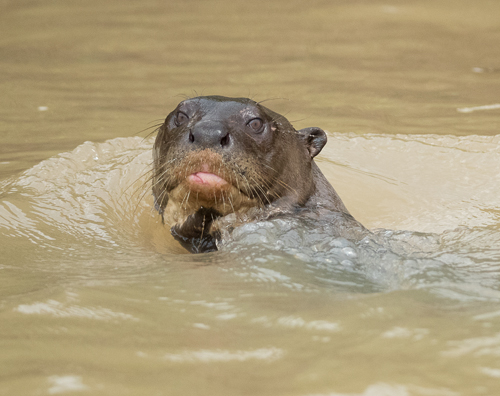
Finally, a shot at 552mm of a very unusual behavior - a Black Vulture preening and grooming a Crested Caracara. In Texas, my friend Cindy Marple photographed a Caracara grooming a Vulture, the first time I'd ever heard of this. Apparently this behavior is not too uncommon, but it sure is novel!
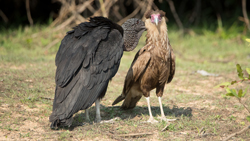
In three weeks we'll be returning to the Pantanal for another Photo Tour, and next year - 2018 - we'll be doing at least two Photo Tours here. Join us ... it is one of our favorite locations. Check out the brochure!
Read ALL of our Pantanal Trip Reports
Join us on Facebook at: Follow Hoot Hollow
Office Phone: (717) 543-6423
Or FAX us at: (717) 543-5342
Mary and Joe are proud to endorse the Photo Retailer that has
done the absolute most in supporting nature photography in all
its facets ---

Check out their Monthly Specials

The Pantanal 2017
This summer Mary and I had a special treat, as we were asked to do private Photo Tours to the Pantanal, one of our all-time favorite destinations. Almost ten years ago two friends and I were the pioneers in doing Jaguar tourism here -- via our great outfitter, of course, and on that first trip there was only one other boat looking for Jaguars, and that boat was via that same outfitter. Over the years, probably as much because of our trip reports broadcasting the incredible shooting, Jaguar tourism has flourished, and for a few years it was getting chaotic, crazy, and borderline distasteful. If things weren't done, the area would be ruined.

Well, I'm happy to report that I have never been so pleased with the operation as I was this year. Boatmen and guides behaved wonderfully, cooperating with one another and not playing a stupid cut-you-off-screw you- attitude. So the shooting was very pleasant BUT...

The shooting was also INCREDIBLE. We had two extremely productive trips. Our first involved a serious group of photographers we met at a camera club conference where we were speakers. Our second group was a family, with teenage boys and girls that were a joy to be with. The luck we had ... it could hardly have been better.
 Highlights between the two trips included a Jaguar climbing a tree (a first!), Jaguars mating in the open (Several firsts), an incredible Caiman kill by a Jaguar, a Capybara kill, a Jaguar on a riverside log (my dream shot), and scores of other shots. Read on and you'll see ...
Highlights between the two trips included a Jaguar climbing a tree (a first!), Jaguars mating in the open (Several firsts), an incredible Caiman kill by a Jaguar, a Capybara kill, a Jaguar on a riverside log (my dream shot), and scores of other shots. Read on and you'll see ...
The only good thing is in just three weeks we'll be back again with our 'regular' Photo Tour. Otherwise, I'd be going crazy waiting until next year. Speaking of which, we're doing TWO trips next year .. Join Us, it is incredible!.
Join us in 2018 - we will be doing at least two Photo Tours. Read the Brochure.
Trip One
Day One, July 29th.
We met the group at the Marriot Hotel lobby at 6:30PM, everyone having arrived safely and with their luggage. Mary and I were pleasantly surprised to find ourselves upgraded to Business Class on the flight down – a 9 hour flight that allowed us to stretch out and be comfortable. We did a brief orientation, had dinner, and a reasonably early bedtime, ready to begin the adventure.
Day 2, July 30th.
We left the Marriot at 7:30AM, again fortunate not to have other passengers crowding the bus and potentially creating an issue. Again, we were upgraded, which in this case gave everyone in our group to cluster behind us in line and board the plane first. The flight was uneventful and comfortable, and in Cuiaba we met Marcos, my friend and guide for the past six years. Lunch was at the restaurant we’ve used for years, but it has now been upgraded to a Brazilian barbeque alcedo, with skewers of meat constantly presented, and deliciously cooked. We all ate too much. The drive into the Pantanal provided some opportunities for seeing distant Red-legged Seremias, Greater Rheas, and a large variety to the usual, roadside birds. It was a productive drive.
Just returned from our afternoon/evening game drive, an unexpected bonus on our first day in the Pantanal. Normally, because of flight schedules we do not arrive at one of our lodges until near or after sunset, but today we reached Pueso Allegre by 3:45. At 4 Pm we met our group, all primed and ready for an orientation around the grounds. With enough light to make a drive by our truck/safari vehicle worthwhile we changed plans and headed out for a game drive, a good breaking in for the group and what to expect. It was a productive afternoon.
 We headed out on to the main game track, then headed more into the brush country and where, in years past, we’ve filmed Giant Anteaters, Tapirs, Tayras, and birds. We didn’t expect much, as this was a reccie, but our drive still produced a lot of good subjects. They included Snail Kites, Egrets, and some landscapes – for shooting, but a lot of birds and wildlife for identification and familiarity – including Great Black Hawks, Savannah Hawks, Roadside Hawks, Crested Caracara,
We headed out on to the main game track, then headed more into the brush country and where, in years past, we’ve filmed Giant Anteaters, Tapirs, Tayras, and birds. We didn’t expect much, as this was a reccie, but our drive still produced a lot of good subjects. They included Snail Kites, Egrets, and some landscapes – for shooting, but a lot of birds and wildlife for identification and familiarity – including Great Black Hawks, Savannah Hawks, Roadside Hawks, Crested Caracara,  Jabiru Stork, Whistling, Coqui, Black-crowned Night, Capped, and Striated Herons, Green and Plumbeous Ibis, and several songbirds.
Jabiru Stork, Whistling, Coqui, Black-crowned Night, Capped, and Striated Herons, Green and Plumbeous Ibis, and several songbirds.
I was hoping to spot a Tamandua or Giant Anteater but we had no luck. At sunset we were treated to a nice sky but an anchoring foreground was lacking, although we still shot the brilliant colors. We returned to the lodge by 5:45, the sun already set.
Day 3, July 31, 2017
Marcos, our guide, has boundless energy and was anxious for us to do a pre-dawn game drive, the best time to encounter nocturnal animals still roaming the Pantanal. We left at 4:45, 45 minutes or so before sunrise, and the early departure was worth it. Soon after leaving the lodge we had an Ocelot that stayed in view for several minutes, seemingly oblivious to us or the spotlight as the Ocelot walked a game trail and finally meandered out of sight. For Suzanne and Kim the cat was their morning highlight.
We continued on, stopping for numerous birds and several Red Brocket Deer, a small species that inhabits forests and resembles an African Duiker antelope. This similarity was reinforced with a view of one male, its antlers are mere spikes which, on a Duiker, would be horns. Brocket Deer are somewhat pear-shaped, as are the forest-dwelling Agouti, a rodent, designed for squeezing through the undergrowth.

 At the same pool where, yesterday afternoon, we had a Capped Heron and a Sunbittern, we again had the latter, which eventually captured a large Giant Waterbug. The wildlife watching and the birding and the shooting was so good that we didn’t return for breakfast until 8:15, and soon after eating we headed back out.
At the same pool where, yesterday afternoon, we had a Capped Heron and a Sunbittern, we again had the latter, which eventually captured a large Giant Waterbug. The wildlife watching and the birding and the shooting was so good that we didn’t return for breakfast until 8:15, and soon after eating we headed back out.
Our post-breakfast game drive took us to a large roadside pool where Large-billed Terns soared, swooped, and fished; Yacare’ Caimans gathered in huge numbers, and the occasional Black-crowned Night Heron or Snail Kite flew by.

The other great highlight for the morning was a Lesser Anteater or Tamandua that Marcos spotted when we stopped en route to a Roseate Spoonbill nesting colony. The Anteater was en route between forest hammocks and although we intercepted its route the Anteater never stood up defensively and, when we had some shots, continued on his way to another hammock. The Spoonbills were not very satisfying, as birds were not on the nest and flew off at our approach. While we photographed around the nearby pond birds returned, but the light was high and presented no worthwhile shots.
PM. At 4PM we headed out, with finding a nicely isolated tree for a sunset shot the main priority. We found two – on the same route we were on for the Spoonbills. As we explored possibilities we found a flock of well-camouflaged Nacunda Nightjars, the largest species of nighthawk or nightjar (same thing, a Goatsucker). Phil got an outstanding shot of one flying by, parallel to him, but Becky and my luck wasn’t as good – all I managed were tail-end views.
After locating a tree we continued on, stopping for a cooperative Southern Lapwing and a nice view of distant, acrobatic Howler Monkeys – several leaping from tree to tree, before returning to the sunset tree where we finished the day with some scenic shots.
August 1, Day 4. Pueso Allegre to Santa Theresa Lodge
 We stayed around the grounds for our pre-breakfast and post-breakfast shooting, with our group somewhat scattered about, principally looking for Hyacinth Macaws. Mary and I, separately, had headed down the main lodge road, where – just minutes after leaving my room – I had the most cooperative Green Ibis I’ve ever had. After breakfast we worked on Hyacinth Macaws and Turquoise-fronted Parrots.
We stayed around the grounds for our pre-breakfast and post-breakfast shooting, with our group somewhat scattered about, principally looking for Hyacinth Macaws. Mary and I, separately, had headed down the main lodge road, where – just minutes after leaving my room – I had the most cooperative Green Ibis I’ve ever had. After breakfast we worked on Hyacinth Macaws and Turquoise-fronted Parrots.

Several Black and White Tegus had crawled out from the shed where they spent the night and sunned. Marcos got a few eggs and these hen-house raiders avidly snatched up the eggs that were tossed their way. Male Tegus have an almost ruff-like neck, a big swelling that reminded me of a bull elephant seal. Females are slender and stream-lined, and both were present. After the egg-eating, one of the males seemed interested in a female and so I remained, filming the male as he followed the female, very much like a snake courts a female. He hitched himself along, rubbing his chin against her tail and moving upwards to her hips, finally coming to rest with one foreleg draped over her back.
The female invariably moved off, and the male would circle about, finally returning to her tail and repeating the process. Twice, a smaller male appeared and came close, and the first time this occurred the male left the female and charged after his potential rival. The second time, another male circled about as the couple lay entwined, but the male did nothing. Finally, the female slipped from beneath him and walked off, within only a few yards of the other male. About ten seconds later the original male moved, following the female and then grabbing her in a bite around the neck. Seconds later they entwined in a big U, with the male’s tail held high, and they mated. The coupling lasted about thirty seconds, when with a jerk they disengaged and both lizards went their separate ways. I videoed the entire sequence.
At 10:15 we left for ST, arriving around 11:45. At 1, Mary, Marcos, and I headed out to the Ocelot blind to set up flashes. The setup this year is completely different from last, being much more diverse and photogenic, however the foreground was given little thought, and obstructing vines block views. I used some cord to tie back a vine, but I’d have far preferred to have permission to trim the vines back as they played no role. I had planned to use makeshift lightstands out of bamboo I lashed into tripods, but the ground was too solid and hard and, instead, I ended up strapping the flashes to tree limbs. An hour after started we were set up and ready for the evening.
 We were scheduled to do a boat ride at 3:30, and around 3:15 a buck Marsh Deer and two does came down to a pond that is now invisible from the road. No one except me was interested in checking it out, and when I fired a motor drive all three grew alarmed, with the two does running to opposite ends of the pond. After several minutes of quiet the deer relaxed, but just then Mary called for me to come to the boat – an unnecessary move as the boatmen were still ten minutes late!
We were scheduled to do a boat ride at 3:30, and around 3:15 a buck Marsh Deer and two does came down to a pond that is now invisible from the road. No one except me was interested in checking it out, and when I fired a motor drive all three grew alarmed, with the two does running to opposite ends of the pond. After several minutes of quiet the deer relaxed, but just then Mary called for me to come to the boat – an unnecessary move as the boatmen were still ten minutes late!
The boat ride was fairly successful, with one good pass with a Black-collared Hawk and several with Ringed Kingfishers. For the first time we had a Roadside Hawk also swooping down for a fish, as did a Yellow-headed Caracara. Everyone got something, but I must admit my timing, or my focus, was just terrible and I missed almost all the Kingfisher dives – sometimes being out of focus by just an inch or so!
 At 7PM, right after dinner, we headed to the Ocelot blind. Mary and I arrived a few minutes early to turn on the flashes and transmitters and receivers, but the group arrived just as we finished. An Ocelot, hungry and anxious, sat only a few yards from Mary as she stood by the bait station, as I checked the flash exposures. Within ten minutes of our settling in the Ocelot returned and put on a show. After three re-baitings we were out of meat, just as another, even larger Ocelot arrived. Our first Ocelot yeowed her complaints and, finding no food, the new cat, a male, followed her into the brush. We packed up and were back at the lodge by 8:40.
At 7PM, right after dinner, we headed to the Ocelot blind. Mary and I arrived a few minutes early to turn on the flashes and transmitters and receivers, but the group arrived just as we finished. An Ocelot, hungry and anxious, sat only a few yards from Mary as she stood by the bait station, as I checked the flash exposures. Within ten minutes of our settling in the Ocelot returned and put on a show. After three re-baitings we were out of meat, just as another, even larger Ocelot arrived. Our first Ocelot yeowed her complaints and, finding no food, the new cat, a male, followed her into the brush. We packed up and were back at the lodge by 8:40.
August 2, Day 5.
The group did some shooting before breakfast, of Toco Toucans, songbirds, and for Phil and Ellen, the scaffold tower for the Jabiru Stork nest. We left the lodge around 8:30 for the drive to Porto Joffre, arriving around 11:05 where we met our boats for the cruise up the Cuiaba River and the Flotel, in Jaguarland. After a brief orientation on arriving, we had lunch and unpacked for a 2PM departure for a game drive/cruise.
 Almost immediately, my boatman, John, spotted a Neotropical Otter, the rarer of the two species found here, grooming itself on a riverside log. We tried to get into position but the Otter slipped into the water and disappeared. Mary, with Ellen and Phil, stopped along a sandbank for a Pied Plover and Capybara, while we continued, finding three Giant Otters in the beginning of the Black Lagoon. They were exceptionally tame, grooming themselves on a log in good light, and we had them for nearly a half hour. We continued up the lagoon, but were called away for a Jaguar sighting, back up the Three Brothers River.
Almost immediately, my boatman, John, spotted a Neotropical Otter, the rarer of the two species found here, grooming itself on a riverside log. We tried to get into position but the Otter slipped into the water and disappeared. Mary, with Ellen and Phil, stopped along a sandbank for a Pied Plover and Capybara, while we continued, finding three Giant Otters in the beginning of the Black Lagoon. They were exceptionally tame, grooming themselves on a log in good light, and we had them for nearly a half hour. We continued up the lagoon, but were called away for a Jaguar sighting, back up the Three Brothers River.
Kim and Becky, with Marcos, as well as Mary’s boat did have a brief glimpse of the cat when it stood up and turned around, lying down again about 10 feet into the forest. We missed it. We spent the rest of the afternoon searching for the cat, as periodically it was spotted, but nothing became of the encounter.
 As we headed back towards the Flotel, at 5PM, our boat pulled into the Charles Creek for a final search for jaguars but had no cats, but we did have a great sunset with trees framing the sky, then a Coqui Heron landing and silhouetting nicely against the orange-gold sky. Mary’s vehicle had a dugout w fisherman cruising by for another nice silhouette. We arrived at the boat around 6, as darkness was finally setting in.
As we headed back towards the Flotel, at 5PM, our boat pulled into the Charles Creek for a final search for jaguars but had no cats, but we did have a great sunset with trees framing the sky, then a Coqui Heron landing and silhouetting nicely against the orange-gold sky. Mary’s vehicle had a dugout w fisherman cruising by for another nice silhouette. We arrived at the boat around 6, as darkness was finally setting in.
Day 6, August 3.
Our first full day in Jaguarland, and we started the day at 6, leaving the Flotel to surprisingly cool, or cold, temperatures. Within minutes of cruising we were wearing everything we brought along, and most of us were still cold. The high today was predicted to be 82, and the morning started at 60, but it felt much colder.
My boat headed upriver, eventually arriving at the Black Lagoon. Caimans were not yet in courtship, and our best shooting included perfect reflections of a Caiman and a Wattled Jacana that eventually grabbed a slug from the water hyacinths. That’s when we got our first Jaguar call.
Mary’s boat had gone far upriver on the Piquani, almost to the fishing village, prime territory for Tapirs. On the way back, quite close to the Flotel, they had a family of six Giant Otters feeding on a log. Then, past the Flotel, they spotted a female Jaguar with two cubs, a bit over 18 months old. They were on an open sandbar and they got shots of all three together before the three, in five minutes or so, disappeared back into the brush. Which is when our other two boats arrived – too late!
We continued to the Three Brothers River, and our boat turned into Charles Creek after a short pause at a sandbar where a large flock of Black Skimmers were roosting. At the Charles we received another radio call, and we raced back – right to the Skimmer beach and up the Cuiaba River where, at the far end of the sand bar, a female Jaguar was walking along, then disappeared into the tall river grass.
We followed, catching occasional glimpses of the vegetation moving, but eventually she stepped into the clear for some nice shots. And then she continued upriver, following the bank and providing numerous chances as she stepped out of the brush, or walked along the tall river bank, or slid down into a gulley to walk closer to the edge.

At least 18 boats arrived, but everyone was remarkably cooperative. One boatman was often just behind our boat and was careful not to push forward and block our view. Later, I had a chance to compliment him on his courtesy and professionalism, and later still, he came by again to say he had met me, or seen me, last year when he was driving a Nat’l Geo photographer around. We chatted for a few minutes and again complimented him on his work, and told him he was a great role model that other boatmen should follow. He appreciated the recognition – well deserved!
 At one point our Jaguar seemed to disappear and about half the boats raced upriver where another Jaguar was spotted. We stayed behind, and our cat reappeared and walked up river. Eventually the two cats met – Marcos told us they were grown sisters, recently independent from Ruth, their mother. Our two cats were named …
At one point our Jaguar seemed to disappear and about half the boats raced upriver where another Jaguar was spotted. We stayed behind, and our cat reappeared and walked up river. Eventually the two cats met – Marcos told us they were grown sisters, recently independent from Ruth, their mother. Our two cats were named …
Our cat wanted nothing to do with the second cat, her sister, who at times jogged along, following our cat. Several times our cat stopped and doubled back, snarling and grimacing her displeasure. The second cat would just sit down and wait her out. In their last confrontation the two came close but didn’t touch, before our cat moved away from the river and temporarily disappeared. The second cat turned around and headed back up river and we followed, until she, too, headed into the brush.
We moved downriver and found ‘our’ Jaguar again, who presented a few more shooting opportunities before disappearing – either to rest or to move away from the river. We headed towards home, at 11:15, arriving back at the Flotel around 11:50.
The group had 5 Jaguars today, 3 with Mary, and another 2 that all of us had. Our total – 6 to date.
PM. We left at 2PM, heading downriver towards the Cuiaba. Almost immediately we had 3 of the 6 Giant Otters Mary had had in the AM. Now, they were grooming and scent marking on the river bank, presenting full views as they scratched, belly scraped, and slid back into the water. Another Jaguar call took us to the Black Lagoon.

Another female Jaguar was walking along the river bank, but the shooting was marginal and eventually the Jaguar moved into a grassy canal. We waited, and she reappeared, but still another Jaguar radio call had us heading back to the Cuiaba. Mary, with Phil and Suzanne, had enough with the crowds and left early, spending the rest of the day exploring and doing birds. The rest of us headed to the river.
My boat arrived a few minutes after Marcos’s boat, and Marcos saw a Jaguar grab a baby Capybara, bite it, and drop it. I arrived in time to see the Jaguar leap like a fox through the high grass, apparently catching another baby Capybara. I honestly didn’t think we’d see the Jaguar again since it had a kill, but Marcos stayed, and I followed his lead – he had seen the Jaguar drop the first baby.
About 15 minutes later the Jaguar appeared, her face bloody from eating. We shot a couple images, then she reached down and picked up the first baby Capybara! This was only the second time I’ve seen a jaguar with a Capybara, and the light and the situation was great. Again, she turned and disappeared into the grasses.
We didn’t see it, but apparently the Jaguar then crossed the river further downstream. We got the call and headed to her, and after the first 15 minutes of very flighty views, she reappeared in full view, lying in the open on the river bank to groom. Afterwards she continued to hunt, stopping often for great portraits, and we stayed with her until 5PM, when in the last light of the day we headed out for scenic.
Ellen and Becky had left earlier and enjoyed themselves on the Charles River, shooting landscapes and birds. We went to the Black Lagoon, shooting some trees and a Heron we tried to line up with the sun. On the way back to the Flotel I had the most cooperative Nightjar keeping pace with our boat, just soaring and flapping overhead, but I hadn’t anticipated this and didn’t have a flash ready. Mary, on her return, stopped at the Cuiaba and saw ‘our’ Jaguar – giving her boat 7 for the day.
With tonight’s two Jaguar sightings – 8 to date.
Day 6, August 4, 2017
Three more Jaguars this morning – 11 to date.
Mary’s boat, with Becky and Jack, headed up the Cuiaba River, eventually doing the shortcut through the Caiman channel back to the Three Brothers. They were too far out of range to return when they had a radio call about Jaguars in the Black  Lagoon, where my boat, and Marcos’, spent much of the morning. Nonetheless, Mary’s boat had a great experience with a Jaguar on the shore just above an Otter den. The six Otters were in the water, screaming a vocalization Mary had never heard before. Eventually the Jaguar moved off, and the Otters settled down, until they spotted the cat further down river. The screaming resumed until the Otters lost interest. Mary’s folks got some nice shots of the Jaguar lying on
Lagoon, where my boat, and Marcos’, spent much of the morning. Nonetheless, Mary’s boat had a great experience with a Jaguar on the shore just above an Otter den. The six Otters were in the water, screaming a vocalization Mary had never heard before. Eventually the Jaguar moved off, and the Otters settled down, until they spotted the cat further down river. The screaming resumed until the Otters lost interest. Mary’s folks got some nice shots of the Jaguar lying on
Meanwhile, our other boats headed up the Black Lagoon. On the Piquiri River, we had a Tapir at the water’s edge but it retreated before we could get any shots. The morning had started cloudy and the light was low – ISO 5000 at 1/80th, so any shot would have been marginal.
At the lagoon we had Mary’s 6 Otters, with one perched at a branch chewing away at one of the vividly striped catfish. We were so still I could do some great video as they munched. A Jaguar radio call pulled us away …
Marcos, with Kim and Suzanne, had the Asian Water Buffalo and two Jaguars. Marcos thought they might try tackling it (improbable) but the Buffalo charged the two, scattering them where they remained separated for the rest of the morning. We alternated checking out both, with some great riverside shooting of one. At one point the Jaguar leaped at a Capybara but missed – Marcos’s boat had it, but the grasses were too high and the cat some distance away for shots. I had a chance to get some video of the Jaguar walking along the shoreline.
 Between Jaguars, as they spent much time sitting, we cruised up the Black Lagoon, getting eye-level shots of Southern Lapwings on the shore. They were scouting out a nesting spot and while we watched they mated, straight on in front of us. Their vivid red spurs jutted out prominently from the elbows of their wings, something not often seen. We had several great bird and Caiman opportunities, including a nice landscape/caiman shot on the Charles Creek.
Between Jaguars, as they spent much time sitting, we cruised up the Black Lagoon, getting eye-level shots of Southern Lapwings on the shore. They were scouting out a nesting spot and while we watched they mated, straight on in front of us. Their vivid red spurs jutted out prominently from the elbows of their wings, something not often seen. We had several great bird and Caiman opportunities, including a nice landscape/caiman shot on the Charles Creek.
We arrived back at the Flotel at 11:45, and Mary, held up by the Jaguar-otter encounter, at 12:05.
PM. We left at 2PM, and a half-hour into our cruise my boatman spotted a Jaguar walking through the forest on the Piquiri River. Upstream there was a small family of Capybara – two young and three adults, and we motored up to them, waiting for the Jaguar. I kept focused on the Capybaras, expecting the rodents to explode into flight, while Kim saw the cat as it began its charge. As expected, the Capybaras charged into the water and, in the far left side of my frame the running cat appeared. Oddly, the ONLY two shots that the cat was totally in the frame the cat is out-of-focus, as is the splashing water. Nothing is in focus and I can’t explain what happened.


At any rate, the Jaguar missed, and came out of the water while Capybara heads appeared, snorting their alarm barks. The cat walked into the forest and disappeared.
We continued, and on the Cuiaba River we had another family of Capybaras, this time with six or seven very tiny pups. They were along a steep river bank so the shooting was somewhat constricted, and eventually the rodents took to the water and swam to a patch of thick vegetation, with all six babies trying to hitch a ride on their mother’s back as they swam upstream.
 Ellen and I continued up the Three Brothers, turning at the side channel that forms one of the borders for St Peterson’s Island. Caimans were everywhere, and we did several shots with Caimans with their mouth agape. Tiger-Herons, Ringed Kingfishers – including one smacking a catfish repeatedly upon a limb, Bare-faced Carrasows, and a small Caiman with a large catfish – just some of our subjects.
Ellen and I continued up the Three Brothers, turning at the side channel that forms one of the borders for St Peterson’s Island. Caimans were everywhere, and we did several shots with Caimans with their mouth agape. Tiger-Herons, Ringed Kingfishers – including one smacking a catfish repeatedly upon a limb, Bare-faced Carrasows, and a small Caiman with a large catfish – just some of our subjects.
At the end of the day, just after shooting a Giant Otter in the golden light, we had another Jaguar radio call, at the Black Lagoon. We raced there in the failing light, finding the Jaguar in the open but in shade, in very dull light, with several boats already blocking any possible good view. Wisely, we abandoned this subject and concentrated our remaining time shooting sunset landscapes, as some clouds had gathered and gave color to the western sky.
Day 7, August 5, 2017
Three more Jaguars this morning, for a total of 14.
 We left the Flotel at 6 with a few scattered clouds in the sky and slightly warmer temperatures than yesterday. Still, it was quite chilly as we started the cruise, and it remained cool, or cold, for the first hour or so. We headed towards the Black Lagoon, pausing to take sunrise shots of the colorful sky and silhouetted trees.
We left the Flotel at 6 with a few scattered clouds in the sky and slightly warmer temperatures than yesterday. Still, it was quite chilly as we started the cruise, and it remained cool, or cold, for the first hour or so. We headed towards the Black Lagoon, pausing to take sunrise shots of the colorful sky and silhouetted trees.
Mary headed upriver first, spending two hours on the Piquiri River. They had a great Neotropical Otter who was sharing a fish with her baby and, when swimming away, grabbed the half-grown pup in her mouth and carried her like a kitten. They also had a wonderful display of three Capped Herons, presumably two males dipping and showing their cap to a female, and picking up leaves and twigs as presents. They had a view of one shy Jaguar, which Mary spotted at nearly 300 yards. Later, she saw Hero at the Black Lagoon – my boat heard of it but we were over 45 minutes away and decided to stay on the Peterson’s creek. Later, when we had completed our shooting on that Creek we had another Jaguar Radio call – and we raced to that location.
 Prior to that, however, we had our own view of Hero, on the Three Brothers, as he walked along a high bank at a sharp dog-leg on the river. I was in the process of tying in our boat to a tree trunk sticking out of the river when the cat appeared, and holding a rope wrapped around the tree with one hand, I managed to grab my monopod and shoot the Jaguar as it walked by. Surprisingly, several shots were OK in the composition!
Prior to that, however, we had our own view of Hero, on the Three Brothers, as he walked along a high bank at a sharp dog-leg on the river. I was in the process of tying in our boat to a tree trunk sticking out of the river when the cat appeared, and holding a rope wrapped around the tree with one hand, I managed to grab my monopod and shoot the Jaguar as it walked by. Surprisingly, several shots were OK in the composition!
That cat disappeared, and we continued to the Caiman Lagoon where we had a great immature Tiger-Heron preening and completely oblivious to us. A few minutes later we had a pair of Rufous-tailed Jacamars along the bank, sky-hawking insects and digging into the river bank, probably building a nest. As we headed out we had a very cooperative Jacare Caiman that allowed us to get close enough to lean over the side and, using Live View, compose wide-angle shots at water level. Wonderful shots!
On the Peterson we had the immature Black Hawk again, more Caimans, and a lot of mosquitos. We had just turned around and started back down the creek when we got the call, arriving just as the Jaguar show was getting good. The female walked along the top of the bank, then down and into the river, where she swam parallel to us before climbing back, repeating the process, and then disappearing – where she laid down to sleep. Sadly, a young Caiman was just a hundred yards or so up ahead, and had she continued … We staked out the Caiman but the reptile eventually swam off.
Meanwhile, Kim and Ellen switched places with me and I moved into Mary’s boat to continue the watch while the rest motored home. After 10 minutes or so we too left, and we headed to the Black Lagoon for a final check. Caimans were everywhere, but nothing of note and we headed back, arriving around12:05.
 PM. Because of the heat our group wanted a later departure, and so we left at 3PM … without any negative repercussions for doing so! The day’s heat had broken by the time we started cruising but it was still hot when we’d stop for photography.
PM. Because of the heat our group wanted a later departure, and so we left at 3PM … without any negative repercussions for doing so! The day’s heat had broken by the time we started cruising but it was still hot when we’d stop for photography.
Our first subject was two Giant Otters wrestling and grooming each other on the Cuiaba. Mary’s boat eventually dropped an anchor and we attached our boat to her’s – otherwise, our shooting was somewhat difficult because one stick blocked a good view. We continued on, and received a radio call that a Jaguar was seen far upriver. With nothing else in view we headed there, to find a Jaguar lying in the open on a rise of a sandy beach, the first time I’ve ever seen a cat on that beach. The cat was very relaxed, and spent most of her time sleeping, but as time went by she rose, looking out over the river where she had heard something. Eventually she dropped back down to rest, and in the last light of the day we raced 3 minutes up river where another Jaguar lay completely in the open. This one had had some type of interaction with two Giant Otters, but I had no details.
Marcos’s boat, with Suzanne and Becky, had one incredible sighting – a Giant Anteater swimming across the Three Brothers River! It disappeared into the forest as soon as it crossed.
Day 8, August 6, 2017
We left at 6 under a clear sky, cool temperatures, and a misty fog rising from the warm waters. With the rising sun we stopped for a silhouette of the inverted hand-like tree mid-river, with the sun hidden behind a branch, creating a starburst effect. We stopped for a pair of Capped Herons, skittish as usual, and a small family group of Capybara that were catching the first morning light. While we were doing so my boatman yelled ‘Tapir,’ which had swam up behind us and which we 
had a couple of shots before it disappeared into the forest. We were disappointed in missing it when we noticed another Tapir also swimming across – and we headed out to follow it to the shoreline. Its prehensile snout rose above the water at times as it swam, but it never disappeared from sight.
We had a male Jaguar along the Cuiaba, a big, ugly male with a cut lip. It was hunting, but eventually disappeared into the forest.
 We headed up the Black Lagoon when we had a Jaguar radio call, a cat about 30 minutes up the Cuiaba. We decided to pass, and only two minutes later my boatman spotted a Jaguar on the shoreline – right in front of us. Good choice! We followed the cat as it headed upstream, then down, and surprised us when she climbed a tree – climbing about 30 feet to a limb, where she turned around and started back down. To do so she went backwards, hitching herself along, half-sideways, facing us, as she jerked down the tree trunk until turning and leaping the last few feet. The cat moved downriver again, finally settling in the shade for nearly 45 minutes before walking back upstream, and disappearing into the forest.
We headed up the Black Lagoon when we had a Jaguar radio call, a cat about 30 minutes up the Cuiaba. We decided to pass, and only two minutes later my boatman spotted a Jaguar on the shoreline – right in front of us. Good choice! We followed the cat as it headed upstream, then down, and surprised us when she climbed a tree – climbing about 30 feet to a limb, where she turned around and started back down. To do so she went backwards, hitching herself along, half-sideways, facing us, as she jerked down the tree trunk until turning and leaping the last few feet. The cat moved downriver again, finally settling in the shade for nearly 45 minutes before walking back upstream, and disappearing into the forest.
At 10:30 the group was hot and folks transferred into two boats to head back, leaving me alone with my boatman to stake out the cat. It never reappeared, although we did several passes, but we did have another, so-so view of an enormous female Jaguar, as big as most big males. I did a final pass in the Lagoon, where we encountered the Giant Otters again (we had them earlier in the morning, too!), with
at least five of the six Otters feeding on Armored Catfish. It was a feeding frenzy and, alone in the boat, I could do motionless video – I only shot a few stills.
It was a tremendous morning, with 3 Jaguars, 2 Tapirs, Giant Otters, and assorted birds.
Our Jaguar count is now 17.
PM. Our count is now 20.
 We left at 3PM, one hour later than the other two tourist groups, all of us headed towards a pair of mating Jaguars about 30 minutes upstream. We arrived around 3:30, with both cats lying in view beneath a fallen log. Later, the female came to the bank where she continued her nap. At 4:30, she walked over to the river’s edge to drink, and the male rose and went to meet her. They semi-snarled at one another as they butted heads, then she turned, faced away from us, and the two mated, amidst a bit of snarling. The male leaped over her, she rolled on her back a few times, and the two then lay down again a short distance apart. A few minutes later both cats disappeared into the forest. For Marcos, this was only the third time he’d ever seen mating in the open, and it was Mary and my first.
We left at 3PM, one hour later than the other two tourist groups, all of us headed towards a pair of mating Jaguars about 30 minutes upstream. We arrived around 3:30, with both cats lying in view beneath a fallen log. Later, the female came to the bank where she continued her nap. At 4:30, she walked over to the river’s edge to drink, and the male rose and went to meet her. They semi-snarled at one another as they butted heads, then she turned, faced away from us, and the two mated, amidst a bit of snarling. The male leaped over her, she rolled on her back a few times, and the two then lay down again a short distance apart. A few minutes later both cats disappeared into the forest. For Marcos, this was only the third time he’d ever seen mating in the open, and it was Mary and my first.
The group left, but Mary transferred to my now-empty boat and we stayed behind, hoping that the two would return. They did not, and at 5:10 we headed home, spotting another Jaguar on the river bank that retreated into the brush, our 20th cat for this trip.
Day 9, August 7, 2017

We had a final Jaguar cruise this morning before heading back to Porto Joffre and the bus ride to our next lodge, Santa Theresa. It was spectacular.
We started with the Inverted Hand Tree, this time framed with some clouds and color in the sky, before heading to the Black Lagoon. At its entrance we had an extremely cooperative Black-capped Donocobious, a swamp wren that is normally rather furtive. This one stayed on a branch and a thicket of thatch for several minutes. We continued up the lagoon a short distance before turning to the Charles Channel, for another Jaguar radio call.
 When we arrived, South Wild’s Photo Boat was in position across the narrow channel from a male Jaguar mostly hidden in the vegetation. Its eyes and snout was visible through openings in the vegetation, making a nice cryptic scene. After a few yawns the Jaguar stood and started walking along the river bank top, towards us, and making following the cat very easy. Because of the very high shooting profile of the Photo Boat, my boat could parallel that one and shoot below it – from a closer position. Our other two boats were a bit upriver, getting a bit more distant views that were, nonetheless, nice head-on shots. Our Jaguar finally came to rest in a small, very clear opening directly in front of our boat, giving us incredible front-on views. A group of five Giant Otters were chattering away near Mary’s boat, and the group eventually swam by our Jaguar, but did so underwater. Our cat took interest, getting up and jumping through the grasses to follow, but the otters disappeared and our Jaguar settled in what may have been an even better position. Now, reflected light from the channel bounced back onto the cat, giving a nice eye highlight and a golden cast to the cat. Finally, it headed downstream, and at a swampy area turned and disappeared.
When we arrived, South Wild’s Photo Boat was in position across the narrow channel from a male Jaguar mostly hidden in the vegetation. Its eyes and snout was visible through openings in the vegetation, making a nice cryptic scene. After a few yawns the Jaguar stood and started walking along the river bank top, towards us, and making following the cat very easy. Because of the very high shooting profile of the Photo Boat, my boat could parallel that one and shoot below it – from a closer position. Our other two boats were a bit upriver, getting a bit more distant views that were, nonetheless, nice head-on shots. Our Jaguar finally came to rest in a small, very clear opening directly in front of our boat, giving us incredible front-on views. A group of five Giant Otters were chattering away near Mary’s boat, and the group eventually swam by our Jaguar, but did so underwater. Our cat took interest, getting up and jumping through the grasses to follow, but the otters disappeared and our Jaguar settled in what may have been an even better position. Now, reflected light from the channel bounced back onto the cat, giving a nice eye highlight and a golden cast to the cat. Finally, it headed downstream, and at a swampy area turned and disappeared.


We found it a few minutes later, after a cruise to the end of the channel, but the cat moved off and, after our first experience, this one was nothing. Mary headed back to the Black Lagoon, and later she had a Jaguar that swam and hunted, going from the entrance of the lagoon into the Cuiaba. Accordingly, she was the last boat to arrive – an hour late! We were eating lunch, and our departure wasn’t until later so there was no problem in a late arrival, especially for the potential of a hunting Jaguar.

Meanwhile, we had a radio call of another Jaguar, on the Cuiaba. When we arrived the Jaguar was lying on a sand bank and, while we watched, another Jaguar, a male, was spotted directly opposite our female cat, on the other side of the river. A family of Capybaras with one tiny baby were just upstream from our Jaguar, and their attention was riveted upon the walking cat far on the other side. Our cat finally got up and started walking towards the Capybaras, and eventually saw them. The distance was only thirty yards or so, but thick grassy vegetation separated the two. At one point our cat craned her neck high, looking at the rodents, but her prey didn’t spot her.

We kept focus on the Capybaras, watching as the baby wandered about, sometimes putting its mother between her and the water. Finally, the cat charged, and the Capybaras exploded into flight, and in three frames or so everything was obscured by a wall of splashing water. In that same motor drive sequence the Jaguar smashed into the water, creating another big splash, but nothing was visible. When the water settled – still in the 12fps sequence – the cat reappeared, without prey.
 We followed the cat for another half hour or so as it moved up river, sometimes along the river bank, sometimes wading in shallow sandy bays, and tantalizing us as she walked by, stopped, and then went on – from overhanging trees that would have been perfect for some shots. By 10AM she had moved into the forest and we headed to the Flotel, for an early lunch and transfer to the bus.
We followed the cat for another half hour or so as it moved up river, sometimes along the river bank, sometimes wading in shallow sandy bays, and tantalizing us as she walked by, stopped, and then went on – from overhanging trees that would have been perfect for some shots. By 10AM she had moved into the forest and we headed to the Flotel, for an early lunch and transfer to the bus.
PM. We arrived at Santa Theresa by 3, but kept the afternoon free for people to relax or shoot. At 7:30PM we did a night game drive, with a bright full moon, and as Marcos had predicted, there was little activity. A Great Horned Owl in flight, a couple of Nightjars …. That was it, and we returned by 9PM, very dusty from the ride.
Day 10, August 8, 2017
Everyone was out by 6AM for birds or landscapes. I walked a quarter mile up the road to frame various epe’ trees, now resplendent with pink blossoms. These trees generally flower in early August and for the last several years we’ve been here too late, so this was a treat.


At 7:30 we did a cruise, targeting Ringed Kingfishers and Black-collared Hawks. We had multiple passes with the Kingfishers, and although it seemed like we were getting nothing we actually did fairly well. Our 4 passes with the Hawks produced success as well. Oddly, there were no Great Black Hawks on the river, but a Roadside Hawk snatched fish three different times. By 10:30 the group was hot and ready to call it for the morning and we headed back.




When we arrived, I jokingly asked if anyone wanted to go for a jungle hike – no one did, but I did go out, carrying a 7D with the Rogue Safari flash attachment.  Although the hike in was hot, in the forest it was bearable, and soon after entering, about 5 minutes passed the Ocelot setup, I had a troop of Brown Capuchin Monkeys come investigate me. With the camera rig I was using it was easy to maneuver and I got some very nice shots. I made it back by lunch, and offered to take folks back to the monkeys afterwards, but the heat is fairly discouraging and I had no takers. Still … there were great monkey shots to be had!
Although the hike in was hot, in the forest it was bearable, and soon after entering, about 5 minutes passed the Ocelot setup, I had a troop of Brown Capuchin Monkeys come investigate me. With the camera rig I was using it was easy to maneuver and I got some very nice shots. I made it back by lunch, and offered to take folks back to the monkeys afterwards, but the heat is fairly discouraging and I had no takers. Still … there were great monkey shots to be had!
PM. We left at 3:30PM, with the temperature at close to 100. We headed downriver, hoping to find an Agami Heron, a strikingly colorful heron that stays deep in riverside vegetation. I spotted one – it was so dark that only its very long (longer in proportion to other Herons) bill gave it away. There were no shots.
We did have, however, all five Kingfishers. The Pigmy Kingfisher was especially  cooperative, flying to a branch along the river’s edge, and with flash the images still looked quite natural. On our cruise back we had several large flocks of Egrets, both Snowy and Cattle, that, unfortunately, took off at our approach. Hopefully they’ll return to the roost after we passed. We finished the day shooting Nightjars with flash, as they soared quickly overhead. Talk about a challenge!
cooperative, flying to a branch along the river’s edge, and with flash the images still looked quite natural. On our cruise back we had several large flocks of Egrets, both Snowy and Cattle, that, unfortunately, took off at our approach. Hopefully they’ll return to the roost after we passed. We finished the day shooting Nightjars with flash, as they soared quickly overhead. Talk about a challenge!


August 9, 2017
We left at 6AM for the group, and Mary, to return to Cuiaba and their flights home while I was dropped off at Pueso Allegre where I’d meet my next group in two days. I did some filming around the lodge and took several bike rides, with camera, out along the road but had a fairly relaxing day.
August 10, 2017
 After a sunrise shoot where I photographed Snail Kites and blooming epe’ trees and breakfast, I decided to ride a bicycle to the ‘hide’ at the waterhole. There I did some voice-over narrations for the video, while spotting a Tamandua and several Capuchin Monkeys. At 11:30, with only 1 water remaining, I started back in the heat, and on the sloggy sandy road I had to walk the bike for the first third of the trip back. By the time I reached the lodge I was out of water, and fried, worried a bit about heat stroke. After about a gallon of water and a cold shower I recovered.
After a sunrise shoot where I photographed Snail Kites and blooming epe’ trees and breakfast, I decided to ride a bicycle to the ‘hide’ at the waterhole. There I did some voice-over narrations for the video, while spotting a Tamandua and several Capuchin Monkeys. At 11:30, with only 1 water remaining, I started back in the heat, and on the sloggy sandy road I had to walk the bike for the first third of the trip back. By the time I reached the lodge I was out of water, and fried, worried a bit about heat stroke. After about a gallon of water and a cold shower I recovered.
 In the afternoon, once the heat broke, I went back to the boardwalk spanning a swamp to try a Range IR setup, hoping that an Ocelot or a Puma might use the bridge for easy travel. I was woefully unprepared, and had to return – via bike and only a third of a mile trip – twice to get either AA batteries, a camera battery, or a CF card! Duh!
In the afternoon, once the heat broke, I went back to the boardwalk spanning a swamp to try a Range IR setup, hoping that an Ocelot or a Puma might use the bridge for easy travel. I was woefully unprepared, and had to return – via bike and only a third of a mile trip – twice to get either AA batteries, a camera battery, or a CF card! Duh!
I completed the setup right at dusk, with mosquitos gathering, but everything was working. That evening, by the dining area, I photographed a Ferruginous Pigmy Owl that hangs out, catching mole crickets attracted by the light.
August 11, 2017
My group was supposed to arrive by mid-afternoon but flight delays had them miss a flight, and so they arrived at 4PM in Cuiaba, and they would not arrive at PA until after 9PM. At sunrise I photographed more epe’ trees and birds, and after breakfast more voice-overs in a forest, where I also taped ambient sounds. At that point I did not know the group wouldn’t arrive until late, and so I had planned to relax until they reached PA.
After lunch, however, I learned the news and at that point I really thought I’d have a quiet, peaceful afternoon. But then I met a nice German couple who, upon learning I did not have a vehicle, invited me to join them on an excursion. I accepted.
 As we started out at 3:30PM I asked them what they’d like to see, and they hoped to see a Tapir. Coordinating with one of my former guides, Raphael, who was leading a rude birding group, we headed to the ‘hide’ first, as their noisy and impatient group would be there later. I took the couple into the forest where I’d see the Tamandua, and had great views of Capuchin Monkeys and a Brocket Deer. When we exited, and despite our leaf-crunching noise in the forest, a Tapir was in the pond!
As we started out at 3:30PM I asked them what they’d like to see, and they hoped to see a Tapir. Coordinating with one of my former guides, Raphael, who was leading a rude birding group, we headed to the ‘hide’ first, as their noisy and impatient group would be there later. I took the couple into the forest where I’d see the Tamandua, and had great views of Capuchin Monkeys and a Brocket Deer. When we exited, and despite our leaf-crunching noise in the forest, a Tapir was in the pond!
Eventually we got great shots of the Tapir, both in the pond and in the forest. Afterwards, we looked for Tamanduas, before heading to the main road to a spot where a mother Tapir and baby was supposed to frequent. We found the pair, in a pool near the road, playing in the water. The baby would often be completely submerged, with the mother’s head underwater, presumably pushing and butting the baby. This continued for ten minutes or so, as the pair moved about the pond. Finally the mother exited and bolted, and the baby raced after and passed her – again, in obvious play. We were ecstatic.
At 9:39 my next group arrived, exhausted from a miserable day of travel. Tomorrow, however, we’re leaving at 6AM for the Flotel!

 Caiman eyes after dark
Caiman eyes after dark
Trip Two
 For our second trip in August I was pleased to have the opportunity to do something I rarely do -- I guided a private group, this time a family. Because this was an entirely different trip than our normal, I didn't keep a day-to-day journal. That said, our wildlife and photography experiences were still incredibly rich, and in fact it was one of the most productive shoots I've ever had in the Pantanal -- quite possibly the best-ever Jaguar experience.
For our second trip in August I was pleased to have the opportunity to do something I rarely do -- I guided a private group, this time a family. Because this was an entirely different trip than our normal, I didn't keep a day-to-day journal. That said, our wildlife and photography experiences were still incredibly rich, and in fact it was one of the most productive shoots I've ever had in the Pantanal -- quite possibly the best-ever Jaguar experience.
What was absolutely particularly gratifying to me was several members of the family really wanted to learn photographym, and not just take pictures. Accordingly, they learned, and mastered, Manual Mode - Spot Metering, for making their exposures.That, to me, was one of the true highlights of the trip -- and really underscores what I've often written in our brochures -- and that is, take our Nature Photo Course where we teach exposure and the craft of photography.



However, we had incredible wildlife hightlights, especially with Jaguars. This included the first time I've had a chance to photograph a mother Jaguar and her cub. I've seen Jaguars a few times with Caimans, and witnessed some distant captures and kills, but on this special trip we had an incredible photo session with a male Jaguar in the end-stages of killing a large Caiman, then dragging it through the water until it finally dragged it ashore. There, instead of straddling the Caiman and walking upward, the Jaguar grabbed the Caiman and dragged it, backwards, until the cat and its prey finally disappeared into the forest.

That was an incredible sight, and a wonderful experience, although the moment was spoiled somewhat when a guide in another boat started shouting 'Bravo, bravo!' And then continued, saying 'where is the popcorn for this show.' It was gratingly inappropriate after such a special moment and drama in the life of a Jaguar. Oh well.
On our very last boat cruise in Jaguarland, I finally got a shot I've lusted for since I've been visiting the Pantanal, and that was getting a Jaguar on a riverside log. We were following a cat as it hunted the shoreline, and watched with some frustration as the cat by-passed several trees. Most had their access blocked by thick vegetation, but the cat continued, and so did we, and finally the Jaguar encountered an open log. The Jaguar climbed down the bank and onto the log, where it paused, and looked up the river. I had cautioned all of my groups that if we had this type of opportunity to be sure not to frame in tight and simply shoot a portrait. That's the natural impulse. Luckily, I followed my own advice and kept my lens zoomed out to incorporate the whole scene, which lasted only a minute or so before the Jaguar returned to the bank and continued its hunt.

A few minutes later the Jaguar did another behavior I've not seen, and that was standing and scratching a tree. I've seen Tigers and Leopards do so, but I'd not seen a Jaguar do so, and this one was special as the background was the dark understory of the riverine forest. To their credit, the family shooters who were using Manual Mode metered this potentially challenging (and possibly program-mode defeating) lighting situation perfectly. Finally, we had a final near first-time shoot - as a large Caiman was lying along a bank. Unfortunately vegetation obscured the reptile from the passing Jaguar, who continued beyond the Caiman, never knowing it was there. With that, the Jaguar reached thick vegetation lining the river and we lost her, and with that we returned to the Flotel and lunch, before heading to our final destination.
For only the second time ever, we also had a great shooting opportunity to photograph a Jaguar pair mating. The female had just come into heat and she was frisky, and in only one hour the pair mated four times.

There were other great highlights of course. This included to visits to the Ocelot blind where we had success both nights. In fact, on our first night we had two ocelots climbing through the vines at the same time. Watching this acrobatic cat, sometimes hanging upside down on a vine or limb, or descending headfirst, or prowling the grounds below -- it was an incredible treat.

On our river cruises we had great luck with Ringed, Amazon, Green, and Pigmy Kingfishers, and on our last night of shooting one of the best photo ops we've ever had with the rare, elusive, and most beautiful of all the herons, the Agama Heron.

So, although I didn't keep a day-by-day journal, the memories are vivid, and the photos were great. In three weeks Mary and I will be returning to the Pantanal for our last Jaguar trip of the year, and Mary is especially excited because she missed this special trip. Instead, Mary was in Alaska leading the Coastal Bear Photo Tour trip that we had originally planned for that time. Like me, however, she had an incredible time ... as her Trip Report will show.
Here's one of the journal entries, from the first day of the family trip:
 Day 1, August 12, 2017.
Day 1, August 12, 2017.
I’m here with a wonderful family, two boys, ages 18 and 15, and a girl 12, and the keen photography parents. We left PA at 6, but stopped repeated along the road in PA for epe’ tree landscapes, bubble-dancing Caimans (the most active I’ve seen this year) and birds. We didn’t reach the main road until nearly 7:30, but from there we made great time as we headed down the Transpantanera highway to Porto Joffre. By 10:30 we were there, met our boat, and headed upriver.
2PM: We left for our first cruise, in very hot conditions. We stopped at a sandbar for Buff-necked Ibis, Southern Lapwings, and Black Vultures, and then continued to the Cuiaba where I spotted a Jaguar in the distance on a sand bar. It walked to us, crossing the shallows for a wonderful scenic, right to us before disappearing in the brush.


Another radio call had us racing to a mating Jaguar pair only a mile or so upriver. Two Jaguars lay on the beach in plain view. The female must have just come into heat because they mated four times in one hour, and probably twice more in the next hour. In each case, the female initiated it by moving towards the male, then obviously presenting herself in a mating posture. The male would bite her neck, then hop off, but the female never swatted – she just kept her head tilted down and, after he jumped off, would roll onto her belly. A few times the cats  disappeared into the undergrowth but would return, and in the last soft light of the day the two lay on the beach for several minutes. The female was quite close to the water but the male seemed reluctant, and would only move halfway onto the beach before losing his nerve and retreating. Eventually the female would return to him. We finished as the sun was setting and headed home, where en route Marcos spotted two Jaguars – one ran off, while the male remained by the shoreline, but too dark for any real shots. Oddly, this male was richly patterned, more like a Leopard than a Jaguar, while the female we had earlier in the afternoon had enormous rosettes – a classic Jaguar pattern. We reached the lodge at 5:50.
disappeared into the undergrowth but would return, and in the last soft light of the day the two lay on the beach for several minutes. The female was quite close to the water but the male seemed reluctant, and would only move halfway onto the beach before losing his nerve and retreating. Eventually the female would return to him. We finished as the sun was setting and headed home, where en route Marcos spotted two Jaguars – one ran off, while the male remained by the shoreline, but too dark for any real shots. Oddly, this male was richly patterned, more like a Leopard than a Jaguar, while the female we had earlier in the afternoon had enormous rosettes – a classic Jaguar pattern. We reached the lodge at 5:50.
A Word on the Lenses
Because I bought an 800mm for Snow Leopards, I vowed I'd use it often on other shoots, so I brought it to the Pantanal. Tamron had sent me a 150-600 to try out, so between Mary and I we had an 800, 500, 150-600, and 100-400 for our telephotos. Mary and I took turns trying the 150-600, with Mary using the 500, and me the 800, when the other was using the Tamron zoom.
Although I was very impressed with the lens, I wasn't totally sure it was sharp since I was using my laptop. Should have been, but I wasn't going to make a final judgement until I checked out images at 100% on my desktop too. Nonetheless, we loved the lens so much that when Mary went to Alaska, she had a brand-new Tamron 150-600 waiting for her -- we bought one as soon as she got home.
Well, after checking out the images on both computer screens, I can honestly say I love the lens. The price is great -- I'm now seriously considering selling my Canon 200-400 and my 800mm, really! Anyone interested?
Also, I shot a lot of images at very high ISOs, for some low light situations and also to stop action. At one point, we had a Jaguar in near-dark conditions, minutes before dusk turned to night, and I shot a Jaguar at ISO 40,000 with my Canon 1DX Mark II. While the noise may be an issue -- I caught the shot. I also did the mother Jaguar with cub at ISO 10,000 - results are here.


On left, ISO 40,000, and the Mother and cub, ISO 10,000
both were shot with the Tamron 150-600.
Here's comparison shots of a Black-collared Hawk flying right at the camera. If you've done flight shots like this, you know how difficult it can be for a camera or lens to keep up with the subject flying right at you. I love my 100-400, and I think it is an incredibly sharp lens, and the shot is sharp, and at ISO 1,600.

Canon 100-400
The shot below was made at ISO 3,200, and it, too, is very sharp. It is not quite as crisp as the one done at ISO 1,600 but that's a function of the ISO, not the lens. The important thing here is the lens focused fast and accurately.

Tamron 150-600

Canon 100-400

Tamron 150-600 Cropped - but see the detail for a bird in flight!
This heron was shot at ISO 2,500 -- and in the original the entire heron is within the frame and occupies about half the image. The lens was zoomed to 300, and followed the subject accurately.

One of my favorite shots of a Capybara occured when the rodents panicked and ran towards the river, probably fearing for a Jaguar. The mother had a mouthful of vegetation when she ran, and after she settled her baby started feeding on the grasses, appearing to be kissing mom. 300mm, ISO 1250, Tamron 150-600.
Here's a Golden-naped Macaw with the Tamron at 600mm - sharp! And a Coqui Heron at 400.


Here's a shot where I followed a Black Vulture in flight - at 552mm.
And here's a swimming otter at 250 - all with the Tamron.

Finally, a shot at 552mm of a very unusual behavior - a Black Vulture preening and grooming a Crested Caracara. In Texas, my friend Cindy Marple photographed a Caracara grooming a Vulture, the first time I'd ever heard of this. Apparently this behavior is not too uncommon, but it sure is novel!

In three weeks we'll be returning to the Pantanal for another Photo Tour, and next year - 2018 - we'll be doing at least two Photo Tours here. Join us ... it is one of our favorite locations. Check out the brochure!
Read ALL of our Pantanal Trip Reports
Join us on Facebook at: Follow Hoot Hollow
Office Phone: (717) 543-6423
Or FAX us at: (717) 543-5342
Mary and Joe are proud to endorse the Photo Retailer that has
done the absolute most in supporting nature photography in all
its facets ---

Check out their Monthly Specials

The Pantanal 2017
This summer Mary and I had a special treat, as we were asked to do private Photo Tours to the Pantanal, one of our all-time favorite destinations. Almost ten years ago two friends and I were the pioneers in doing Jaguar tourism here -- via our great outfitter, of course, and on that first trip there was only one other boat looking for Jaguars, and that boat was via that same outfitter. Over the years, probably as much because of our trip reports broadcasting the incredible shooting, Jaguar tourism has flourished, and for a few years it was getting chaotic, crazy, and borderline distasteful. If things weren't done, the area would be ruined.

Well, I'm happy to report that I have never been so pleased with the operation as I was this year. Boatmen and guides behaved wonderfully, cooperating with one another and not playing a stupid cut-you-off-screw you- attitude. So the shooting was very pleasant BUT...

The shooting was also INCREDIBLE. We had two extremely productive trips. Our first involved a serious group of photographers we met at a camera club conference where we were speakers. Our second group was a family, with teenage boys and girls that were a joy to be with. The luck we had ... it could hardly have been better.
 Highlights between the two trips included a Jaguar climbing a tree (a first!), Jaguars mating in the open (Several firsts), an incredible Caiman kill by a Jaguar, a Capybara kill, a Jaguar on a riverside log (my dream shot), and scores of other shots. Read on and you'll see ...
Highlights between the two trips included a Jaguar climbing a tree (a first!), Jaguars mating in the open (Several firsts), an incredible Caiman kill by a Jaguar, a Capybara kill, a Jaguar on a riverside log (my dream shot), and scores of other shots. Read on and you'll see ...
The only good thing is in just three weeks we'll be back again with our 'regular' Photo Tour. Otherwise, I'd be going crazy waiting until next year. Speaking of which, we're doing TWO trips next year .. Join Us, it is incredible!.
Join us in 2018 - we will be doing at least two Photo Tours. Read the Brochure.
Trip One
Day One, July 29th.
We met the group at the Marriot Hotel lobby at 6:30PM, everyone having arrived safely and with their luggage. Mary and I were pleasantly surprised to find ourselves upgraded to Business Class on the flight down – a 9 hour flight that allowed us to stretch out and be comfortable. We did a brief orientation, had dinner, and a reasonably early bedtime, ready to begin the adventure.
Day 2, July 30th.
We left the Marriot at 7:30AM, again fortunate not to have other passengers crowding the bus and potentially creating an issue. Again, we were upgraded, which in this case gave everyone in our group to cluster behind us in line and board the plane first. The flight was uneventful and comfortable, and in Cuiaba we met Marcos, my friend and guide for the past six years. Lunch was at the restaurant we’ve used for years, but it has now been upgraded to a Brazilian barbeque alcedo, with skewers of meat constantly presented, and deliciously cooked. We all ate too much. The drive into the Pantanal provided some opportunities for seeing distant Red-legged Seremias, Greater Rheas, and a large variety to the usual, roadside birds. It was a productive drive.
Just returned from our afternoon/evening game drive, an unexpected bonus on our first day in the Pantanal. Normally, because of flight schedules we do not arrive at one of our lodges until near or after sunset, but today we reached Pueso Allegre by 3:45. At 4 Pm we met our group, all primed and ready for an orientation around the grounds. With enough light to make a drive by our truck/safari vehicle worthwhile we changed plans and headed out for a game drive, a good breaking in for the group and what to expect. It was a productive afternoon.
 We headed out on to the main game track, then headed more into the brush country and where, in years past, we’ve filmed Giant Anteaters, Tapirs, Tayras, and birds. We didn’t expect much, as this was a reccie, but our drive still produced a lot of good subjects. They included Snail Kites, Egrets, and some landscapes – for shooting, but a lot of birds and wildlife for identification and familiarity – including Great Black Hawks, Savannah Hawks, Roadside Hawks, Crested Caracara,
We headed out on to the main game track, then headed more into the brush country and where, in years past, we’ve filmed Giant Anteaters, Tapirs, Tayras, and birds. We didn’t expect much, as this was a reccie, but our drive still produced a lot of good subjects. They included Snail Kites, Egrets, and some landscapes – for shooting, but a lot of birds and wildlife for identification and familiarity – including Great Black Hawks, Savannah Hawks, Roadside Hawks, Crested Caracara,  Jabiru Stork, Whistling, Coqui, Black-crowned Night, Capped, and Striated Herons, Green and Plumbeous Ibis, and several songbirds.
Jabiru Stork, Whistling, Coqui, Black-crowned Night, Capped, and Striated Herons, Green and Plumbeous Ibis, and several songbirds.
I was hoping to spot a Tamandua or Giant Anteater but we had no luck. At sunset we were treated to a nice sky but an anchoring foreground was lacking, although we still shot the brilliant colors. We returned to the lodge by 5:45, the sun already set.
Day 3, July 31, 2017
Marcos, our guide, has boundless energy and was anxious for us to do a pre-dawn game drive, the best time to encounter nocturnal animals still roaming the Pantanal. We left at 4:45, 45 minutes or so before sunrise, and the early departure was worth it. Soon after leaving the lodge we had an Ocelot that stayed in view for several minutes, seemingly oblivious to us or the spotlight as the Ocelot walked a game trail and finally meandered out of sight. For Suzanne and Kim the cat was their morning highlight.
We continued on, stopping for numerous birds and several Red Brocket Deer, a small species that inhabits forests and resembles an African Duiker antelope. This similarity was reinforced with a view of one male, its antlers are mere spikes which, on a Duiker, would be horns. Brocket Deer are somewhat pear-shaped, as are the forest-dwelling Agouti, a rodent, designed for squeezing through the undergrowth.

 At the same pool where, yesterday afternoon, we had a Capped Heron and a Sunbittern, we again had the latter, which eventually captured a large Giant Waterbug. The wildlife watching and the birding and the shooting was so good that we didn’t return for breakfast until 8:15, and soon after eating we headed back out.
At the same pool where, yesterday afternoon, we had a Capped Heron and a Sunbittern, we again had the latter, which eventually captured a large Giant Waterbug. The wildlife watching and the birding and the shooting was so good that we didn’t return for breakfast until 8:15, and soon after eating we headed back out.
Our post-breakfast game drive took us to a large roadside pool where Large-billed Terns soared, swooped, and fished; Yacare’ Caimans gathered in huge numbers, and the occasional Black-crowned Night Heron or Snail Kite flew by.

The other great highlight for the morning was a Lesser Anteater or Tamandua that Marcos spotted when we stopped en route to a Roseate Spoonbill nesting colony. The Anteater was en route between forest hammocks and although we intercepted its route the Anteater never stood up defensively and, when we had some shots, continued on his way to another hammock. The Spoonbills were not very satisfying, as birds were not on the nest and flew off at our approach. While we photographed around the nearby pond birds returned, but the light was high and presented no worthwhile shots.
PM. At 4PM we headed out, with finding a nicely isolated tree for a sunset shot the main priority. We found two – on the same route we were on for the Spoonbills. As we explored possibilities we found a flock of well-camouflaged Nacunda Nightjars, the largest species of nighthawk or nightjar (same thing, a Goatsucker). Phil got an outstanding shot of one flying by, parallel to him, but Becky and my luck wasn’t as good – all I managed were tail-end views.
After locating a tree we continued on, stopping for a cooperative Southern Lapwing and a nice view of distant, acrobatic Howler Monkeys – several leaping from tree to tree, before returning to the sunset tree where we finished the day with some scenic shots.
August 1, Day 4. Pueso Allegre to Santa Theresa Lodge
 We stayed around the grounds for our pre-breakfast and post-breakfast shooting, with our group somewhat scattered about, principally looking for Hyacinth Macaws. Mary and I, separately, had headed down the main lodge road, where – just minutes after leaving my room – I had the most cooperative Green Ibis I’ve ever had. After breakfast we worked on Hyacinth Macaws and Turquoise-fronted Parrots.
We stayed around the grounds for our pre-breakfast and post-breakfast shooting, with our group somewhat scattered about, principally looking for Hyacinth Macaws. Mary and I, separately, had headed down the main lodge road, where – just minutes after leaving my room – I had the most cooperative Green Ibis I’ve ever had. After breakfast we worked on Hyacinth Macaws and Turquoise-fronted Parrots.

Several Black and White Tegus had crawled out from the shed where they spent the night and sunned. Marcos got a few eggs and these hen-house raiders avidly snatched up the eggs that were tossed their way. Male Tegus have an almost ruff-like neck, a big swelling that reminded me of a bull elephant seal. Females are slender and stream-lined, and both were present. After the egg-eating, one of the males seemed interested in a female and so I remained, filming the male as he followed the female, very much like a snake courts a female. He hitched himself along, rubbing his chin against her tail and moving upwards to her hips, finally coming to rest with one foreleg draped over her back.
The female invariably moved off, and the male would circle about, finally returning to her tail and repeating the process. Twice, a smaller male appeared and came close, and the first time this occurred the male left the female and charged after his potential rival. The second time, another male circled about as the couple lay entwined, but the male did nothing. Finally, the female slipped from beneath him and walked off, within only a few yards of the other male. About ten seconds later the original male moved, following the female and then grabbing her in a bite around the neck. Seconds later they entwined in a big U, with the male’s tail held high, and they mated. The coupling lasted about thirty seconds, when with a jerk they disengaged and both lizards went their separate ways. I videoed the entire sequence.
At 10:15 we left for ST, arriving around 11:45. At 1, Mary, Marcos, and I headed out to the Ocelot blind to set up flashes. The setup this year is completely different from last, being much more diverse and photogenic, however the foreground was given little thought, and obstructing vines block views. I used some cord to tie back a vine, but I’d have far preferred to have permission to trim the vines back as they played no role. I had planned to use makeshift lightstands out of bamboo I lashed into tripods, but the ground was too solid and hard and, instead, I ended up strapping the flashes to tree limbs. An hour after started we were set up and ready for the evening.
 We were scheduled to do a boat ride at 3:30, and around 3:15 a buck Marsh Deer and two does came down to a pond that is now invisible from the road. No one except me was interested in checking it out, and when I fired a motor drive all three grew alarmed, with the two does running to opposite ends of the pond. After several minutes of quiet the deer relaxed, but just then Mary called for me to come to the boat – an unnecessary move as the boatmen were still ten minutes late!
We were scheduled to do a boat ride at 3:30, and around 3:15 a buck Marsh Deer and two does came down to a pond that is now invisible from the road. No one except me was interested in checking it out, and when I fired a motor drive all three grew alarmed, with the two does running to opposite ends of the pond. After several minutes of quiet the deer relaxed, but just then Mary called for me to come to the boat – an unnecessary move as the boatmen were still ten minutes late!
The boat ride was fairly successful, with one good pass with a Black-collared Hawk and several with Ringed Kingfishers. For the first time we had a Roadside Hawk also swooping down for a fish, as did a Yellow-headed Caracara. Everyone got something, but I must admit my timing, or my focus, was just terrible and I missed almost all the Kingfisher dives – sometimes being out of focus by just an inch or so!
 At 7PM, right after dinner, we headed to the Ocelot blind. Mary and I arrived a few minutes early to turn on the flashes and transmitters and receivers, but the group arrived just as we finished. An Ocelot, hungry and anxious, sat only a few yards from Mary as she stood by the bait station, as I checked the flash exposures. Within ten minutes of our settling in the Ocelot returned and put on a show. After three re-baitings we were out of meat, just as another, even larger Ocelot arrived. Our first Ocelot yeowed her complaints and, finding no food, the new cat, a male, followed her into the brush. We packed up and were back at the lodge by 8:40.
At 7PM, right after dinner, we headed to the Ocelot blind. Mary and I arrived a few minutes early to turn on the flashes and transmitters and receivers, but the group arrived just as we finished. An Ocelot, hungry and anxious, sat only a few yards from Mary as she stood by the bait station, as I checked the flash exposures. Within ten minutes of our settling in the Ocelot returned and put on a show. After three re-baitings we were out of meat, just as another, even larger Ocelot arrived. Our first Ocelot yeowed her complaints and, finding no food, the new cat, a male, followed her into the brush. We packed up and were back at the lodge by 8:40.
August 2, Day 5.
The group did some shooting before breakfast, of Toco Toucans, songbirds, and for Phil and Ellen, the scaffold tower for the Jabiru Stork nest. We left the lodge around 8:30 for the drive to Porto Joffre, arriving around 11:05 where we met our boats for the cruise up the Cuiaba River and the Flotel, in Jaguarland. After a brief orientation on arriving, we had lunch and unpacked for a 2PM departure for a game drive/cruise.
 Almost immediately, my boatman, John, spotted a Neotropical Otter, the rarer of the two species found here, grooming itself on a riverside log. We tried to get into position but the Otter slipped into the water and disappeared. Mary, with Ellen and Phil, stopped along a sandbank for a Pied Plover and Capybara, while we continued, finding three Giant Otters in the beginning of the Black Lagoon. They were exceptionally tame, grooming themselves on a log in good light, and we had them for nearly a half hour. We continued up the lagoon, but were called away for a Jaguar sighting, back up the Three Brothers River.
Almost immediately, my boatman, John, spotted a Neotropical Otter, the rarer of the two species found here, grooming itself on a riverside log. We tried to get into position but the Otter slipped into the water and disappeared. Mary, with Ellen and Phil, stopped along a sandbank for a Pied Plover and Capybara, while we continued, finding three Giant Otters in the beginning of the Black Lagoon. They were exceptionally tame, grooming themselves on a log in good light, and we had them for nearly a half hour. We continued up the lagoon, but were called away for a Jaguar sighting, back up the Three Brothers River.
Kim and Becky, with Marcos, as well as Mary’s boat did have a brief glimpse of the cat when it stood up and turned around, lying down again about 10 feet into the forest. We missed it. We spent the rest of the afternoon searching for the cat, as periodically it was spotted, but nothing became of the encounter.
 As we headed back towards the Flotel, at 5PM, our boat pulled into the Charles Creek for a final search for jaguars but had no cats, but we did have a great sunset with trees framing the sky, then a Coqui Heron landing and silhouetting nicely against the orange-gold sky. Mary’s vehicle had a dugout w fisherman cruising by for another nice silhouette. We arrived at the boat around 6, as darkness was finally setting in.
As we headed back towards the Flotel, at 5PM, our boat pulled into the Charles Creek for a final search for jaguars but had no cats, but we did have a great sunset with trees framing the sky, then a Coqui Heron landing and silhouetting nicely against the orange-gold sky. Mary’s vehicle had a dugout w fisherman cruising by for another nice silhouette. We arrived at the boat around 6, as darkness was finally setting in.
Day 6, August 3.
Our first full day in Jaguarland, and we started the day at 6, leaving the Flotel to surprisingly cool, or cold, temperatures. Within minutes of cruising we were wearing everything we brought along, and most of us were still cold. The high today was predicted to be 82, and the morning started at 60, but it felt much colder.
My boat headed upriver, eventually arriving at the Black Lagoon. Caimans were not yet in courtship, and our best shooting included perfect reflections of a Caiman and a Wattled Jacana that eventually grabbed a slug from the water hyacinths. That’s when we got our first Jaguar call.
Mary’s boat had gone far upriver on the Piquani, almost to the fishing village, prime territory for Tapirs. On the way back, quite close to the Flotel, they had a family of six Giant Otters feeding on a log. Then, past the Flotel, they spotted a female Jaguar with two cubs, a bit over 18 months old. They were on an open sandbar and they got shots of all three together before the three, in five minutes or so, disappeared back into the brush. Which is when our other two boats arrived – too late!
We continued to the Three Brothers River, and our boat turned into Charles Creek after a short pause at a sandbar where a large flock of Black Skimmers were roosting. At the Charles we received another radio call, and we raced back – right to the Skimmer beach and up the Cuiaba River where, at the far end of the sand bar, a female Jaguar was walking along, then disappeared into the tall river grass.
We followed, catching occasional glimpses of the vegetation moving, but eventually she stepped into the clear for some nice shots. And then she continued upriver, following the bank and providing numerous chances as she stepped out of the brush, or walked along the tall river bank, or slid down into a gulley to walk closer to the edge.

At least 18 boats arrived, but everyone was remarkably cooperative. One boatman was often just behind our boat and was careful not to push forward and block our view. Later, I had a chance to compliment him on his courtesy and professionalism, and later still, he came by again to say he had met me, or seen me, last year when he was driving a Nat’l Geo photographer around. We chatted for a few minutes and again complimented him on his work, and told him he was a great role model that other boatmen should follow. He appreciated the recognition – well deserved!
 At one point our Jaguar seemed to disappear and about half the boats raced upriver where another Jaguar was spotted. We stayed behind, and our cat reappeared and walked up river. Eventually the two cats met – Marcos told us they were grown sisters, recently independent from Ruth, their mother. Our two cats were named …
At one point our Jaguar seemed to disappear and about half the boats raced upriver where another Jaguar was spotted. We stayed behind, and our cat reappeared and walked up river. Eventually the two cats met – Marcos told us they were grown sisters, recently independent from Ruth, their mother. Our two cats were named …
Our cat wanted nothing to do with the second cat, her sister, who at times jogged along, following our cat. Several times our cat stopped and doubled back, snarling and grimacing her displeasure. The second cat would just sit down and wait her out. In their last confrontation the two came close but didn’t touch, before our cat moved away from the river and temporarily disappeared. The second cat turned around and headed back up river and we followed, until she, too, headed into the brush.
We moved downriver and found ‘our’ Jaguar again, who presented a few more shooting opportunities before disappearing – either to rest or to move away from the river. We headed towards home, at 11:15, arriving back at the Flotel around 11:50.
The group had 5 Jaguars today, 3 with Mary, and another 2 that all of us had. Our total – 6 to date.
PM. We left at 2PM, heading downriver towards the Cuiaba. Almost immediately we had 3 of the 6 Giant Otters Mary had had in the AM. Now, they were grooming and scent marking on the river bank, presenting full views as they scratched, belly scraped, and slid back into the water. Another Jaguar call took us to the Black Lagoon.

Another female Jaguar was walking along the river bank, but the shooting was marginal and eventually the Jaguar moved into a grassy canal. We waited, and she reappeared, but still another Jaguar radio call had us heading back to the Cuiaba. Mary, with Phil and Suzanne, had enough with the crowds and left early, spending the rest of the day exploring and doing birds. The rest of us headed to the river.
My boat arrived a few minutes after Marcos’s boat, and Marcos saw a Jaguar grab a baby Capybara, bite it, and drop it. I arrived in time to see the Jaguar leap like a fox through the high grass, apparently catching another baby Capybara. I honestly didn’t think we’d see the Jaguar again since it had a kill, but Marcos stayed, and I followed his lead – he had seen the Jaguar drop the first baby.
About 15 minutes later the Jaguar appeared, her face bloody from eating. We shot a couple images, then she reached down and picked up the first baby Capybara! This was only the second time I’ve seen a jaguar with a Capybara, and the light and the situation was great. Again, she turned and disappeared into the grasses.
We didn’t see it, but apparently the Jaguar then crossed the river further downstream. We got the call and headed to her, and after the first 15 minutes of very flighty views, she reappeared in full view, lying in the open on the river bank to groom. Afterwards she continued to hunt, stopping often for great portraits, and we stayed with her until 5PM, when in the last light of the day we headed out for scenic.
Ellen and Becky had left earlier and enjoyed themselves on the Charles River, shooting landscapes and birds. We went to the Black Lagoon, shooting some trees and a Heron we tried to line up with the sun. On the way back to the Flotel I had the most cooperative Nightjar keeping pace with our boat, just soaring and flapping overhead, but I hadn’t anticipated this and didn’t have a flash ready. Mary, on her return, stopped at the Cuiaba and saw ‘our’ Jaguar – giving her boat 7 for the day.
With tonight’s two Jaguar sightings – 8 to date.
Day 6, August 4, 2017
Three more Jaguars this morning – 11 to date.
Mary’s boat, with Becky and Jack, headed up the Cuiaba River, eventually doing the shortcut through the Caiman channel back to the Three Brothers. They were too far out of range to return when they had a radio call about Jaguars in the Black  Lagoon, where my boat, and Marcos’, spent much of the morning. Nonetheless, Mary’s boat had a great experience with a Jaguar on the shore just above an Otter den. The six Otters were in the water, screaming a vocalization Mary had never heard before. Eventually the Jaguar moved off, and the Otters settled down, until they spotted the cat further down river. The screaming resumed until the Otters lost interest. Mary’s folks got some nice shots of the Jaguar lying on
Lagoon, where my boat, and Marcos’, spent much of the morning. Nonetheless, Mary’s boat had a great experience with a Jaguar on the shore just above an Otter den. The six Otters were in the water, screaming a vocalization Mary had never heard before. Eventually the Jaguar moved off, and the Otters settled down, until they spotted the cat further down river. The screaming resumed until the Otters lost interest. Mary’s folks got some nice shots of the Jaguar lying on
Meanwhile, our other boats headed up the Black Lagoon. On the Piquiri River, we had a Tapir at the water’s edge but it retreated before we could get any shots. The morning had started cloudy and the light was low – ISO 5000 at 1/80th, so any shot would have been marginal.
At the lagoon we had Mary’s 6 Otters, with one perched at a branch chewing away at one of the vividly striped catfish. We were so still I could do some great video as they munched. A Jaguar radio call pulled us away …
Marcos, with Kim and Suzanne, had the Asian Water Buffalo and two Jaguars. Marcos thought they might try tackling it (improbable) but the Buffalo charged the two, scattering them where they remained separated for the rest of the morning. We alternated checking out both, with some great riverside shooting of one. At one point the Jaguar leaped at a Capybara but missed – Marcos’s boat had it, but the grasses were too high and the cat some distance away for shots. I had a chance to get some video of the Jaguar walking along the shoreline.
 Between Jaguars, as they spent much time sitting, we cruised up the Black Lagoon, getting eye-level shots of Southern Lapwings on the shore. They were scouting out a nesting spot and while we watched they mated, straight on in front of us. Their vivid red spurs jutted out prominently from the elbows of their wings, something not often seen. We had several great bird and Caiman opportunities, including a nice landscape/caiman shot on the Charles Creek.
Between Jaguars, as they spent much time sitting, we cruised up the Black Lagoon, getting eye-level shots of Southern Lapwings on the shore. They were scouting out a nesting spot and while we watched they mated, straight on in front of us. Their vivid red spurs jutted out prominently from the elbows of their wings, something not often seen. We had several great bird and Caiman opportunities, including a nice landscape/caiman shot on the Charles Creek.
We arrived back at the Flotel at 11:45, and Mary, held up by the Jaguar-otter encounter, at 12:05.
PM. We left at 2PM, and a half-hour into our cruise my boatman spotted a Jaguar walking through the forest on the Piquiri River. Upstream there was a small family of Capybara – two young and three adults, and we motored up to them, waiting for the Jaguar. I kept focused on the Capybaras, expecting the rodents to explode into flight, while Kim saw the cat as it began its charge. As expected, the Capybaras charged into the water and, in the far left side of my frame the running cat appeared. Oddly, the ONLY two shots that the cat was totally in the frame the cat is out-of-focus, as is the splashing water. Nothing is in focus and I can’t explain what happened.


At any rate, the Jaguar missed, and came out of the water while Capybara heads appeared, snorting their alarm barks. The cat walked into the forest and disappeared.
We continued, and on the Cuiaba River we had another family of Capybaras, this time with six or seven very tiny pups. They were along a steep river bank so the shooting was somewhat constricted, and eventually the rodents took to the water and swam to a patch of thick vegetation, with all six babies trying to hitch a ride on their mother’s back as they swam upstream.
 Ellen and I continued up the Three Brothers, turning at the side channel that forms one of the borders for St Peterson’s Island. Caimans were everywhere, and we did several shots with Caimans with their mouth agape. Tiger-Herons, Ringed Kingfishers – including one smacking a catfish repeatedly upon a limb, Bare-faced Carrasows, and a small Caiman with a large catfish – just some of our subjects.
Ellen and I continued up the Three Brothers, turning at the side channel that forms one of the borders for St Peterson’s Island. Caimans were everywhere, and we did several shots with Caimans with their mouth agape. Tiger-Herons, Ringed Kingfishers – including one smacking a catfish repeatedly upon a limb, Bare-faced Carrasows, and a small Caiman with a large catfish – just some of our subjects.
At the end of the day, just after shooting a Giant Otter in the golden light, we had another Jaguar radio call, at the Black Lagoon. We raced there in the failing light, finding the Jaguar in the open but in shade, in very dull light, with several boats already blocking any possible good view. Wisely, we abandoned this subject and concentrated our remaining time shooting sunset landscapes, as some clouds had gathered and gave color to the western sky.
Day 7, August 5, 2017
Three more Jaguars this morning, for a total of 14.
 We left the Flotel at 6 with a few scattered clouds in the sky and slightly warmer temperatures than yesterday. Still, it was quite chilly as we started the cruise, and it remained cool, or cold, for the first hour or so. We headed towards the Black Lagoon, pausing to take sunrise shots of the colorful sky and silhouetted trees.
We left the Flotel at 6 with a few scattered clouds in the sky and slightly warmer temperatures than yesterday. Still, it was quite chilly as we started the cruise, and it remained cool, or cold, for the first hour or so. We headed towards the Black Lagoon, pausing to take sunrise shots of the colorful sky and silhouetted trees.
Mary headed upriver first, spending two hours on the Piquiri River. They had a great Neotropical Otter who was sharing a fish with her baby and, when swimming away, grabbed the half-grown pup in her mouth and carried her like a kitten. They also had a wonderful display of three Capped Herons, presumably two males dipping and showing their cap to a female, and picking up leaves and twigs as presents. They had a view of one shy Jaguar, which Mary spotted at nearly 300 yards. Later, she saw Hero at the Black Lagoon – my boat heard of it but we were over 45 minutes away and decided to stay on the Peterson’s creek. Later, when we had completed our shooting on that Creek we had another Jaguar Radio call – and we raced to that location.
 Prior to that, however, we had our own view of Hero, on the Three Brothers, as he walked along a high bank at a sharp dog-leg on the river. I was in the process of tying in our boat to a tree trunk sticking out of the river when the cat appeared, and holding a rope wrapped around the tree with one hand, I managed to grab my monopod and shoot the Jaguar as it walked by. Surprisingly, several shots were OK in the composition!
Prior to that, however, we had our own view of Hero, on the Three Brothers, as he walked along a high bank at a sharp dog-leg on the river. I was in the process of tying in our boat to a tree trunk sticking out of the river when the cat appeared, and holding a rope wrapped around the tree with one hand, I managed to grab my monopod and shoot the Jaguar as it walked by. Surprisingly, several shots were OK in the composition!
That cat disappeared, and we continued to the Caiman Lagoon where we had a great immature Tiger-Heron preening and completely oblivious to us. A few minutes later we had a pair of Rufous-tailed Jacamars along the bank, sky-hawking insects and digging into the river bank, probably building a nest. As we headed out we had a very cooperative Jacare Caiman that allowed us to get close enough to lean over the side and, using Live View, compose wide-angle shots at water level. Wonderful shots!
On the Peterson we had the immature Black Hawk again, more Caimans, and a lot of mosquitos. We had just turned around and started back down the creek when we got the call, arriving just as the Jaguar show was getting good. The female walked along the top of the bank, then down and into the river, where she swam parallel to us before climbing back, repeating the process, and then disappearing – where she laid down to sleep. Sadly, a young Caiman was just a hundred yards or so up ahead, and had she continued … We staked out the Caiman but the reptile eventually swam off.
Meanwhile, Kim and Ellen switched places with me and I moved into Mary’s boat to continue the watch while the rest motored home. After 10 minutes or so we too left, and we headed to the Black Lagoon for a final check. Caimans were everywhere, but nothing of note and we headed back, arriving around12:05.
 PM. Because of the heat our group wanted a later departure, and so we left at 3PM … without any negative repercussions for doing so! The day’s heat had broken by the time we started cruising but it was still hot when we’d stop for photography.
PM. Because of the heat our group wanted a later departure, and so we left at 3PM … without any negative repercussions for doing so! The day’s heat had broken by the time we started cruising but it was still hot when we’d stop for photography.
Our first subject was two Giant Otters wrestling and grooming each other on the Cuiaba. Mary’s boat eventually dropped an anchor and we attached our boat to her’s – otherwise, our shooting was somewhat difficult because one stick blocked a good view. We continued on, and received a radio call that a Jaguar was seen far upriver. With nothing else in view we headed there, to find a Jaguar lying in the open on a rise of a sandy beach, the first time I’ve ever seen a cat on that beach. The cat was very relaxed, and spent most of her time sleeping, but as time went by she rose, looking out over the river where she had heard something. Eventually she dropped back down to rest, and in the last light of the day we raced 3 minutes up river where another Jaguar lay completely in the open. This one had had some type of interaction with two Giant Otters, but I had no details.
Marcos’s boat, with Suzanne and Becky, had one incredible sighting – a Giant Anteater swimming across the Three Brothers River! It disappeared into the forest as soon as it crossed.
Day 8, August 6, 2017
We left at 6 under a clear sky, cool temperatures, and a misty fog rising from the warm waters. With the rising sun we stopped for a silhouette of the inverted hand-like tree mid-river, with the sun hidden behind a branch, creating a starburst effect. We stopped for a pair of Capped Herons, skittish as usual, and a small family group of Capybara that were catching the first morning light. While we were doing so my boatman yelled ‘Tapir,’ which had swam up behind us and which we 
had a couple of shots before it disappeared into the forest. We were disappointed in missing it when we noticed another Tapir also swimming across – and we headed out to follow it to the shoreline. Its prehensile snout rose above the water at times as it swam, but it never disappeared from sight.
We had a male Jaguar along the Cuiaba, a big, ugly male with a cut lip. It was hunting, but eventually disappeared into the forest.
 We headed up the Black Lagoon when we had a Jaguar radio call, a cat about 30 minutes up the Cuiaba. We decided to pass, and only two minutes later my boatman spotted a Jaguar on the shoreline – right in front of us. Good choice! We followed the cat as it headed upstream, then down, and surprised us when she climbed a tree – climbing about 30 feet to a limb, where she turned around and started back down. To do so she went backwards, hitching herself along, half-sideways, facing us, as she jerked down the tree trunk until turning and leaping the last few feet. The cat moved downriver again, finally settling in the shade for nearly 45 minutes before walking back upstream, and disappearing into the forest.
We headed up the Black Lagoon when we had a Jaguar radio call, a cat about 30 minutes up the Cuiaba. We decided to pass, and only two minutes later my boatman spotted a Jaguar on the shoreline – right in front of us. Good choice! We followed the cat as it headed upstream, then down, and surprised us when she climbed a tree – climbing about 30 feet to a limb, where she turned around and started back down. To do so she went backwards, hitching herself along, half-sideways, facing us, as she jerked down the tree trunk until turning and leaping the last few feet. The cat moved downriver again, finally settling in the shade for nearly 45 minutes before walking back upstream, and disappearing into the forest.
At 10:30 the group was hot and folks transferred into two boats to head back, leaving me alone with my boatman to stake out the cat. It never reappeared, although we did several passes, but we did have another, so-so view of an enormous female Jaguar, as big as most big males. I did a final pass in the Lagoon, where we encountered the Giant Otters again (we had them earlier in the morning, too!), with
at least five of the six Otters feeding on Armored Catfish. It was a feeding frenzy and, alone in the boat, I could do motionless video – I only shot a few stills.
It was a tremendous morning, with 3 Jaguars, 2 Tapirs, Giant Otters, and assorted birds.
Our Jaguar count is now 17.
PM. Our count is now 20.
 We left at 3PM, one hour later than the other two tourist groups, all of us headed towards a pair of mating Jaguars about 30 minutes upstream. We arrived around 3:30, with both cats lying in view beneath a fallen log. Later, the female came to the bank where she continued her nap. At 4:30, she walked over to the river’s edge to drink, and the male rose and went to meet her. They semi-snarled at one another as they butted heads, then she turned, faced away from us, and the two mated, amidst a bit of snarling. The male leaped over her, she rolled on her back a few times, and the two then lay down again a short distance apart. A few minutes later both cats disappeared into the forest. For Marcos, this was only the third time he’d ever seen mating in the open, and it was Mary and my first.
We left at 3PM, one hour later than the other two tourist groups, all of us headed towards a pair of mating Jaguars about 30 minutes upstream. We arrived around 3:30, with both cats lying in view beneath a fallen log. Later, the female came to the bank where she continued her nap. At 4:30, she walked over to the river’s edge to drink, and the male rose and went to meet her. They semi-snarled at one another as they butted heads, then she turned, faced away from us, and the two mated, amidst a bit of snarling. The male leaped over her, she rolled on her back a few times, and the two then lay down again a short distance apart. A few minutes later both cats disappeared into the forest. For Marcos, this was only the third time he’d ever seen mating in the open, and it was Mary and my first.
The group left, but Mary transferred to my now-empty boat and we stayed behind, hoping that the two would return. They did not, and at 5:10 we headed home, spotting another Jaguar on the river bank that retreated into the brush, our 20th cat for this trip.
Day 9, August 7, 2017

We had a final Jaguar cruise this morning before heading back to Porto Joffre and the bus ride to our next lodge, Santa Theresa. It was spectacular.
We started with the Inverted Hand Tree, this time framed with some clouds and color in the sky, before heading to the Black Lagoon. At its entrance we had an extremely cooperative Black-capped Donocobious, a swamp wren that is normally rather furtive. This one stayed on a branch and a thicket of thatch for several minutes. We continued up the lagoon a short distance before turning to the Charles Channel, for another Jaguar radio call.
 When we arrived, South Wild’s Photo Boat was in position across the narrow channel from a male Jaguar mostly hidden in the vegetation. Its eyes and snout was visible through openings in the vegetation, making a nice cryptic scene. After a few yawns the Jaguar stood and started walking along the river bank top, towards us, and making following the cat very easy. Because of the very high shooting profile of the Photo Boat, my boat could parallel that one and shoot below it – from a closer position. Our other two boats were a bit upriver, getting a bit more distant views that were, nonetheless, nice head-on shots. Our Jaguar finally came to rest in a small, very clear opening directly in front of our boat, giving us incredible front-on views. A group of five Giant Otters were chattering away near Mary’s boat, and the group eventually swam by our Jaguar, but did so underwater. Our cat took interest, getting up and jumping through the grasses to follow, but the otters disappeared and our Jaguar settled in what may have been an even better position. Now, reflected light from the channel bounced back onto the cat, giving a nice eye highlight and a golden cast to the cat. Finally, it headed downstream, and at a swampy area turned and disappeared.
When we arrived, South Wild’s Photo Boat was in position across the narrow channel from a male Jaguar mostly hidden in the vegetation. Its eyes and snout was visible through openings in the vegetation, making a nice cryptic scene. After a few yawns the Jaguar stood and started walking along the river bank top, towards us, and making following the cat very easy. Because of the very high shooting profile of the Photo Boat, my boat could parallel that one and shoot below it – from a closer position. Our other two boats were a bit upriver, getting a bit more distant views that were, nonetheless, nice head-on shots. Our Jaguar finally came to rest in a small, very clear opening directly in front of our boat, giving us incredible front-on views. A group of five Giant Otters were chattering away near Mary’s boat, and the group eventually swam by our Jaguar, but did so underwater. Our cat took interest, getting up and jumping through the grasses to follow, but the otters disappeared and our Jaguar settled in what may have been an even better position. Now, reflected light from the channel bounced back onto the cat, giving a nice eye highlight and a golden cast to the cat. Finally, it headed downstream, and at a swampy area turned and disappeared.


We found it a few minutes later, after a cruise to the end of the channel, but the cat moved off and, after our first experience, this one was nothing. Mary headed back to the Black Lagoon, and later she had a Jaguar that swam and hunted, going from the entrance of the lagoon into the Cuiaba. Accordingly, she was the last boat to arrive – an hour late! We were eating lunch, and our departure wasn’t until later so there was no problem in a late arrival, especially for the potential of a hunting Jaguar.

Meanwhile, we had a radio call of another Jaguar, on the Cuiaba. When we arrived the Jaguar was lying on a sand bank and, while we watched, another Jaguar, a male, was spotted directly opposite our female cat, on the other side of the river. A family of Capybaras with one tiny baby were just upstream from our Jaguar, and their attention was riveted upon the walking cat far on the other side. Our cat finally got up and started walking towards the Capybaras, and eventually saw them. The distance was only thirty yards or so, but thick grassy vegetation separated the two. At one point our cat craned her neck high, looking at the rodents, but her prey didn’t spot her.

We kept focus on the Capybaras, watching as the baby wandered about, sometimes putting its mother between her and the water. Finally, the cat charged, and the Capybaras exploded into flight, and in three frames or so everything was obscured by a wall of splashing water. In that same motor drive sequence the Jaguar smashed into the water, creating another big splash, but nothing was visible. When the water settled – still in the 12fps sequence – the cat reappeared, without prey.
 We followed the cat for another half hour or so as it moved up river, sometimes along the river bank, sometimes wading in shallow sandy bays, and tantalizing us as she walked by, stopped, and then went on – from overhanging trees that would have been perfect for some shots. By 10AM she had moved into the forest and we headed to the Flotel, for an early lunch and transfer to the bus.
We followed the cat for another half hour or so as it moved up river, sometimes along the river bank, sometimes wading in shallow sandy bays, and tantalizing us as she walked by, stopped, and then went on – from overhanging trees that would have been perfect for some shots. By 10AM she had moved into the forest and we headed to the Flotel, for an early lunch and transfer to the bus.
PM. We arrived at Santa Theresa by 3, but kept the afternoon free for people to relax or shoot. At 7:30PM we did a night game drive, with a bright full moon, and as Marcos had predicted, there was little activity. A Great Horned Owl in flight, a couple of Nightjars …. That was it, and we returned by 9PM, very dusty from the ride.
Day 10, August 8, 2017
Everyone was out by 6AM for birds or landscapes. I walked a quarter mile up the road to frame various epe’ trees, now resplendent with pink blossoms. These trees generally flower in early August and for the last several years we’ve been here too late, so this was a treat.


At 7:30 we did a cruise, targeting Ringed Kingfishers and Black-collared Hawks. We had multiple passes with the Kingfishers, and although it seemed like we were getting nothing we actually did fairly well. Our 4 passes with the Hawks produced success as well. Oddly, there were no Great Black Hawks on the river, but a Roadside Hawk snatched fish three different times. By 10:30 the group was hot and ready to call it for the morning and we headed back.




When we arrived, I jokingly asked if anyone wanted to go for a jungle hike – no one did, but I did go out, carrying a 7D with the Rogue Safari flash attachment.  Although the hike in was hot, in the forest it was bearable, and soon after entering, about 5 minutes passed the Ocelot setup, I had a troop of Brown Capuchin Monkeys come investigate me. With the camera rig I was using it was easy to maneuver and I got some very nice shots. I made it back by lunch, and offered to take folks back to the monkeys afterwards, but the heat is fairly discouraging and I had no takers. Still … there were great monkey shots to be had!
Although the hike in was hot, in the forest it was bearable, and soon after entering, about 5 minutes passed the Ocelot setup, I had a troop of Brown Capuchin Monkeys come investigate me. With the camera rig I was using it was easy to maneuver and I got some very nice shots. I made it back by lunch, and offered to take folks back to the monkeys afterwards, but the heat is fairly discouraging and I had no takers. Still … there were great monkey shots to be had!
PM. We left at 3:30PM, with the temperature at close to 100. We headed downriver, hoping to find an Agami Heron, a strikingly colorful heron that stays deep in riverside vegetation. I spotted one – it was so dark that only its very long (longer in proportion to other Herons) bill gave it away. There were no shots.
We did have, however, all five Kingfishers. The Pigmy Kingfisher was especially  cooperative, flying to a branch along the river’s edge, and with flash the images still looked quite natural. On our cruise back we had several large flocks of Egrets, both Snowy and Cattle, that, unfortunately, took off at our approach. Hopefully they’ll return to the roost after we passed. We finished the day shooting Nightjars with flash, as they soared quickly overhead. Talk about a challenge!
cooperative, flying to a branch along the river’s edge, and with flash the images still looked quite natural. On our cruise back we had several large flocks of Egrets, both Snowy and Cattle, that, unfortunately, took off at our approach. Hopefully they’ll return to the roost after we passed. We finished the day shooting Nightjars with flash, as they soared quickly overhead. Talk about a challenge!


August 9, 2017
We left at 6AM for the group, and Mary, to return to Cuiaba and their flights home while I was dropped off at Pueso Allegre where I’d meet my next group in two days. I did some filming around the lodge and took several bike rides, with camera, out along the road but had a fairly relaxing day.
August 10, 2017
 After a sunrise shoot where I photographed Snail Kites and blooming epe’ trees and breakfast, I decided to ride a bicycle to the ‘hide’ at the waterhole. There I did some voice-over narrations for the video, while spotting a Tamandua and several Capuchin Monkeys. At 11:30, with only 1 water remaining, I started back in the heat, and on the sloggy sandy road I had to walk the bike for the first third of the trip back. By the time I reached the lodge I was out of water, and fried, worried a bit about heat stroke. After about a gallon of water and a cold shower I recovered.
After a sunrise shoot where I photographed Snail Kites and blooming epe’ trees and breakfast, I decided to ride a bicycle to the ‘hide’ at the waterhole. There I did some voice-over narrations for the video, while spotting a Tamandua and several Capuchin Monkeys. At 11:30, with only 1 water remaining, I started back in the heat, and on the sloggy sandy road I had to walk the bike for the first third of the trip back. By the time I reached the lodge I was out of water, and fried, worried a bit about heat stroke. After about a gallon of water and a cold shower I recovered.
 In the afternoon, once the heat broke, I went back to the boardwalk spanning a swamp to try a Range IR setup, hoping that an Ocelot or a Puma might use the bridge for easy travel. I was woefully unprepared, and had to return – via bike and only a third of a mile trip – twice to get either AA batteries, a camera battery, or a CF card! Duh!
In the afternoon, once the heat broke, I went back to the boardwalk spanning a swamp to try a Range IR setup, hoping that an Ocelot or a Puma might use the bridge for easy travel. I was woefully unprepared, and had to return – via bike and only a third of a mile trip – twice to get either AA batteries, a camera battery, or a CF card! Duh!
I completed the setup right at dusk, with mosquitos gathering, but everything was working. That evening, by the dining area, I photographed a Ferruginous Pigmy Owl that hangs out, catching mole crickets attracted by the light.
August 11, 2017
My group was supposed to arrive by mid-afternoon but flight delays had them miss a flight, and so they arrived at 4PM in Cuiaba, and they would not arrive at PA until after 9PM. At sunrise I photographed more epe’ trees and birds, and after breakfast more voice-overs in a forest, where I also taped ambient sounds. At that point I did not know the group wouldn’t arrive until late, and so I had planned to relax until they reached PA.
After lunch, however, I learned the news and at that point I really thought I’d have a quiet, peaceful afternoon. But then I met a nice German couple who, upon learning I did not have a vehicle, invited me to join them on an excursion. I accepted.
 As we started out at 3:30PM I asked them what they’d like to see, and they hoped to see a Tapir. Coordinating with one of my former guides, Raphael, who was leading a rude birding group, we headed to the ‘hide’ first, as their noisy and impatient group would be there later. I took the couple into the forest where I’d see the Tamandua, and had great views of Capuchin Monkeys and a Brocket Deer. When we exited, and despite our leaf-crunching noise in the forest, a Tapir was in the pond!
As we started out at 3:30PM I asked them what they’d like to see, and they hoped to see a Tapir. Coordinating with one of my former guides, Raphael, who was leading a rude birding group, we headed to the ‘hide’ first, as their noisy and impatient group would be there later. I took the couple into the forest where I’d see the Tamandua, and had great views of Capuchin Monkeys and a Brocket Deer. When we exited, and despite our leaf-crunching noise in the forest, a Tapir was in the pond!
Eventually we got great shots of the Tapir, both in the pond and in the forest. Afterwards, we looked for Tamanduas, before heading to the main road to a spot where a mother Tapir and baby was supposed to frequent. We found the pair, in a pool near the road, playing in the water. The baby would often be completely submerged, with the mother’s head underwater, presumably pushing and butting the baby. This continued for ten minutes or so, as the pair moved about the pond. Finally the mother exited and bolted, and the baby raced after and passed her – again, in obvious play. We were ecstatic.
At 9:39 my next group arrived, exhausted from a miserable day of travel. Tomorrow, however, we’re leaving at 6AM for the Flotel!

 Caiman eyes after dark
Caiman eyes after dark
Trip Two
 For our second trip in August I was pleased to have the opportunity to do something I rarely do -- I guided a private group, this time a family. Because this was an entirely different trip than our normal, I didn't keep a day-to-day journal. That said, our wildlife and photography experiences were still incredibly rich, and in fact it was one of the most productive shoots I've ever had in the Pantanal -- quite possibly the best-ever Jaguar experience.
For our second trip in August I was pleased to have the opportunity to do something I rarely do -- I guided a private group, this time a family. Because this was an entirely different trip than our normal, I didn't keep a day-to-day journal. That said, our wildlife and photography experiences were still incredibly rich, and in fact it was one of the most productive shoots I've ever had in the Pantanal -- quite possibly the best-ever Jaguar experience.
What was absolutely particularly gratifying to me was several members of the family really wanted to learn photographym, and not just take pictures. Accordingly, they learned, and mastered, Manual Mode - Spot Metering, for making their exposures.That, to me, was one of the true highlights of the trip -- and really underscores what I've often written in our brochures -- and that is, take our Nature Photo Course where we teach exposure and the craft of photography.



However, we had incredible wildlife hightlights, especially with Jaguars. This included the first time I've had a chance to photograph a mother Jaguar and her cub. I've seen Jaguars a few times with Caimans, and witnessed some distant captures and kills, but on this special trip we had an incredible photo session with a male Jaguar in the end-stages of killing a large Caiman, then dragging it through the water until it finally dragged it ashore. There, instead of straddling the Caiman and walking upward, the Jaguar grabbed the Caiman and dragged it, backwards, until the cat and its prey finally disappeared into the forest.

That was an incredible sight, and a wonderful experience, although the moment was spoiled somewhat when a guide in another boat started shouting 'Bravo, bravo!' And then continued, saying 'where is the popcorn for this show.' It was gratingly inappropriate after such a special moment and drama in the life of a Jaguar. Oh well.
On our very last boat cruise in Jaguarland, I finally got a shot I've lusted for since I've been visiting the Pantanal, and that was getting a Jaguar on a riverside log. We were following a cat as it hunted the shoreline, and watched with some frustration as the cat by-passed several trees. Most had their access blocked by thick vegetation, but the cat continued, and so did we, and finally the Jaguar encountered an open log. The Jaguar climbed down the bank and onto the log, where it paused, and looked up the river. I had cautioned all of my groups that if we had this type of opportunity to be sure not to frame in tight and simply shoot a portrait. That's the natural impulse. Luckily, I followed my own advice and kept my lens zoomed out to incorporate the whole scene, which lasted only a minute or so before the Jaguar returned to the bank and continued its hunt.

A few minutes later the Jaguar did another behavior I've not seen, and that was standing and scratching a tree. I've seen Tigers and Leopards do so, but I'd not seen a Jaguar do so, and this one was special as the background was the dark understory of the riverine forest. To their credit, the family shooters who were using Manual Mode metered this potentially challenging (and possibly program-mode defeating) lighting situation perfectly. Finally, we had a final near first-time shoot - as a large Caiman was lying along a bank. Unfortunately vegetation obscured the reptile from the passing Jaguar, who continued beyond the Caiman, never knowing it was there. With that, the Jaguar reached thick vegetation lining the river and we lost her, and with that we returned to the Flotel and lunch, before heading to our final destination.
For only the second time ever, we also had a great shooting opportunity to photograph a Jaguar pair mating. The female had just come into heat and she was frisky, and in only one hour the pair mated four times.

There were other great highlights of course. This included to visits to the Ocelot blind where we had success both nights. In fact, on our first night we had two ocelots climbing through the vines at the same time. Watching this acrobatic cat, sometimes hanging upside down on a vine or limb, or descending headfirst, or prowling the grounds below -- it was an incredible treat.

On our river cruises we had great luck with Ringed, Amazon, Green, and Pigmy Kingfishers, and on our last night of shooting one of the best photo ops we've ever had with the rare, elusive, and most beautiful of all the herons, the Agama Heron.

So, although I didn't keep a day-by-day journal, the memories are vivid, and the photos were great. In three weeks Mary and I will be returning to the Pantanal for our last Jaguar trip of the year, and Mary is especially excited because she missed this special trip. Instead, Mary was in Alaska leading the Coastal Bear Photo Tour trip that we had originally planned for that time. Like me, however, she had an incredible time ... as her Trip Report will show.
Here's one of the journal entries, from the first day of the family trip:
 Day 1, August 12, 2017.
Day 1, August 12, 2017.
I’m here with a wonderful family, two boys, ages 18 and 15, and a girl 12, and the keen photography parents. We left PA at 6, but stopped repeated along the road in PA for epe’ tree landscapes, bubble-dancing Caimans (the most active I’ve seen this year) and birds. We didn’t reach the main road until nearly 7:30, but from there we made great time as we headed down the Transpantanera highway to Porto Joffre. By 10:30 we were there, met our boat, and headed upriver.
2PM: We left for our first cruise, in very hot conditions. We stopped at a sandbar for Buff-necked Ibis, Southern Lapwings, and Black Vultures, and then continued to the Cuiaba where I spotted a Jaguar in the distance on a sand bar. It walked to us, crossing the shallows for a wonderful scenic, right to us before disappearing in the brush.


Another radio call had us racing to a mating Jaguar pair only a mile or so upriver. Two Jaguars lay on the beach in plain view. The female must have just come into heat because they mated four times in one hour, and probably twice more in the next hour. In each case, the female initiated it by moving towards the male, then obviously presenting herself in a mating posture. The male would bite her neck, then hop off, but the female never swatted – she just kept her head tilted down and, after he jumped off, would roll onto her belly. A few times the cats  disappeared into the undergrowth but would return, and in the last soft light of the day the two lay on the beach for several minutes. The female was quite close to the water but the male seemed reluctant, and would only move halfway onto the beach before losing his nerve and retreating. Eventually the female would return to him. We finished as the sun was setting and headed home, where en route Marcos spotted two Jaguars – one ran off, while the male remained by the shoreline, but too dark for any real shots. Oddly, this male was richly patterned, more like a Leopard than a Jaguar, while the female we had earlier in the afternoon had enormous rosettes – a classic Jaguar pattern. We reached the lodge at 5:50.
disappeared into the undergrowth but would return, and in the last soft light of the day the two lay on the beach for several minutes. The female was quite close to the water but the male seemed reluctant, and would only move halfway onto the beach before losing his nerve and retreating. Eventually the female would return to him. We finished as the sun was setting and headed home, where en route Marcos spotted two Jaguars – one ran off, while the male remained by the shoreline, but too dark for any real shots. Oddly, this male was richly patterned, more like a Leopard than a Jaguar, while the female we had earlier in the afternoon had enormous rosettes – a classic Jaguar pattern. We reached the lodge at 5:50.
A Word on the Lenses
Because I bought an 800mm for Snow Leopards, I vowed I'd use it often on other shoots, so I brought it to the Pantanal. Tamron had sent me a 150-600 to try out, so between Mary and I we had an 800, 500, 150-600, and 100-400 for our telephotos. Mary and I took turns trying the 150-600, with Mary using the 500, and me the 800, when the other was using the Tamron zoom.
Although I was very impressed with the lens, I wasn't totally sure it was sharp since I was using my laptop. Should have been, but I wasn't going to make a final judgement until I checked out images at 100% on my desktop too. Nonetheless, we loved the lens so much that when Mary went to Alaska, she had a brand-new Tamron 150-600 waiting for her -- we bought one as soon as she got home.
Well, after checking out the images on both computer screens, I can honestly say I love the lens. The price is great -- I'm now seriously considering selling my Canon 200-400 and my 800mm, really! Anyone interested?
Also, I shot a lot of images at very high ISOs, for some low light situations and also to stop action. At one point, we had a Jaguar in near-dark conditions, minutes before dusk turned to night, and I shot a Jaguar at ISO 40,000 with my Canon 1DX Mark II. While the noise may be an issue -- I caught the shot. I also did the mother Jaguar with cub at ISO 10,000 - results are here.


On left, ISO 40,000, and the Mother and cub, ISO 10,000
both were shot with the Tamron 150-600.
Here's comparison shots of a Black-collared Hawk flying right at the camera. If you've done flight shots like this, you know how difficult it can be for a camera or lens to keep up with the subject flying right at you. I love my 100-400, and I think it is an incredibly sharp lens, and the shot is sharp, and at ISO 1,600.

Canon 100-400
The shot below was made at ISO 3,200, and it, too, is very sharp. It is not quite as crisp as the one done at ISO 1,600 but that's a function of the ISO, not the lens. The important thing here is the lens focused fast and accurately.

Tamron 150-600

Canon 100-400

Tamron 150-600 Cropped - but see the detail for a bird in flight!
This heron was shot at ISO 2,500 -- and in the original the entire heron is within the frame and occupies about half the image. The lens was zoomed to 300, and followed the subject accurately.

One of my favorite shots of a Capybara occured when the rodents panicked and ran towards the river, probably fearing for a Jaguar. The mother had a mouthful of vegetation when she ran, and after she settled her baby started feeding on the grasses, appearing to be kissing mom. 300mm, ISO 1250, Tamron 150-600.
Here's a Golden-naped Macaw with the Tamron at 600mm - sharp! And a Coqui Heron at 400.


Here's a shot where I followed a Black Vulture in flight - at 552mm.
And here's a swimming otter at 250 - all with the Tamron.

Finally, a shot at 552mm of a very unusual behavior - a Black Vulture preening and grooming a Crested Caracara. In Texas, my friend Cindy Marple photographed a Caracara grooming a Vulture, the first time I'd ever heard of this. Apparently this behavior is not too uncommon, but it sure is novel!

In three weeks we'll be returning to the Pantanal for another Photo Tour, and next year - 2018 - we'll be doing at least two Photo Tours here. Join us ... it is one of our favorite locations. Check out the brochure!
Read ALL of our Pantanal Trip Reports
Join us on Facebook at: Follow Hoot Hollow
Office Phone: (717) 543-6423
Or FAX us at: (717) 543-5342
Mary and Joe are proud to endorse the Photo Retailer that has
done the absolute most in supporting nature photography in all
its facets ---

Check out their Monthly Specials

The Pantanal 2017
This summer Mary and I had a special treat, as we were asked to do private Photo Tours to the Pantanal, one of our all-time favorite destinations. Almost ten years ago two friends and I were the pioneers in doing Jaguar tourism here -- via our great outfitter, of course, and on that first trip there was only one other boat looking for Jaguars, and that boat was via that same outfitter. Over the years, probably as much because of our trip reports broadcasting the incredible shooting, Jaguar tourism has flourished, and for a few years it was getting chaotic, crazy, and borderline distasteful. If things weren't done, the area would be ruined.

Well, I'm happy to report that I have never been so pleased with the operation as I was this year. Boatmen and guides behaved wonderfully, cooperating with one another and not playing a stupid cut-you-off-screw you- attitude. So the shooting was very pleasant BUT...

The shooting was also INCREDIBLE. We had two extremely productive trips. Our first involved a serious group of photographers we met at a camera club conference where we were speakers. Our second group was a family, with teenage boys and girls that were a joy to be with. The luck we had ... it could hardly have been better.
 Highlights between the two trips included a Jaguar climbing a tree (a first!), Jaguars mating in the open (Several firsts), an incredible Caiman kill by a Jaguar, a Capybara kill, a Jaguar on a riverside log (my dream shot), and scores of other shots. Read on and you'll see ...
Highlights between the two trips included a Jaguar climbing a tree (a first!), Jaguars mating in the open (Several firsts), an incredible Caiman kill by a Jaguar, a Capybara kill, a Jaguar on a riverside log (my dream shot), and scores of other shots. Read on and you'll see ...
The only good thing is in just three weeks we'll be back again with our 'regular' Photo Tour. Otherwise, I'd be going crazy waiting until next year. Speaking of which, we're doing TWO trips next year .. Join Us, it is incredible!.
Join us in 2018 - we will be doing at least two Photo Tours. Read the Brochure.
Trip One
Day One, July 29th.
We met the group at the Marriot Hotel lobby at 6:30PM, everyone having arrived safely and with their luggage. Mary and I were pleasantly surprised to find ourselves upgraded to Business Class on the flight down – a 9 hour flight that allowed us to stretch out and be comfortable. We did a brief orientation, had dinner, and a reasonably early bedtime, ready to begin the adventure.
Day 2, July 30th.
We left the Marriot at 7:30AM, again fortunate not to have other passengers crowding the bus and potentially creating an issue. Again, we were upgraded, which in this case gave everyone in our group to cluster behind us in line and board the plane first. The flight was uneventful and comfortable, and in Cuiaba we met Marcos, my friend and guide for the past six years. Lunch was at the restaurant we’ve used for years, but it has now been upgraded to a Brazilian barbeque alcedo, with skewers of meat constantly presented, and deliciously cooked. We all ate too much. The drive into the Pantanal provided some opportunities for seeing distant Red-legged Seremias, Greater Rheas, and a large variety to the usual, roadside birds. It was a productive drive.
Just returned from our afternoon/evening game drive, an unexpected bonus on our first day in the Pantanal. Normally, because of flight schedules we do not arrive at one of our lodges until near or after sunset, but today we reached Pueso Allegre by 3:45. At 4 Pm we met our group, all primed and ready for an orientation around the grounds. With enough light to make a drive by our truck/safari vehicle worthwhile we changed plans and headed out for a game drive, a good breaking in for the group and what to expect. It was a productive afternoon.
 We headed out on to the main game track, then headed more into the brush country and where, in years past, we’ve filmed Giant Anteaters, Tapirs, Tayras, and birds. We didn’t expect much, as this was a reccie, but our drive still produced a lot of good subjects. They included Snail Kites, Egrets, and some landscapes – for shooting, but a lot of birds and wildlife for identification and familiarity – including Great Black Hawks, Savannah Hawks, Roadside Hawks, Crested Caracara,
We headed out on to the main game track, then headed more into the brush country and where, in years past, we’ve filmed Giant Anteaters, Tapirs, Tayras, and birds. We didn’t expect much, as this was a reccie, but our drive still produced a lot of good subjects. They included Snail Kites, Egrets, and some landscapes – for shooting, but a lot of birds and wildlife for identification and familiarity – including Great Black Hawks, Savannah Hawks, Roadside Hawks, Crested Caracara,  Jabiru Stork, Whistling, Coqui, Black-crowned Night, Capped, and Striated Herons, Green and Plumbeous Ibis, and several songbirds.
Jabiru Stork, Whistling, Coqui, Black-crowned Night, Capped, and Striated Herons, Green and Plumbeous Ibis, and several songbirds.
I was hoping to spot a Tamandua or Giant Anteater but we had no luck. At sunset we were treated to a nice sky but an anchoring foreground was lacking, although we still shot the brilliant colors. We returned to the lodge by 5:45, the sun already set.
Day 3, July 31, 2017
Marcos, our guide, has boundless energy and was anxious for us to do a pre-dawn game drive, the best time to encounter nocturnal animals still roaming the Pantanal. We left at 4:45, 45 minutes or so before sunrise, and the early departure was worth it. Soon after leaving the lodge we had an Ocelot that stayed in view for several minutes, seemingly oblivious to us or the spotlight as the Ocelot walked a game trail and finally meandered out of sight. For Suzanne and Kim the cat was their morning highlight.
We continued on, stopping for numerous birds and several Red Brocket Deer, a small species that inhabits forests and resembles an African Duiker antelope. This similarity was reinforced with a view of one male, its antlers are mere spikes which, on a Duiker, would be horns. Brocket Deer are somewhat pear-shaped, as are the forest-dwelling Agouti, a rodent, designed for squeezing through the undergrowth.

 At the same pool where, yesterday afternoon, we had a Capped Heron and a Sunbittern, we again had the latter, which eventually captured a large Giant Waterbug. The wildlife watching and the birding and the shooting was so good that we didn’t return for breakfast until 8:15, and soon after eating we headed back out.
At the same pool where, yesterday afternoon, we had a Capped Heron and a Sunbittern, we again had the latter, which eventually captured a large Giant Waterbug. The wildlife watching and the birding and the shooting was so good that we didn’t return for breakfast until 8:15, and soon after eating we headed back out.
Our post-breakfast game drive took us to a large roadside pool where Large-billed Terns soared, swooped, and fished; Yacare’ Caimans gathered in huge numbers, and the occasional Black-crowned Night Heron or Snail Kite flew by.

The other great highlight for the morning was a Lesser Anteater or Tamandua that Marcos spotted when we stopped en route to a Roseate Spoonbill nesting colony. The Anteater was en route between forest hammocks and although we intercepted its route the Anteater never stood up defensively and, when we had some shots, continued on his way to another hammock. The Spoonbills were not very satisfying, as birds were not on the nest and flew off at our approach. While we photographed around the nearby pond birds returned, but the light was high and presented no worthwhile shots.
PM. At 4PM we headed out, with finding a nicely isolated tree for a sunset shot the main priority. We found two – on the same route we were on for the Spoonbills. As we explored possibilities we found a flock of well-camouflaged Nacunda Nightjars, the largest species of nighthawk or nightjar (same thing, a Goatsucker). Phil got an outstanding shot of one flying by, parallel to him, but Becky and my luck wasn’t as good – all I managed were tail-end views.
After locating a tree we continued on, stopping for a cooperative Southern Lapwing and a nice view of distant, acrobatic Howler Monkeys – several leaping from tree to tree, before returning to the sunset tree where we finished the day with some scenic shots.
August 1, Day 4. Pueso Allegre to Santa Theresa Lodge
 We stayed around the grounds for our pre-breakfast and post-breakfast shooting, with our group somewhat scattered about, principally looking for Hyacinth Macaws. Mary and I, separately, had headed down the main lodge road, where – just minutes after leaving my room – I had the most cooperative Green Ibis I’ve ever had. After breakfast we worked on Hyacinth Macaws and Turquoise-fronted Parrots.
We stayed around the grounds for our pre-breakfast and post-breakfast shooting, with our group somewhat scattered about, principally looking for Hyacinth Macaws. Mary and I, separately, had headed down the main lodge road, where – just minutes after leaving my room – I had the most cooperative Green Ibis I’ve ever had. After breakfast we worked on Hyacinth Macaws and Turquoise-fronted Parrots.

Several Black and White Tegus had crawled out from the shed where they spent the night and sunned. Marcos got a few eggs and these hen-house raiders avidly snatched up the eggs that were tossed their way. Male Tegus have an almost ruff-like neck, a big swelling that reminded me of a bull elephant seal. Females are slender and stream-lined, and both were present. After the egg-eating, one of the males seemed interested in a female and so I remained, filming the male as he followed the female, very much like a snake courts a female. He hitched himself along, rubbing his chin against her tail and moving upwards to her hips, finally coming to rest with one foreleg draped over her back.
The female invariably moved off, and the male would circle about, finally returning to her tail and repeating the process. Twice, a smaller male appeared and came close, and the first time this occurred the male left the female and charged after his potential rival. The second time, another male circled about as the couple lay entwined, but the male did nothing. Finally, the female slipped from beneath him and walked off, within only a few yards of the other male. About ten seconds later the original male moved, following the female and then grabbing her in a bite around the neck. Seconds later they entwined in a big U, with the male’s tail held high, and they mated. The coupling lasted about thirty seconds, when with a jerk they disengaged and both lizards went their separate ways. I videoed the entire sequence.
At 10:15 we left for ST, arriving around 11:45. At 1, Mary, Marcos, and I headed out to the Ocelot blind to set up flashes. The setup this year is completely different from last, being much more diverse and photogenic, however the foreground was given little thought, and obstructing vines block views. I used some cord to tie back a vine, but I’d have far preferred to have permission to trim the vines back as they played no role. I had planned to use makeshift lightstands out of bamboo I lashed into tripods, but the ground was too solid and hard and, instead, I ended up strapping the flashes to tree limbs. An hour after started we were set up and ready for the evening.
 We were scheduled to do a boat ride at 3:30, and around 3:15 a buck Marsh Deer and two does came down to a pond that is now invisible from the road. No one except me was interested in checking it out, and when I fired a motor drive all three grew alarmed, with the two does running to opposite ends of the pond. After several minutes of quiet the deer relaxed, but just then Mary called for me to come to the boat – an unnecessary move as the boatmen were still ten minutes late!
We were scheduled to do a boat ride at 3:30, and around 3:15 a buck Marsh Deer and two does came down to a pond that is now invisible from the road. No one except me was interested in checking it out, and when I fired a motor drive all three grew alarmed, with the two does running to opposite ends of the pond. After several minutes of quiet the deer relaxed, but just then Mary called for me to come to the boat – an unnecessary move as the boatmen were still ten minutes late!
The boat ride was fairly successful, with one good pass with a Black-collared Hawk and several with Ringed Kingfishers. For the first time we had a Roadside Hawk also swooping down for a fish, as did a Yellow-headed Caracara. Everyone got something, but I must admit my timing, or my focus, was just terrible and I missed almost all the Kingfisher dives – sometimes being out of focus by just an inch or so!
 At 7PM, right after dinner, we headed to the Ocelot blind. Mary and I arrived a few minutes early to turn on the flashes and transmitters and receivers, but the group arrived just as we finished. An Ocelot, hungry and anxious, sat only a few yards from Mary as she stood by the bait station, as I checked the flash exposures. Within ten minutes of our settling in the Ocelot returned and put on a show. After three re-baitings we were out of meat, just as another, even larger Ocelot arrived. Our first Ocelot yeowed her complaints and, finding no food, the new cat, a male, followed her into the brush. We packed up and were back at the lodge by 8:40.
At 7PM, right after dinner, we headed to the Ocelot blind. Mary and I arrived a few minutes early to turn on the flashes and transmitters and receivers, but the group arrived just as we finished. An Ocelot, hungry and anxious, sat only a few yards from Mary as she stood by the bait station, as I checked the flash exposures. Within ten minutes of our settling in the Ocelot returned and put on a show. After three re-baitings we were out of meat, just as another, even larger Ocelot arrived. Our first Ocelot yeowed her complaints and, finding no food, the new cat, a male, followed her into the brush. We packed up and were back at the lodge by 8:40.
August 2, Day 5.
The group did some shooting before breakfast, of Toco Toucans, songbirds, and for Phil and Ellen, the scaffold tower for the Jabiru Stork nest. We left the lodge around 8:30 for the drive to Porto Joffre, arriving around 11:05 where we met our boats for the cruise up the Cuiaba River and the Flotel, in Jaguarland. After a brief orientation on arriving, we had lunch and unpacked for a 2PM departure for a game drive/cruise.
 Almost immediately, my boatman, John, spotted a Neotropical Otter, the rarer of the two species found here, grooming itself on a riverside log. We tried to get into position but the Otter slipped into the water and disappeared. Mary, with Ellen and Phil, stopped along a sandbank for a Pied Plover and Capybara, while we continued, finding three Giant Otters in the beginning of the Black Lagoon. They were exceptionally tame, grooming themselves on a log in good light, and we had them for nearly a half hour. We continued up the lagoon, but were called away for a Jaguar sighting, back up the Three Brothers River.
Almost immediately, my boatman, John, spotted a Neotropical Otter, the rarer of the two species found here, grooming itself on a riverside log. We tried to get into position but the Otter slipped into the water and disappeared. Mary, with Ellen and Phil, stopped along a sandbank for a Pied Plover and Capybara, while we continued, finding three Giant Otters in the beginning of the Black Lagoon. They were exceptionally tame, grooming themselves on a log in good light, and we had them for nearly a half hour. We continued up the lagoon, but were called away for a Jaguar sighting, back up the Three Brothers River.
Kim and Becky, with Marcos, as well as Mary’s boat did have a brief glimpse of the cat when it stood up and turned around, lying down again about 10 feet into the forest. We missed it. We spent the rest of the afternoon searching for the cat, as periodically it was spotted, but nothing became of the encounter.
 As we headed back towards the Flotel, at 5PM, our boat pulled into the Charles Creek for a final search for jaguars but had no cats, but we did have a great sunset with trees framing the sky, then a Coqui Heron landing and silhouetting nicely against the orange-gold sky. Mary’s vehicle had a dugout w fisherman cruising by for another nice silhouette. We arrived at the boat around 6, as darkness was finally setting in.
As we headed back towards the Flotel, at 5PM, our boat pulled into the Charles Creek for a final search for jaguars but had no cats, but we did have a great sunset with trees framing the sky, then a Coqui Heron landing and silhouetting nicely against the orange-gold sky. Mary’s vehicle had a dugout w fisherman cruising by for another nice silhouette. We arrived at the boat around 6, as darkness was finally setting in.
Day 6, August 3.
Our first full day in Jaguarland, and we started the day at 6, leaving the Flotel to surprisingly cool, or cold, temperatures. Within minutes of cruising we were wearing everything we brought along, and most of us were still cold. The high today was predicted to be 82, and the morning started at 60, but it felt much colder.
My boat headed upriver, eventually arriving at the Black Lagoon. Caimans were not yet in courtship, and our best shooting included perfect reflections of a Caiman and a Wattled Jacana that eventually grabbed a slug from the water hyacinths. That’s when we got our first Jaguar call.
Mary’s boat had gone far upriver on the Piquani, almost to the fishing village, prime territory for Tapirs. On the way back, quite close to the Flotel, they had a family of six Giant Otters feeding on a log. Then, past the Flotel, they spotted a female Jaguar with two cubs, a bit over 18 months old. They were on an open sandbar and they got shots of all three together before the three, in five minutes or so, disappeared back into the brush. Which is when our other two boats arrived – too late!
We continued to the Three Brothers River, and our boat turned into Charles Creek after a short pause at a sandbar where a large flock of Black Skimmers were roosting. At the Charles we received another radio call, and we raced back – right to the Skimmer beach and up the Cuiaba River where, at the far end of the sand bar, a female Jaguar was walking along, then disappeared into the tall river grass.
We followed, catching occasional glimpses of the vegetation moving, but eventually she stepped into the clear for some nice shots. And then she continued upriver, following the bank and providing numerous chances as she stepped out of the brush, or walked along the tall river bank, or slid down into a gulley to walk closer to the edge.

At least 18 boats arrived, but everyone was remarkably cooperative. One boatman was often just behind our boat and was careful not to push forward and block our view. Later, I had a chance to compliment him on his courtesy and professionalism, and later still, he came by again to say he had met me, or seen me, last year when he was driving a Nat’l Geo photographer around. We chatted for a few minutes and again complimented him on his work, and told him he was a great role model that other boatmen should follow. He appreciated the recognition – well deserved!
 At one point our Jaguar seemed to disappear and about half the boats raced upriver where another Jaguar was spotted. We stayed behind, and our cat reappeared and walked up river. Eventually the two cats met – Marcos told us they were grown sisters, recently independent from Ruth, their mother. Our two cats were named …
At one point our Jaguar seemed to disappear and about half the boats raced upriver where another Jaguar was spotted. We stayed behind, and our cat reappeared and walked up river. Eventually the two cats met – Marcos told us they were grown sisters, recently independent from Ruth, their mother. Our two cats were named …
Our cat wanted nothing to do with the second cat, her sister, who at times jogged along, following our cat. Several times our cat stopped and doubled back, snarling and grimacing her displeasure. The second cat would just sit down and wait her out. In their last confrontation the two came close but didn’t touch, before our cat moved away from the river and temporarily disappeared. The second cat turned around and headed back up river and we followed, until she, too, headed into the brush.
We moved downriver and found ‘our’ Jaguar again, who presented a few more shooting opportunities before disappearing – either to rest or to move away from the river. We headed towards home, at 11:15, arriving back at the Flotel around 11:50.
The group had 5 Jaguars today, 3 with Mary, and another 2 that all of us had. Our total – 6 to date.
PM. We left at 2PM, heading downriver towards the Cuiaba. Almost immediately we had 3 of the 6 Giant Otters Mary had had in the AM. Now, they were grooming and scent marking on the river bank, presenting full views as they scratched, belly scraped, and slid back into the water. Another Jaguar call took us to the Black Lagoon.

Another female Jaguar was walking along the river bank, but the shooting was marginal and eventually the Jaguar moved into a grassy canal. We waited, and she reappeared, but still another Jaguar radio call had us heading back to the Cuiaba. Mary, with Phil and Suzanne, had enough with the crowds and left early, spending the rest of the day exploring and doing birds. The rest of us headed to the river.
My boat arrived a few minutes after Marcos’s boat, and Marcos saw a Jaguar grab a baby Capybara, bite it, and drop it. I arrived in time to see the Jaguar leap like a fox through the high grass, apparently catching another baby Capybara. I honestly didn’t think we’d see the Jaguar again since it had a kill, but Marcos stayed, and I followed his lead – he had seen the Jaguar drop the first baby.
About 15 minutes later the Jaguar appeared, her face bloody from eating. We shot a couple images, then she reached down and picked up the first baby Capybara! This was only the second time I’ve seen a jaguar with a Capybara, and the light and the situation was great. Again, she turned and disappeared into the grasses.
We didn’t see it, but apparently the Jaguar then crossed the river further downstream. We got the call and headed to her, and after the first 15 minutes of very flighty views, she reappeared in full view, lying in the open on the river bank to groom. Afterwards she continued to hunt, stopping often for great portraits, and we stayed with her until 5PM, when in the last light of the day we headed out for scenic.
Ellen and Becky had left earlier and enjoyed themselves on the Charles River, shooting landscapes and birds. We went to the Black Lagoon, shooting some trees and a Heron we tried to line up with the sun. On the way back to the Flotel I had the most cooperative Nightjar keeping pace with our boat, just soaring and flapping overhead, but I hadn’t anticipated this and didn’t have a flash ready. Mary, on her return, stopped at the Cuiaba and saw ‘our’ Jaguar – giving her boat 7 for the day.
With tonight’s two Jaguar sightings – 8 to date.
Day 6, August 4, 2017
Three more Jaguars this morning – 11 to date.
Mary’s boat, with Becky and Jack, headed up the Cuiaba River, eventually doing the shortcut through the Caiman channel back to the Three Brothers. They were too far out of range to return when they had a radio call about Jaguars in the Black  Lagoon, where my boat, and Marcos’, spent much of the morning. Nonetheless, Mary’s boat had a great experience with a Jaguar on the shore just above an Otter den. The six Otters were in the water, screaming a vocalization Mary had never heard before. Eventually the Jaguar moved off, and the Otters settled down, until they spotted the cat further down river. The screaming resumed until the Otters lost interest. Mary’s folks got some nice shots of the Jaguar lying on
Lagoon, where my boat, and Marcos’, spent much of the morning. Nonetheless, Mary’s boat had a great experience with a Jaguar on the shore just above an Otter den. The six Otters were in the water, screaming a vocalization Mary had never heard before. Eventually the Jaguar moved off, and the Otters settled down, until they spotted the cat further down river. The screaming resumed until the Otters lost interest. Mary’s folks got some nice shots of the Jaguar lying on
Meanwhile, our other boats headed up the Black Lagoon. On the Piquiri River, we had a Tapir at the water’s edge but it retreated before we could get any shots. The morning had started cloudy and the light was low – ISO 5000 at 1/80th, so any shot would have been marginal.
At the lagoon we had Mary’s 6 Otters, with one perched at a branch chewing away at one of the vividly striped catfish. We were so still I could do some great video as they munched. A Jaguar radio call pulled us away …
Marcos, with Kim and Suzanne, had the Asian Water Buffalo and two Jaguars. Marcos thought they might try tackling it (improbable) but the Buffalo charged the two, scattering them where they remained separated for the rest of the morning. We alternated checking out both, with some great riverside shooting of one. At one point the Jaguar leaped at a Capybara but missed – Marcos’s boat had it, but the grasses were too high and the cat some distance away for shots. I had a chance to get some video of the Jaguar walking along the shoreline.
 Between Jaguars, as they spent much time sitting, we cruised up the Black Lagoon, getting eye-level shots of Southern Lapwings on the shore. They were scouting out a nesting spot and while we watched they mated, straight on in front of us. Their vivid red spurs jutted out prominently from the elbows of their wings, something not often seen. We had several great bird and Caiman opportunities, including a nice landscape/caiman shot on the Charles Creek.
Between Jaguars, as they spent much time sitting, we cruised up the Black Lagoon, getting eye-level shots of Southern Lapwings on the shore. They were scouting out a nesting spot and while we watched they mated, straight on in front of us. Their vivid red spurs jutted out prominently from the elbows of their wings, something not often seen. We had several great bird and Caiman opportunities, including a nice landscape/caiman shot on the Charles Creek.
We arrived back at the Flotel at 11:45, and Mary, held up by the Jaguar-otter encounter, at 12:05.
PM. We left at 2PM, and a half-hour into our cruise my boatman spotted a Jaguar walking through the forest on the Piquiri River. Upstream there was a small family of Capybara – two young and three adults, and we motored up to them, waiting for the Jaguar. I kept focused on the Capybaras, expecting the rodents to explode into flight, while Kim saw the cat as it began its charge. As expected, the Capybaras charged into the water and, in the far left side of my frame the running cat appeared. Oddly, the ONLY two shots that the cat was totally in the frame the cat is out-of-focus, as is the splashing water. Nothing is in focus and I can’t explain what happened.


At any rate, the Jaguar missed, and came out of the water while Capybara heads appeared, snorting their alarm barks. The cat walked into the forest and disappeared.
We continued, and on the Cuiaba River we had another family of Capybaras, this time with six or seven very tiny pups. They were along a steep river bank so the shooting was somewhat constricted, and eventually the rodents took to the water and swam to a patch of thick vegetation, with all six babies trying to hitch a ride on their mother’s back as they swam upstream.
 Ellen and I continued up the Three Brothers, turning at the side channel that forms one of the borders for St Peterson’s Island. Caimans were everywhere, and we did several shots with Caimans with their mouth agape. Tiger-Herons, Ringed Kingfishers – including one smacking a catfish repeatedly upon a limb, Bare-faced Carrasows, and a small Caiman with a large catfish – just some of our subjects.
Ellen and I continued up the Three Brothers, turning at the side channel that forms one of the borders for St Peterson’s Island. Caimans were everywhere, and we did several shots with Caimans with their mouth agape. Tiger-Herons, Ringed Kingfishers – including one smacking a catfish repeatedly upon a limb, Bare-faced Carrasows, and a small Caiman with a large catfish – just some of our subjects.
At the end of the day, just after shooting a Giant Otter in the golden light, we had another Jaguar radio call, at the Black Lagoon. We raced there in the failing light, finding the Jaguar in the open but in shade, in very dull light, with several boats already blocking any possible good view. Wisely, we abandoned this subject and concentrated our remaining time shooting sunset landscapes, as some clouds had gathered and gave color to the western sky.
Day 7, August 5, 2017
Three more Jaguars this morning, for a total of 14.
 We left the Flotel at 6 with a few scattered clouds in the sky and slightly warmer temperatures than yesterday. Still, it was quite chilly as we started the cruise, and it remained cool, or cold, for the first hour or so. We headed towards the Black Lagoon, pausing to take sunrise shots of the colorful sky and silhouetted trees.
We left the Flotel at 6 with a few scattered clouds in the sky and slightly warmer temperatures than yesterday. Still, it was quite chilly as we started the cruise, and it remained cool, or cold, for the first hour or so. We headed towards the Black Lagoon, pausing to take sunrise shots of the colorful sky and silhouetted trees.
Mary headed upriver first, spending two hours on the Piquiri River. They had a great Neotropical Otter who was sharing a fish with her baby and, when swimming away, grabbed the half-grown pup in her mouth and carried her like a kitten. They also had a wonderful display of three Capped Herons, presumably two males dipping and showing their cap to a female, and picking up leaves and twigs as presents. They had a view of one shy Jaguar, which Mary spotted at nearly 300 yards. Later, she saw Hero at the Black Lagoon – my boat heard of it but we were over 45 minutes away and decided to stay on the Peterson’s creek. Later, when we had completed our shooting on that Creek we had another Jaguar Radio call – and we raced to that location.
 Prior to that, however, we had our own view of Hero, on the Three Brothers, as he walked along a high bank at a sharp dog-leg on the river. I was in the process of tying in our boat to a tree trunk sticking out of the river when the cat appeared, and holding a rope wrapped around the tree with one hand, I managed to grab my monopod and shoot the Jaguar as it walked by. Surprisingly, several shots were OK in the composition!
Prior to that, however, we had our own view of Hero, on the Three Brothers, as he walked along a high bank at a sharp dog-leg on the river. I was in the process of tying in our boat to a tree trunk sticking out of the river when the cat appeared, and holding a rope wrapped around the tree with one hand, I managed to grab my monopod and shoot the Jaguar as it walked by. Surprisingly, several shots were OK in the composition!
That cat disappeared, and we continued to the Caiman Lagoon where we had a great immature Tiger-Heron preening and completely oblivious to us. A few minutes later we had a pair of Rufous-tailed Jacamars along the bank, sky-hawking insects and digging into the river bank, probably building a nest. As we headed out we had a very cooperative Jacare Caiman that allowed us to get close enough to lean over the side and, using Live View, compose wide-angle shots at water level. Wonderful shots!
On the Peterson we had the immature Black Hawk again, more Caimans, and a lot of mosquitos. We had just turned around and started back down the creek when we got the call, arriving just as the Jaguar show was getting good. The female walked along the top of the bank, then down and into the river, where she swam parallel to us before climbing back, repeating the process, and then disappearing – where she laid down to sleep. Sadly, a young Caiman was just a hundred yards or so up ahead, and had she continued … We staked out the Caiman but the reptile eventually swam off.
Meanwhile, Kim and Ellen switched places with me and I moved into Mary’s boat to continue the watch while the rest motored home. After 10 minutes or so we too left, and we headed to the Black Lagoon for a final check. Caimans were everywhere, but nothing of note and we headed back, arriving around12:05.
 PM. Because of the heat our group wanted a later departure, and so we left at 3PM … without any negative repercussions for doing so! The day’s heat had broken by the time we started cruising but it was still hot when we’d stop for photography.
PM. Because of the heat our group wanted a later departure, and so we left at 3PM … without any negative repercussions for doing so! The day’s heat had broken by the time we started cruising but it was still hot when we’d stop for photography.
Our first subject was two Giant Otters wrestling and grooming each other on the Cuiaba. Mary’s boat eventually dropped an anchor and we attached our boat to her’s – otherwise, our shooting was somewhat difficult because one stick blocked a good view. We continued on, and received a radio call that a Jaguar was seen far upriver. With nothing else in view we headed there, to find a Jaguar lying in the open on a rise of a sandy beach, the first time I’ve ever seen a cat on that beach. The cat was very relaxed, and spent most of her time sleeping, but as time went by she rose, looking out over the river where she had heard something. Eventually she dropped back down to rest, and in the last light of the day we raced 3 minutes up river where another Jaguar lay completely in the open. This one had had some type of interaction with two Giant Otters, but I had no details.
Marcos’s boat, with Suzanne and Becky, had one incredible sighting – a Giant Anteater swimming across the Three Brothers River! It disappeared into the forest as soon as it crossed.
Day 8, August 6, 2017
We left at 6 under a clear sky, cool temperatures, and a misty fog rising from the warm waters. With the rising sun we stopped for a silhouette of the inverted hand-like tree mid-river, with the sun hidden behind a branch, creating a starburst effect. We stopped for a pair of Capped Herons, skittish as usual, and a small family group of Capybara that were catching the first morning light. While we were doing so my boatman yelled ‘Tapir,’ which had swam up behind us and which we 
had a couple of shots before it disappeared into the forest. We were disappointed in missing it when we noticed another Tapir also swimming across – and we headed out to follow it to the shoreline. Its prehensile snout rose above the water at times as it swam, but it never disappeared from sight.
We had a male Jaguar along the Cuiaba, a big, ugly male with a cut lip. It was hunting, but eventually disappeared into the forest.
 We headed up the Black Lagoon when we had a Jaguar radio call, a cat about 30 minutes up the Cuiaba. We decided to pass, and only two minutes later my boatman spotted a Jaguar on the shoreline – right in front of us. Good choice! We followed the cat as it headed upstream, then down, and surprised us when she climbed a tree – climbing about 30 feet to a limb, where she turned around and started back down. To do so she went backwards, hitching herself along, half-sideways, facing us, as she jerked down the tree trunk until turning and leaping the last few feet. The cat moved downriver again, finally settling in the shade for nearly 45 minutes before walking back upstream, and disappearing into the forest.
We headed up the Black Lagoon when we had a Jaguar radio call, a cat about 30 minutes up the Cuiaba. We decided to pass, and only two minutes later my boatman spotted a Jaguar on the shoreline – right in front of us. Good choice! We followed the cat as it headed upstream, then down, and surprised us when she climbed a tree – climbing about 30 feet to a limb, where she turned around and started back down. To do so she went backwards, hitching herself along, half-sideways, facing us, as she jerked down the tree trunk until turning and leaping the last few feet. The cat moved downriver again, finally settling in the shade for nearly 45 minutes before walking back upstream, and disappearing into the forest.
At 10:30 the group was hot and folks transferred into two boats to head back, leaving me alone with my boatman to stake out the cat. It never reappeared, although we did several passes, but we did have another, so-so view of an enormous female Jaguar, as big as most big males. I did a final pass in the Lagoon, where we encountered the Giant Otters again (we had them earlier in the morning, too!), with
at least five of the six Otters feeding on Armored Catfish. It was a feeding frenzy and, alone in the boat, I could do motionless video – I only shot a few stills.
It was a tremendous morning, with 3 Jaguars, 2 Tapirs, Giant Otters, and assorted birds.
Our Jaguar count is now 17.
PM. Our count is now 20.
 We left at 3PM, one hour later than the other two tourist groups, all of us headed towards a pair of mating Jaguars about 30 minutes upstream. We arrived around 3:30, with both cats lying in view beneath a fallen log. Later, the female came to the bank where she continued her nap. At 4:30, she walked over to the river’s edge to drink, and the male rose and went to meet her. They semi-snarled at one another as they butted heads, then she turned, faced away from us, and the two mated, amidst a bit of snarling. The male leaped over her, she rolled on her back a few times, and the two then lay down again a short distance apart. A few minutes later both cats disappeared into the forest. For Marcos, this was only the third time he’d ever seen mating in the open, and it was Mary and my first.
We left at 3PM, one hour later than the other two tourist groups, all of us headed towards a pair of mating Jaguars about 30 minutes upstream. We arrived around 3:30, with both cats lying in view beneath a fallen log. Later, the female came to the bank where she continued her nap. At 4:30, she walked over to the river’s edge to drink, and the male rose and went to meet her. They semi-snarled at one another as they butted heads, then she turned, faced away from us, and the two mated, amidst a bit of snarling. The male leaped over her, she rolled on her back a few times, and the two then lay down again a short distance apart. A few minutes later both cats disappeared into the forest. For Marcos, this was only the third time he’d ever seen mating in the open, and it was Mary and my first.
The group left, but Mary transferred to my now-empty boat and we stayed behind, hoping that the two would return. They did not, and at 5:10 we headed home, spotting another Jaguar on the river bank that retreated into the brush, our 20th cat for this trip.
Day 9, August 7, 2017

We had a final Jaguar cruise this morning before heading back to Porto Joffre and the bus ride to our next lodge, Santa Theresa. It was spectacular.
We started with the Inverted Hand Tree, this time framed with some clouds and color in the sky, before heading to the Black Lagoon. At its entrance we had an extremely cooperative Black-capped Donocobious, a swamp wren that is normally rather furtive. This one stayed on a branch and a thicket of thatch for several minutes. We continued up the lagoon a short distance before turning to the Charles Channel, for another Jaguar radio call.
 When we arrived, South Wild’s Photo Boat was in position across the narrow channel from a male Jaguar mostly hidden in the vegetation. Its eyes and snout was visible through openings in the vegetation, making a nice cryptic scene. After a few yawns the Jaguar stood and started walking along the river bank top, towards us, and making following the cat very easy. Because of the very high shooting profile of the Photo Boat, my boat could parallel that one and shoot below it – from a closer position. Our other two boats were a bit upriver, getting a bit more distant views that were, nonetheless, nice head-on shots. Our Jaguar finally came to rest in a small, very clear opening directly in front of our boat, giving us incredible front-on views. A group of five Giant Otters were chattering away near Mary’s boat, and the group eventually swam by our Jaguar, but did so underwater. Our cat took interest, getting up and jumping through the grasses to follow, but the otters disappeared and our Jaguar settled in what may have been an even better position. Now, reflected light from the channel bounced back onto the cat, giving a nice eye highlight and a golden cast to the cat. Finally, it headed downstream, and at a swampy area turned and disappeared.
When we arrived, South Wild’s Photo Boat was in position across the narrow channel from a male Jaguar mostly hidden in the vegetation. Its eyes and snout was visible through openings in the vegetation, making a nice cryptic scene. After a few yawns the Jaguar stood and started walking along the river bank top, towards us, and making following the cat very easy. Because of the very high shooting profile of the Photo Boat, my boat could parallel that one and shoot below it – from a closer position. Our other two boats were a bit upriver, getting a bit more distant views that were, nonetheless, nice head-on shots. Our Jaguar finally came to rest in a small, very clear opening directly in front of our boat, giving us incredible front-on views. A group of five Giant Otters were chattering away near Mary’s boat, and the group eventually swam by our Jaguar, but did so underwater. Our cat took interest, getting up and jumping through the grasses to follow, but the otters disappeared and our Jaguar settled in what may have been an even better position. Now, reflected light from the channel bounced back onto the cat, giving a nice eye highlight and a golden cast to the cat. Finally, it headed downstream, and at a swampy area turned and disappeared.


We found it a few minutes later, after a cruise to the end of the channel, but the cat moved off and, after our first experience, this one was nothing. Mary headed back to the Black Lagoon, and later she had a Jaguar that swam and hunted, going from the entrance of the lagoon into the Cuiaba. Accordingly, she was the last boat to arrive – an hour late! We were eating lunch, and our departure wasn’t until later so there was no problem in a late arrival, especially for the potential of a hunting Jaguar.

Meanwhile, we had a radio call of another Jaguar, on the Cuiaba. When we arrived the Jaguar was lying on a sand bank and, while we watched, another Jaguar, a male, was spotted directly opposite our female cat, on the other side of the river. A family of Capybaras with one tiny baby were just upstream from our Jaguar, and their attention was riveted upon the walking cat far on the other side. Our cat finally got up and started walking towards the Capybaras, and eventually saw them. The distance was only thirty yards or so, but thick grassy vegetation separated the two. At one point our cat craned her neck high, looking at the rodents, but her prey didn’t spot her.

We kept focus on the Capybaras, watching as the baby wandered about, sometimes putting its mother between her and the water. Finally, the cat charged, and the Capybaras exploded into flight, and in three frames or so everything was obscured by a wall of splashing water. In that same motor drive sequence the Jaguar smashed into the water, creating another big splash, but nothing was visible. When the water settled – still in the 12fps sequence – the cat reappeared, without prey.
 We followed the cat for another half hour or so as it moved up river, sometimes along the river bank, sometimes wading in shallow sandy bays, and tantalizing us as she walked by, stopped, and then went on – from overhanging trees that would have been perfect for some shots. By 10AM she had moved into the forest and we headed to the Flotel, for an early lunch and transfer to the bus.
We followed the cat for another half hour or so as it moved up river, sometimes along the river bank, sometimes wading in shallow sandy bays, and tantalizing us as she walked by, stopped, and then went on – from overhanging trees that would have been perfect for some shots. By 10AM she had moved into the forest and we headed to the Flotel, for an early lunch and transfer to the bus.
PM. We arrived at Santa Theresa by 3, but kept the afternoon free for people to relax or shoot. At 7:30PM we did a night game drive, with a bright full moon, and as Marcos had predicted, there was little activity. A Great Horned Owl in flight, a couple of Nightjars …. That was it, and we returned by 9PM, very dusty from the ride.
Day 10, August 8, 2017
Everyone was out by 6AM for birds or landscapes. I walked a quarter mile up the road to frame various epe’ trees, now resplendent with pink blossoms. These trees generally flower in early August and for the last several years we’ve been here too late, so this was a treat.


At 7:30 we did a cruise, targeting Ringed Kingfishers and Black-collared Hawks. We had multiple passes with the Kingfishers, and although it seemed like we were getting nothing we actually did fairly well. Our 4 passes with the Hawks produced success as well. Oddly, there were no Great Black Hawks on the river, but a Roadside Hawk snatched fish three different times. By 10:30 the group was hot and ready to call it for the morning and we headed back.




When we arrived, I jokingly asked if anyone wanted to go for a jungle hike – no one did, but I did go out, carrying a 7D with the Rogue Safari flash attachment.  Although the hike in was hot, in the forest it was bearable, and soon after entering, about 5 minutes passed the Ocelot setup, I had a troop of Brown Capuchin Monkeys come investigate me. With the camera rig I was using it was easy to maneuver and I got some very nice shots. I made it back by lunch, and offered to take folks back to the monkeys afterwards, but the heat is fairly discouraging and I had no takers. Still … there were great monkey shots to be had!
Although the hike in was hot, in the forest it was bearable, and soon after entering, about 5 minutes passed the Ocelot setup, I had a troop of Brown Capuchin Monkeys come investigate me. With the camera rig I was using it was easy to maneuver and I got some very nice shots. I made it back by lunch, and offered to take folks back to the monkeys afterwards, but the heat is fairly discouraging and I had no takers. Still … there were great monkey shots to be had!
PM. We left at 3:30PM, with the temperature at close to 100. We headed downriver, hoping to find an Agami Heron, a strikingly colorful heron that stays deep in riverside vegetation. I spotted one – it was so dark that only its very long (longer in proportion to other Herons) bill gave it away. There were no shots.
We did have, however, all five Kingfishers. The Pigmy Kingfisher was especially  cooperative, flying to a branch along the river’s edge, and with flash the images still looked quite natural. On our cruise back we had several large flocks of Egrets, both Snowy and Cattle, that, unfortunately, took off at our approach. Hopefully they’ll return to the roost after we passed. We finished the day shooting Nightjars with flash, as they soared quickly overhead. Talk about a challenge!
cooperative, flying to a branch along the river’s edge, and with flash the images still looked quite natural. On our cruise back we had several large flocks of Egrets, both Snowy and Cattle, that, unfortunately, took off at our approach. Hopefully they’ll return to the roost after we passed. We finished the day shooting Nightjars with flash, as they soared quickly overhead. Talk about a challenge!


August 9, 2017
We left at 6AM for the group, and Mary, to return to Cuiaba and their flights home while I was dropped off at Pueso Allegre where I’d meet my next group in two days. I did some filming around the lodge and took several bike rides, with camera, out along the road but had a fairly relaxing day.
August 10, 2017
 After a sunrise shoot where I photographed Snail Kites and blooming epe’ trees and breakfast, I decided to ride a bicycle to the ‘hide’ at the waterhole. There I did some voice-over narrations for the video, while spotting a Tamandua and several Capuchin Monkeys. At 11:30, with only 1 water remaining, I started back in the heat, and on the sloggy sandy road I had to walk the bike for the first third of the trip back. By the time I reached the lodge I was out of water, and fried, worried a bit about heat stroke. After about a gallon of water and a cold shower I recovered.
After a sunrise shoot where I photographed Snail Kites and blooming epe’ trees and breakfast, I decided to ride a bicycle to the ‘hide’ at the waterhole. There I did some voice-over narrations for the video, while spotting a Tamandua and several Capuchin Monkeys. At 11:30, with only 1 water remaining, I started back in the heat, and on the sloggy sandy road I had to walk the bike for the first third of the trip back. By the time I reached the lodge I was out of water, and fried, worried a bit about heat stroke. After about a gallon of water and a cold shower I recovered.
 In the afternoon, once the heat broke, I went back to the boardwalk spanning a swamp to try a Range IR setup, hoping that an Ocelot or a Puma might use the bridge for easy travel. I was woefully unprepared, and had to return – via bike and only a third of a mile trip – twice to get either AA batteries, a camera battery, or a CF card! Duh!
In the afternoon, once the heat broke, I went back to the boardwalk spanning a swamp to try a Range IR setup, hoping that an Ocelot or a Puma might use the bridge for easy travel. I was woefully unprepared, and had to return – via bike and only a third of a mile trip – twice to get either AA batteries, a camera battery, or a CF card! Duh!
I completed the setup right at dusk, with mosquitos gathering, but everything was working. That evening, by the dining area, I photographed a Ferruginous Pigmy Owl that hangs out, catching mole crickets attracted by the light.
August 11, 2017
My group was supposed to arrive by mid-afternoon but flight delays had them miss a flight, and so they arrived at 4PM in Cuiaba, and they would not arrive at PA until after 9PM. At sunrise I photographed more epe’ trees and birds, and after breakfast more voice-overs in a forest, where I also taped ambient sounds. At that point I did not know the group wouldn’t arrive until late, and so I had planned to relax until they reached PA.
After lunch, however, I learned the news and at that point I really thought I’d have a quiet, peaceful afternoon. But then I met a nice German couple who, upon learning I did not have a vehicle, invited me to join them on an excursion. I accepted.
 As we started out at 3:30PM I asked them what they’d like to see, and they hoped to see a Tapir. Coordinating with one of my former guides, Raphael, who was leading a rude birding group, we headed to the ‘hide’ first, as their noisy and impatient group would be there later. I took the couple into the forest where I’d see the Tamandua, and had great views of Capuchin Monkeys and a Brocket Deer. When we exited, and despite our leaf-crunching noise in the forest, a Tapir was in the pond!
As we started out at 3:30PM I asked them what they’d like to see, and they hoped to see a Tapir. Coordinating with one of my former guides, Raphael, who was leading a rude birding group, we headed to the ‘hide’ first, as their noisy and impatient group would be there later. I took the couple into the forest where I’d see the Tamandua, and had great views of Capuchin Monkeys and a Brocket Deer. When we exited, and despite our leaf-crunching noise in the forest, a Tapir was in the pond!
Eventually we got great shots of the Tapir, both in the pond and in the forest. Afterwards, we looked for Tamanduas, before heading to the main road to a spot where a mother Tapir and baby was supposed to frequent. We found the pair, in a pool near the road, playing in the water. The baby would often be completely submerged, with the mother’s head underwater, presumably pushing and butting the baby. This continued for ten minutes or so, as the pair moved about the pond. Finally the mother exited and bolted, and the baby raced after and passed her – again, in obvious play. We were ecstatic.
At 9:39 my next group arrived, exhausted from a miserable day of travel. Tomorrow, however, we’re leaving at 6AM for the Flotel!

 Caiman eyes after dark
Caiman eyes after dark
Trip Two
 For our second trip in August I was pleased to have the opportunity to do something I rarely do -- I guided a private group, this time a family. Because this was an entirely different trip than our normal, I didn't keep a day-to-day journal. That said, our wildlife and photography experiences were still incredibly rich, and in fact it was one of the most productive shoots I've ever had in the Pantanal -- quite possibly the best-ever Jaguar experience.
For our second trip in August I was pleased to have the opportunity to do something I rarely do -- I guided a private group, this time a family. Because this was an entirely different trip than our normal, I didn't keep a day-to-day journal. That said, our wildlife and photography experiences were still incredibly rich, and in fact it was one of the most productive shoots I've ever had in the Pantanal -- quite possibly the best-ever Jaguar experience.
What was absolutely particularly gratifying to me was several members of the family really wanted to learn photographym, and not just take pictures. Accordingly, they learned, and mastered, Manual Mode - Spot Metering, for making their exposures.That, to me, was one of the true highlights of the trip -- and really underscores what I've often written in our brochures -- and that is, take our Nature Photo Course where we teach exposure and the craft of photography.



However, we had incredible wildlife hightlights, especially with Jaguars. This included the first time I've had a chance to photograph a mother Jaguar and her cub. I've seen Jaguars a few times with Caimans, and witnessed some distant captures and kills, but on this special trip we had an incredible photo session with a male Jaguar in the end-stages of killing a large Caiman, then dragging it through the water until it finally dragged it ashore. There, instead of straddling the Caiman and walking upward, the Jaguar grabbed the Caiman and dragged it, backwards, until the cat and its prey finally disappeared into the forest.

That was an incredible sight, and a wonderful experience, although the moment was spoiled somewhat when a guide in another boat started shouting 'Bravo, bravo!' And then continued, saying 'where is the popcorn for this show.' It was gratingly inappropriate after such a special moment and drama in the life of a Jaguar. Oh well.
On our very last boat cruise in Jaguarland, I finally got a shot I've lusted for since I've been visiting the Pantanal, and that was getting a Jaguar on a riverside log. We were following a cat as it hunted the shoreline, and watched with some frustration as the cat by-passed several trees. Most had their access blocked by thick vegetation, but the cat continued, and so did we, and finally the Jaguar encountered an open log. The Jaguar climbed down the bank and onto the log, where it paused, and looked up the river. I had cautioned all of my groups that if we had this type of opportunity to be sure not to frame in tight and simply shoot a portrait. That's the natural impulse. Luckily, I followed my own advice and kept my lens zoomed out to incorporate the whole scene, which lasted only a minute or so before the Jaguar returned to the bank and continued its hunt.

A few minutes later the Jaguar did another behavior I've not seen, and that was standing and scratching a tree. I've seen Tigers and Leopards do so, but I'd not seen a Jaguar do so, and this one was special as the background was the dark understory of the riverine forest. To their credit, the family shooters who were using Manual Mode metered this potentially challenging (and possibly program-mode defeating) lighting situation perfectly. Finally, we had a final near first-time shoot - as a large Caiman was lying along a bank. Unfortunately vegetation obscured the reptile from the passing Jaguar, who continued beyond the Caiman, never knowing it was there. With that, the Jaguar reached thick vegetation lining the river and we lost her, and with that we returned to the Flotel and lunch, before heading to our final destination.
For only the second time ever, we also had a great shooting opportunity to photograph a Jaguar pair mating. The female had just come into heat and she was frisky, and in only one hour the pair mated four times.

There were other great highlights of course. This included to visits to the Ocelot blind where we had success both nights. In fact, on our first night we had two ocelots climbing through the vines at the same time. Watching this acrobatic cat, sometimes hanging upside down on a vine or limb, or descending headfirst, or prowling the grounds below -- it was an incredible treat.

On our river cruises we had great luck with Ringed, Amazon, Green, and Pigmy Kingfishers, and on our last night of shooting one of the best photo ops we've ever had with the rare, elusive, and most beautiful of all the herons, the Agama Heron.

So, although I didn't keep a day-by-day journal, the memories are vivid, and the photos were great. In three weeks Mary and I will be returning to the Pantanal for our last Jaguar trip of the year, and Mary is especially excited because she missed this special trip. Instead, Mary was in Alaska leading the Coastal Bear Photo Tour trip that we had originally planned for that time. Like me, however, she had an incredible time ... as her Trip Report will show.
Here's one of the journal entries, from the first day of the family trip:
 Day 1, August 12, 2017.
Day 1, August 12, 2017.
I’m here with a wonderful family, two boys, ages 18 and 15, and a girl 12, and the keen photography parents. We left PA at 6, but stopped repeated along the road in PA for epe’ tree landscapes, bubble-dancing Caimans (the most active I’ve seen this year) and birds. We didn’t reach the main road until nearly 7:30, but from there we made great time as we headed down the Transpantanera highway to Porto Joffre. By 10:30 we were there, met our boat, and headed upriver.
2PM: We left for our first cruise, in very hot conditions. We stopped at a sandbar for Buff-necked Ibis, Southern Lapwings, and Black Vultures, and then continued to the Cuiaba where I spotted a Jaguar in the distance on a sand bar. It walked to us, crossing the shallows for a wonderful scenic, right to us before disappearing in the brush.


Another radio call had us racing to a mating Jaguar pair only a mile or so upriver. Two Jaguars lay on the beach in plain view. The female must have just come into heat because they mated four times in one hour, and probably twice more in the next hour. In each case, the female initiated it by moving towards the male, then obviously presenting herself in a mating posture. The male would bite her neck, then hop off, but the female never swatted – she just kept her head tilted down and, after he jumped off, would roll onto her belly. A few times the cats  disappeared into the undergrowth but would return, and in the last soft light of the day the two lay on the beach for several minutes. The female was quite close to the water but the male seemed reluctant, and would only move halfway onto the beach before losing his nerve and retreating. Eventually the female would return to him. We finished as the sun was setting and headed home, where en route Marcos spotted two Jaguars – one ran off, while the male remained by the shoreline, but too dark for any real shots. Oddly, this male was richly patterned, more like a Leopard than a Jaguar, while the female we had earlier in the afternoon had enormous rosettes – a classic Jaguar pattern. We reached the lodge at 5:50.
disappeared into the undergrowth but would return, and in the last soft light of the day the two lay on the beach for several minutes. The female was quite close to the water but the male seemed reluctant, and would only move halfway onto the beach before losing his nerve and retreating. Eventually the female would return to him. We finished as the sun was setting and headed home, where en route Marcos spotted two Jaguars – one ran off, while the male remained by the shoreline, but too dark for any real shots. Oddly, this male was richly patterned, more like a Leopard than a Jaguar, while the female we had earlier in the afternoon had enormous rosettes – a classic Jaguar pattern. We reached the lodge at 5:50.
A Word on the Lenses
Because I bought an 800mm for Snow Leopards, I vowed I'd use it often on other shoots, so I brought it to the Pantanal. Tamron had sent me a 150-600 to try out, so between Mary and I we had an 800, 500, 150-600, and 100-400 for our telephotos. Mary and I took turns trying the 150-600, with Mary using the 500, and me the 800, when the other was using the Tamron zoom.
Although I was very impressed with the lens, I wasn't totally sure it was sharp since I was using my laptop. Should have been, but I wasn't going to make a final judgement until I checked out images at 100% on my desktop too. Nonetheless, we loved the lens so much that when Mary went to Alaska, she had a brand-new Tamron 150-600 waiting for her -- we bought one as soon as she got home.
Well, after checking out the images on both computer screens, I can honestly say I love the lens. The price is great -- I'm now seriously considering selling my Canon 200-400 and my 800mm, really! Anyone interested?
Also, I shot a lot of images at very high ISOs, for some low light situations and also to stop action. At one point, we had a Jaguar in near-dark conditions, minutes before dusk turned to night, and I shot a Jaguar at ISO 40,000 with my Canon 1DX Mark II. While the noise may be an issue -- I caught the shot. I also did the mother Jaguar with cub at ISO 10,000 - results are here.


On left, ISO 40,000, and the Mother and cub, ISO 10,000
both were shot with the Tamron 150-600.
Here's comparison shots of a Black-collared Hawk flying right at the camera. If you've done flight shots like this, you know how difficult it can be for a camera or lens to keep up with the subject flying right at you. I love my 100-400, and I think it is an incredibly sharp lens, and the shot is sharp, and at ISO 1,600.

Canon 100-400
The shot below was made at ISO 3,200, and it, too, is very sharp. It is not quite as crisp as the one done at ISO 1,600 but that's a function of the ISO, not the lens. The important thing here is the lens focused fast and accurately.

Tamron 150-600

Canon 100-400

Tamron 150-600 Cropped - but see the detail for a bird in flight!
This heron was shot at ISO 2,500 -- and in the original the entire heron is within the frame and occupies about half the image. The lens was zoomed to 300, and followed the subject accurately.

One of my favorite shots of a Capybara occured when the rodents panicked and ran towards the river, probably fearing for a Jaguar. The mother had a mouthful of vegetation when she ran, and after she settled her baby started feeding on the grasses, appearing to be kissing mom. 300mm, ISO 1250, Tamron 150-600.
Here's a Golden-naped Macaw with the Tamron at 600mm - sharp! And a Coqui Heron at 400.


Here's a shot where I followed a Black Vulture in flight - at 552mm.
And here's a swimming otter at 250 - all with the Tamron.

Finally, a shot at 552mm of a very unusual behavior - a Black Vulture preening and grooming a Crested Caracara. In Texas, my friend Cindy Marple photographed a Caracara grooming a Vulture, the first time I'd ever heard of this. Apparently this behavior is not too uncommon, but it sure is novel!

In three weeks we'll be returning to the Pantanal for another Photo Tour, and next year - 2018 - we'll be doing at least two Photo Tours here. Join us ... it is one of our favorite locations. Check out the brochure!
Read ALL of our Pantanal Trip Reports
Join us on Facebook at: Follow Hoot Hollow
Office Phone: (717) 543-6423
Or FAX us at: (717) 543-5342
Mary and Joe are proud to endorse the Photo Retailer that has
done the absolute most in supporting nature photography in all
its facets ---

Check out their Monthly Specials
The Pantanal 2017
This summer Mary and I had a special treat, as we were asked to do private Photo Tours to the Pantanal, one of our all-time favorite destinations. Almost ten years ago two friends and I were the pioneers in doing Jaguar tourism here -- via our great outfitter, of course, and on that first trip there was only one other boat looking for Jaguars, and that boat was via that same outfitter. Over the years, probably as much because of our trip reports broadcasting the incredible shooting, Jaguar tourism has flourished, and for a few years it was getting chaotic, crazy, and borderline distasteful. If things weren't done, the area would be ruined.

Well, I'm happy to report that I have never been so pleased with the operation as I was this year. Boatmen and guides behaved wonderfully, cooperating with one another and not playing a stupid cut-you-off-screw you- attitude. So the shooting was very pleasant BUT...

The shooting was also INCREDIBLE. We had two extremely productive trips. Our first involved a serious group of photographers we met at a camera club conference where we were speakers. Our second group was a family, with teenage boys and girls that were a joy to be with. The luck we had ... it could hardly have been better.
 Highlights between the two trips included a Jaguar climbing a tree (a first!), Jaguars mating in the open (Several firsts), an incredible Caiman kill by a Jaguar, a Capybara kill, a Jaguar on a riverside log (my dream shot), and scores of other shots. Read on and you'll see ...
Highlights between the two trips included a Jaguar climbing a tree (a first!), Jaguars mating in the open (Several firsts), an incredible Caiman kill by a Jaguar, a Capybara kill, a Jaguar on a riverside log (my dream shot), and scores of other shots. Read on and you'll see ...
The only good thing is in just three weeks we'll be back again with our 'regular' Photo Tour. Otherwise, I'd be going crazy waiting until next year. Speaking of which, we're doing TWO trips next year .. Join Us, it is incredible!.
Join us in 2018 - we will be doing at least two Photo Tours. Read the Brochure.
Trip One
Day One, July 29th.
We met the group at the Marriot Hotel lobby at 6:30PM, everyone having arrived safely and with their luggage. Mary and I were pleasantly surprised to find ourselves upgraded to Business Class on the flight down – a 9 hour flight that allowed us to stretch out and be comfortable. We did a brief orientation, had dinner, and a reasonably early bedtime, ready to begin the adventure.
Day 2, July 30th.
We left the Marriot at 7:30AM, again fortunate not to have other passengers crowding the bus and potentially creating an issue. Again, we were upgraded, which in this case gave everyone in our group to cluster behind us in line and board the plane first. The flight was uneventful and comfortable, and in Cuiaba we met Marcos, my friend and guide for the past six years. Lunch was at the restaurant we’ve used for years, but it has now been upgraded to a Brazilian barbeque alcedo, with skewers of meat constantly presented, and deliciously cooked. We all ate too much. The drive into the Pantanal provided some opportunities for seeing distant Red-legged Seremias, Greater Rheas, and a large variety to the usual, roadside birds. It was a productive drive.
Just returned from our afternoon/evening game drive, an unexpected bonus on our first day in the Pantanal. Normally, because of flight schedules we do not arrive at one of our lodges until near or after sunset, but today we reached Pueso Allegre by 3:45. At 4 Pm we met our group, all primed and ready for an orientation around the grounds. With enough light to make a drive by our truck/safari vehicle worthwhile we changed plans and headed out for a game drive, a good breaking in for the group and what to expect. It was a productive afternoon.
 We headed out on to the main game track, then headed more into the brush country and where, in years past, we’ve filmed Giant Anteaters, Tapirs, Tayras, and birds. We didn’t expect much, as this was a reccie, but our drive still produced a lot of good subjects. They included Snail Kites, Egrets, and some landscapes – for shooting, but a lot of birds and wildlife for identification and familiarity – including Great Black Hawks, Savannah Hawks, Roadside Hawks, Crested Caracara,
We headed out on to the main game track, then headed more into the brush country and where, in years past, we’ve filmed Giant Anteaters, Tapirs, Tayras, and birds. We didn’t expect much, as this was a reccie, but our drive still produced a lot of good subjects. They included Snail Kites, Egrets, and some landscapes – for shooting, but a lot of birds and wildlife for identification and familiarity – including Great Black Hawks, Savannah Hawks, Roadside Hawks, Crested Caracara,  Jabiru Stork, Whistling, Coqui, Black-crowned Night, Capped, and Striated Herons, Green and Plumbeous Ibis, and several songbirds.
Jabiru Stork, Whistling, Coqui, Black-crowned Night, Capped, and Striated Herons, Green and Plumbeous Ibis, and several songbirds.
I was hoping to spot a Tamandua or Giant Anteater but we had no luck. At sunset we were treated to a nice sky but an anchoring foreground was lacking, although we still shot the brilliant colors. We returned to the lodge by 5:45, the sun already set.
Day 3, July 31, 2017
Marcos, our guide, has boundless energy and was anxious for us to do a pre-dawn game drive, the best time to encounter nocturnal animals still roaming the Pantanal. We left at 4:45, 45 minutes or so before sunrise, and the early departure was worth it. Soon after leaving the lodge we had an Ocelot that stayed in view for several minutes, seemingly oblivious to us or the spotlight as the Ocelot walked a game trail and finally meandered out of sight. For Suzanne and Kim the cat was their morning highlight.
We continued on, stopping for numerous birds and several Red Brocket Deer, a small species that inhabits forests and resembles an African Duiker antelope. This similarity was reinforced with a view of one male, its antlers are mere spikes which, on a Duiker, would be horns. Brocket Deer are somewhat pear-shaped, as are the forest-dwelling Agouti, a rodent, designed for squeezing through the undergrowth.

 At the same pool where, yesterday afternoon, we had a Capped Heron and a Sunbittern, we again had the latter, which eventually captured a large Giant Waterbug. The wildlife watching and the birding and the shooting was so good that we didn’t return for breakfast until 8:15, and soon after eating we headed back out.
At the same pool where, yesterday afternoon, we had a Capped Heron and a Sunbittern, we again had the latter, which eventually captured a large Giant Waterbug. The wildlife watching and the birding and the shooting was so good that we didn’t return for breakfast until 8:15, and soon after eating we headed back out.
Our post-breakfast game drive took us to a large roadside pool where Large-billed Terns soared, swooped, and fished; Yacare’ Caimans gathered in huge numbers, and the occasional Black-crowned Night Heron or Snail Kite flew by.

The other great highlight for the morning was a Lesser Anteater or Tamandua that Marcos spotted when we stopped en route to a Roseate Spoonbill nesting colony. The Anteater was en route between forest hammocks and although we intercepted its route the Anteater never stood up defensively and, when we had some shots, continued on his way to another hammock. The Spoonbills were not very satisfying, as birds were not on the nest and flew off at our approach. While we photographed around the nearby pond birds returned, but the light was high and presented no worthwhile shots.
PM. At 4PM we headed out, with finding a nicely isolated tree for a sunset shot the main priority. We found two – on the same route we were on for the Spoonbills. As we explored possibilities we found a flock of well-camouflaged Nacunda Nightjars, the largest species of nighthawk or nightjar (same thing, a Goatsucker). Phil got an outstanding shot of one flying by, parallel to him, but Becky and my luck wasn’t as good – all I managed were tail-end views.
After locating a tree we continued on, stopping for a cooperative Southern Lapwing and a nice view of distant, acrobatic Howler Monkeys – several leaping from tree to tree, before returning to the sunset tree where we finished the day with some scenic shots.
August 1, Day 4. Pueso Allegre to Santa Theresa Lodge
 We stayed around the grounds for our pre-breakfast and post-breakfast shooting, with our group somewhat scattered about, principally looking for Hyacinth Macaws. Mary and I, separately, had headed down the main lodge road, where – just minutes after leaving my room – I had the most cooperative Green Ibis I’ve ever had. After breakfast we worked on Hyacinth Macaws and Turquoise-fronted Parrots.
We stayed around the grounds for our pre-breakfast and post-breakfast shooting, with our group somewhat scattered about, principally looking for Hyacinth Macaws. Mary and I, separately, had headed down the main lodge road, where – just minutes after leaving my room – I had the most cooperative Green Ibis I’ve ever had. After breakfast we worked on Hyacinth Macaws and Turquoise-fronted Parrots.

Several Black and White Tegus had crawled out from the shed where they spent the night and sunned. Marcos got a few eggs and these hen-house raiders avidly snatched up the eggs that were tossed their way. Male Tegus have an almost ruff-like neck, a big swelling that reminded me of a bull elephant seal. Females are slender and stream-lined, and both were present. After the egg-eating, one of the males seemed interested in a female and so I remained, filming the male as he followed the female, very much like a snake courts a female. He hitched himself along, rubbing his chin against her tail and moving upwards to her hips, finally coming to rest with one foreleg draped over her back.
The female invariably moved off, and the male would circle about, finally returning to her tail and repeating the process. Twice, a smaller male appeared and came close, and the first time this occurred the male left the female and charged after his potential rival. The second time, another male circled about as the couple lay entwined, but the male did nothing. Finally, the female slipped from beneath him and walked off, within only a few yards of the other male. About ten seconds later the original male moved, following the female and then grabbing her in a bite around the neck. Seconds later they entwined in a big U, with the male’s tail held high, and they mated. The coupling lasted about thirty seconds, when with a jerk they disengaged and both lizards went their separate ways. I videoed the entire sequence.
At 10:15 we left for ST, arriving around 11:45. At 1, Mary, Marcos, and I headed out to the Ocelot blind to set up flashes. The setup this year is completely different from last, being much more diverse and photogenic, however the foreground was given little thought, and obstructing vines block views. I used some cord to tie back a vine, but I’d have far preferred to have permission to trim the vines back as they played no role. I had planned to use makeshift lightstands out of bamboo I lashed into tripods, but the ground was too solid and hard and, instead, I ended up strapping the flashes to tree limbs. An hour after started we were set up and ready for the evening.
 We were scheduled to do a boat ride at 3:30, and around 3:15 a buck Marsh Deer and two does came down to a pond that is now invisible from the road. No one except me was interested in checking it out, and when I fired a motor drive all three grew alarmed, with the two does running to opposite ends of the pond. After several minutes of quiet the deer relaxed, but just then Mary called for me to come to the boat – an unnecessary move as the boatmen were still ten minutes late!
We were scheduled to do a boat ride at 3:30, and around 3:15 a buck Marsh Deer and two does came down to a pond that is now invisible from the road. No one except me was interested in checking it out, and when I fired a motor drive all three grew alarmed, with the two does running to opposite ends of the pond. After several minutes of quiet the deer relaxed, but just then Mary called for me to come to the boat – an unnecessary move as the boatmen were still ten minutes late!
The boat ride was fairly successful, with one good pass with a Black-collared Hawk and several with Ringed Kingfishers. For the first time we had a Roadside Hawk also swooping down for a fish, as did a Yellow-headed Caracara. Everyone got something, but I must admit my timing, or my focus, was just terrible and I missed almost all the Kingfisher dives – sometimes being out of focus by just an inch or so!
 At 7PM, right after dinner, we headed to the Ocelot blind. Mary and I arrived a few minutes early to turn on the flashes and transmitters and receivers, but the group arrived just as we finished. An Ocelot, hungry and anxious, sat only a few yards from Mary as she stood by the bait station, as I checked the flash exposures. Within ten minutes of our settling in the Ocelot returned and put on a show. After three re-baitings we were out of meat, just as another, even larger Ocelot arrived. Our first Ocelot yeowed her complaints and, finding no food, the new cat, a male, followed her into the brush. We packed up and were back at the lodge by 8:40.
At 7PM, right after dinner, we headed to the Ocelot blind. Mary and I arrived a few minutes early to turn on the flashes and transmitters and receivers, but the group arrived just as we finished. An Ocelot, hungry and anxious, sat only a few yards from Mary as she stood by the bait station, as I checked the flash exposures. Within ten minutes of our settling in the Ocelot returned and put on a show. After three re-baitings we were out of meat, just as another, even larger Ocelot arrived. Our first Ocelot yeowed her complaints and, finding no food, the new cat, a male, followed her into the brush. We packed up and were back at the lodge by 8:40.
August 2, Day 5.
The group did some shooting before breakfast, of Toco Toucans, songbirds, and for Phil and Ellen, the scaffold tower for the Jabiru Stork nest. We left the lodge around 8:30 for the drive to Porto Joffre, arriving around 11:05 where we met our boats for the cruise up the Cuiaba River and the Flotel, in Jaguarland. After a brief orientation on arriving, we had lunch and unpacked for a 2PM departure for a game drive/cruise.
 Almost immediately, my boatman, John, spotted a Neotropical Otter, the rarer of the two species found here, grooming itself on a riverside log. We tried to get into position but the Otter slipped into the water and disappeared. Mary, with Ellen and Phil, stopped along a sandbank for a Pied Plover and Capybara, while we continued, finding three Giant Otters in the beginning of the Black Lagoon. They were exceptionally tame, grooming themselves on a log in good light, and we had them for nearly a half hour. We continued up the lagoon, but were called away for a Jaguar sighting, back up the Three Brothers River.
Almost immediately, my boatman, John, spotted a Neotropical Otter, the rarer of the two species found here, grooming itself on a riverside log. We tried to get into position but the Otter slipped into the water and disappeared. Mary, with Ellen and Phil, stopped along a sandbank for a Pied Plover and Capybara, while we continued, finding three Giant Otters in the beginning of the Black Lagoon. They were exceptionally tame, grooming themselves on a log in good light, and we had them for nearly a half hour. We continued up the lagoon, but were called away for a Jaguar sighting, back up the Three Brothers River.
Kim and Becky, with Marcos, as well as Mary’s boat did have a brief glimpse of the cat when it stood up and turned around, lying down again about 10 feet into the forest. We missed it. We spent the rest of the afternoon searching for the cat, as periodically it was spotted, but nothing became of the encounter.
 As we headed back towards the Flotel, at 5PM, our boat pulled into the Charles Creek for a final search for jaguars but had no cats, but we did have a great sunset with trees framing the sky, then a Coqui Heron landing and silhouetting nicely against the orange-gold sky. Mary’s vehicle had a dugout w fisherman cruising by for another nice silhouette. We arrived at the boat around 6, as darkness was finally setting in.
As we headed back towards the Flotel, at 5PM, our boat pulled into the Charles Creek for a final search for jaguars but had no cats, but we did have a great sunset with trees framing the sky, then a Coqui Heron landing and silhouetting nicely against the orange-gold sky. Mary’s vehicle had a dugout w fisherman cruising by for another nice silhouette. We arrived at the boat around 6, as darkness was finally setting in.
Day 6, August 3.
Our first full day in Jaguarland, and we started the day at 6, leaving the Flotel to surprisingly cool, or cold, temperatures. Within minutes of cruising we were wearing everything we brought along, and most of us were still cold. The high today was predicted to be 82, and the morning started at 60, but it felt much colder.
My boat headed upriver, eventually arriving at the Black Lagoon. Caimans were not yet in courtship, and our best shooting included perfect reflections of a Caiman and a Wattled Jacana that eventually grabbed a slug from the water hyacinths. That’s when we got our first Jaguar call.
Mary’s boat had gone far upriver on the Piquani, almost to the fishing village, prime territory for Tapirs. On the way back, quite close to the Flotel, they had a family of six Giant Otters feeding on a log. Then, past the Flotel, they spotted a female Jaguar with two cubs, a bit over 18 months old. They were on an open sandbar and they got shots of all three together before the three, in five minutes or so, disappeared back into the brush. Which is when our other two boats arrived – too late!
We continued to the Three Brothers River, and our boat turned into Charles Creek after a short pause at a sandbar where a large flock of Black Skimmers were roosting. At the Charles we received another radio call, and we raced back – right to the Skimmer beach and up the Cuiaba River where, at the far end of the sand bar, a female Jaguar was walking along, then disappeared into the tall river grass.
We followed, catching occasional glimpses of the vegetation moving, but eventually she stepped into the clear for some nice shots. And then she continued upriver, following the bank and providing numerous chances as she stepped out of the brush, or walked along the tall river bank, or slid down into a gulley to walk closer to the edge.

At least 18 boats arrived, but everyone was remarkably cooperative. One boatman was often just behind our boat and was careful not to push forward and block our view. Later, I had a chance to compliment him on his courtesy and professionalism, and later still, he came by again to say he had met me, or seen me, last year when he was driving a Nat’l Geo photographer around. We chatted for a few minutes and again complimented him on his work, and told him he was a great role model that other boatmen should follow. He appreciated the recognition – well deserved!
 At one point our Jaguar seemed to disappear and about half the boats raced upriver where another Jaguar was spotted. We stayed behind, and our cat reappeared and walked up river. Eventually the two cats met – Marcos told us they were grown sisters, recently independent from Ruth, their mother. Our two cats were named …
At one point our Jaguar seemed to disappear and about half the boats raced upriver where another Jaguar was spotted. We stayed behind, and our cat reappeared and walked up river. Eventually the two cats met – Marcos told us they were grown sisters, recently independent from Ruth, their mother. Our two cats were named …
Our cat wanted nothing to do with the second cat, her sister, who at times jogged along, following our cat. Several times our cat stopped and doubled back, snarling and grimacing her displeasure. The second cat would just sit down and wait her out. In their last confrontation the two came close but didn’t touch, before our cat moved away from the river and temporarily disappeared. The second cat turned around and headed back up river and we followed, until she, too, headed into the brush.
We moved downriver and found ‘our’ Jaguar again, who presented a few more shooting opportunities before disappearing – either to rest or to move away from the river. We headed towards home, at 11:15, arriving back at the Flotel around 11:50.
The group had 5 Jaguars today, 3 with Mary, and another 2 that all of us had. Our total – 6 to date.
PM. We left at 2PM, heading downriver towards the Cuiaba. Almost immediately we had 3 of the 6 Giant Otters Mary had had in the AM. Now, they were grooming and scent marking on the river bank, presenting full views as they scratched, belly scraped, and slid back into the water. Another Jaguar call took us to the Black Lagoon.

Another female Jaguar was walking along the river bank, but the shooting was marginal and eventually the Jaguar moved into a grassy canal. We waited, and she reappeared, but still another Jaguar radio call had us heading back to the Cuiaba. Mary, with Phil and Suzanne, had enough with the crowds and left early, spending the rest of the day exploring and doing birds. The rest of us headed to the river.
My boat arrived a few minutes after Marcos’s boat, and Marcos saw a Jaguar grab a baby Capybara, bite it, and drop it. I arrived in time to see the Jaguar leap like a fox through the high grass, apparently catching another baby Capybara. I honestly didn’t think we’d see the Jaguar again since it had a kill, but Marcos stayed, and I followed his lead – he had seen the Jaguar drop the first baby.
About 15 minutes later the Jaguar appeared, her face bloody from eating. We shot a couple images, then she reached down and picked up the first baby Capybara! This was only the second time I’ve seen a jaguar with a Capybara, and the light and the situation was great. Again, she turned and disappeared into the grasses.
We didn’t see it, but apparently the Jaguar then crossed the river further downstream. We got the call and headed to her, and after the first 15 minutes of very flighty views, she reappeared in full view, lying in the open on the river bank to groom. Afterwards she continued to hunt, stopping often for great portraits, and we stayed with her until 5PM, when in the last light of the day we headed out for scenic.
Ellen and Becky had left earlier and enjoyed themselves on the Charles River, shooting landscapes and birds. We went to the Black Lagoon, shooting some trees and a Heron we tried to line up with the sun. On the way back to the Flotel I had the most cooperative Nightjar keeping pace with our boat, just soaring and flapping overhead, but I hadn’t anticipated this and didn’t have a flash ready. Mary, on her return, stopped at the Cuiaba and saw ‘our’ Jaguar – giving her boat 7 for the day.
With tonight’s two Jaguar sightings – 8 to date.
Day 6, August 4, 2017
Three more Jaguars this morning – 11 to date.
Mary’s boat, with Becky and Jack, headed up the Cuiaba River, eventually doing the shortcut through the Caiman channel back to the Three Brothers. They were too far out of range to return when they had a radio call about Jaguars in the Black  Lagoon, where my boat, and Marcos’, spent much of the morning. Nonetheless, Mary’s boat had a great experience with a Jaguar on the shore just above an Otter den. The six Otters were in the water, screaming a vocalization Mary had never heard before. Eventually the Jaguar moved off, and the Otters settled down, until they spotted the cat further down river. The screaming resumed until the Otters lost interest. Mary’s folks got some nice shots of the Jaguar lying on
Lagoon, where my boat, and Marcos’, spent much of the morning. Nonetheless, Mary’s boat had a great experience with a Jaguar on the shore just above an Otter den. The six Otters were in the water, screaming a vocalization Mary had never heard before. Eventually the Jaguar moved off, and the Otters settled down, until they spotted the cat further down river. The screaming resumed until the Otters lost interest. Mary’s folks got some nice shots of the Jaguar lying on
Meanwhile, our other boats headed up the Black Lagoon. On the Piquiri River, we had a Tapir at the water’s edge but it retreated before we could get any shots. The morning had started cloudy and the light was low – ISO 5000 at 1/80th, so any shot would have been marginal.
At the lagoon we had Mary’s 6 Otters, with one perched at a branch chewing away at one of the vividly striped catfish. We were so still I could do some great video as they munched. A Jaguar radio call pulled us away …
Marcos, with Kim and Suzanne, had the Asian Water Buffalo and two Jaguars. Marcos thought they might try tackling it (improbable) but the Buffalo charged the two, scattering them where they remained separated for the rest of the morning. We alternated checking out both, with some great riverside shooting of one. At one point the Jaguar leaped at a Capybara but missed – Marcos’s boat had it, but the grasses were too high and the cat some distance away for shots. I had a chance to get some video of the Jaguar walking along the shoreline.
 Between Jaguars, as they spent much time sitting, we cruised up the Black Lagoon, getting eye-level shots of Southern Lapwings on the shore. They were scouting out a nesting spot and while we watched they mated, straight on in front of us. Their vivid red spurs jutted out prominently from the elbows of their wings, something not often seen. We had several great bird and Caiman opportunities, including a nice landscape/caiman shot on the Charles Creek.
Between Jaguars, as they spent much time sitting, we cruised up the Black Lagoon, getting eye-level shots of Southern Lapwings on the shore. They were scouting out a nesting spot and while we watched they mated, straight on in front of us. Their vivid red spurs jutted out prominently from the elbows of their wings, something not often seen. We had several great bird and Caiman opportunities, including a nice landscape/caiman shot on the Charles Creek.
We arrived back at the Flotel at 11:45, and Mary, held up by the Jaguar-otter encounter, at 12:05.
PM. We left at 2PM, and a half-hour into our cruise my boatman spotted a Jaguar walking through the forest on the Piquiri River. Upstream there was a small family of Capybara – two young and three adults, and we motored up to them, waiting for the Jaguar. I kept focused on the Capybaras, expecting the rodents to explode into flight, while Kim saw the cat as it began its charge. As expected, the Capybaras charged into the water and, in the far left side of my frame the running cat appeared. Oddly, the ONLY two shots that the cat was totally in the frame the cat is out-of-focus, as is the splashing water. Nothing is in focus and I can’t explain what happened.


At any rate, the Jaguar missed, and came out of the water while Capybara heads appeared, snorting their alarm barks. The cat walked into the forest and disappeared.
We continued, and on the Cuiaba River we had another family of Capybaras, this time with six or seven very tiny pups. They were along a steep river bank so the shooting was somewhat constricted, and eventually the rodents took to the water and swam to a patch of thick vegetation, with all six babies trying to hitch a ride on their mother’s back as they swam upstream.
 Ellen and I continued up the Three Brothers, turning at the side channel that forms one of the borders for St Peterson’s Island. Caimans were everywhere, and we did several shots with Caimans with their mouth agape. Tiger-Herons, Ringed Kingfishers – including one smacking a catfish repeatedly upon a limb, Bare-faced Carrasows, and a small Caiman with a large catfish – just some of our subjects.
Ellen and I continued up the Three Brothers, turning at the side channel that forms one of the borders for St Peterson’s Island. Caimans were everywhere, and we did several shots with Caimans with their mouth agape. Tiger-Herons, Ringed Kingfishers – including one smacking a catfish repeatedly upon a limb, Bare-faced Carrasows, and a small Caiman with a large catfish – just some of our subjects.
At the end of the day, just after shooting a Giant Otter in the golden light, we had another Jaguar radio call, at the Black Lagoon. We raced there in the failing light, finding the Jaguar in the open but in shade, in very dull light, with several boats already blocking any possible good view. Wisely, we abandoned this subject and concentrated our remaining time shooting sunset landscapes, as some clouds had gathered and gave color to the western sky.
Day 7, August 5, 2017
Three more Jaguars this morning, for a total of 14.
 We left the Flotel at 6 with a few scattered clouds in the sky and slightly warmer temperatures than yesterday. Still, it was quite chilly as we started the cruise, and it remained cool, or cold, for the first hour or so. We headed towards the Black Lagoon, pausing to take sunrise shots of the colorful sky and silhouetted trees.
We left the Flotel at 6 with a few scattered clouds in the sky and slightly warmer temperatures than yesterday. Still, it was quite chilly as we started the cruise, and it remained cool, or cold, for the first hour or so. We headed towards the Black Lagoon, pausing to take sunrise shots of the colorful sky and silhouetted trees.
Mary headed upriver first, spending two hours on the Piquiri River. They had a great Neotropical Otter who was sharing a fish with her baby and, when swimming away, grabbed the half-grown pup in her mouth and carried her like a kitten. They also had a wonderful display of three Capped Herons, presumably two males dipping and showing their cap to a female, and picking up leaves and twigs as presents. They had a view of one shy Jaguar, which Mary spotted at nearly 300 yards. Later, she saw Hero at the Black Lagoon – my boat heard of it but we were over 45 minutes away and decided to stay on the Peterson’s creek. Later, when we had completed our shooting on that Creek we had another Jaguar Radio call – and we raced to that location.
 Prior to that, however, we had our own view of Hero, on the Three Brothers, as he walked along a high bank at a sharp dog-leg on the river. I was in the process of tying in our boat to a tree trunk sticking out of the river when the cat appeared, and holding a rope wrapped around the tree with one hand, I managed to grab my monopod and shoot the Jaguar as it walked by. Surprisingly, several shots were OK in the composition!
Prior to that, however, we had our own view of Hero, on the Three Brothers, as he walked along a high bank at a sharp dog-leg on the river. I was in the process of tying in our boat to a tree trunk sticking out of the river when the cat appeared, and holding a rope wrapped around the tree with one hand, I managed to grab my monopod and shoot the Jaguar as it walked by. Surprisingly, several shots were OK in the composition!
That cat disappeared, and we continued to the Caiman Lagoon where we had a great immature Tiger-Heron preening and completely oblivious to us. A few minutes later we had a pair of Rufous-tailed Jacamars along the bank, sky-hawking insects and digging into the river bank, probably building a nest. As we headed out we had a very cooperative Jacare Caiman that allowed us to get close enough to lean over the side and, using Live View, compose wide-angle shots at water level. Wonderful shots!
On the Peterson we had the immature Black Hawk again, more Caimans, and a lot of mosquitos. We had just turned around and started back down the creek when we got the call, arriving just as the Jaguar show was getting good. The female walked along the top of the bank, then down and into the river, where she swam parallel to us before climbing back, repeating the process, and then disappearing – where she laid down to sleep. Sadly, a young Caiman was just a hundred yards or so up ahead, and had she continued … We staked out the Caiman but the reptile eventually swam off.
Meanwhile, Kim and Ellen switched places with me and I moved into Mary’s boat to continue the watch while the rest motored home. After 10 minutes or so we too left, and we headed to the Black Lagoon for a final check. Caimans were everywhere, but nothing of note and we headed back, arriving around12:05.
 PM. Because of the heat our group wanted a later departure, and so we left at 3PM … without any negative repercussions for doing so! The day’s heat had broken by the time we started cruising but it was still hot when we’d stop for photography.
PM. Because of the heat our group wanted a later departure, and so we left at 3PM … without any negative repercussions for doing so! The day’s heat had broken by the time we started cruising but it was still hot when we’d stop for photography.
Our first subject was two Giant Otters wrestling and grooming each other on the Cuiaba. Mary’s boat eventually dropped an anchor and we attached our boat to her’s – otherwise, our shooting was somewhat difficult because one stick blocked a good view. We continued on, and received a radio call that a Jaguar was seen far upriver. With nothing else in view we headed there, to find a Jaguar lying in the open on a rise of a sandy beach, the first time I’ve ever seen a cat on that beach. The cat was very relaxed, and spent most of her time sleeping, but as time went by she rose, looking out over the river where she had heard something. Eventually she dropped back down to rest, and in the last light of the day we raced 3 minutes up river where another Jaguar lay completely in the open. This one had had some type of interaction with two Giant Otters, but I had no details.
Marcos’s boat, with Suzanne and Becky, had one incredible sighting – a Giant Anteater swimming across the Three Brothers River! It disappeared into the forest as soon as it crossed.
Day 8, August 6, 2017
We left at 6 under a clear sky, cool temperatures, and a misty fog rising from the warm waters. With the rising sun we stopped for a silhouette of the inverted hand-like tree mid-river, with the sun hidden behind a branch, creating a starburst effect. We stopped for a pair of Capped Herons, skittish as usual, and a small family group of Capybara that were catching the first morning light. While we were doing so my boatman yelled ‘Tapir,’ which had swam up behind us and which we 
had a couple of shots before it disappeared into the forest. We were disappointed in missing it when we noticed another Tapir also swimming across – and we headed out to follow it to the shoreline. Its prehensile snout rose above the water at times as it swam, but it never disappeared from sight.
We had a male Jaguar along the Cuiaba, a big, ugly male with a cut lip. It was hunting, but eventually disappeared into the forest.
 We headed up the Black Lagoon when we had a Jaguar radio call, a cat about 30 minutes up the Cuiaba. We decided to pass, and only two minutes later my boatman spotted a Jaguar on the shoreline – right in front of us. Good choice! We followed the cat as it headed upstream, then down, and surprised us when she climbed a tree – climbing about 30 feet to a limb, where she turned around and started back down. To do so she went backwards, hitching herself along, half-sideways, facing us, as she jerked down the tree trunk until turning and leaping the last few feet. The cat moved downriver again, finally settling in the shade for nearly 45 minutes before walking back upstream, and disappearing into the forest.
We headed up the Black Lagoon when we had a Jaguar radio call, a cat about 30 minutes up the Cuiaba. We decided to pass, and only two minutes later my boatman spotted a Jaguar on the shoreline – right in front of us. Good choice! We followed the cat as it headed upstream, then down, and surprised us when she climbed a tree – climbing about 30 feet to a limb, where she turned around and started back down. To do so she went backwards, hitching herself along, half-sideways, facing us, as she jerked down the tree trunk until turning and leaping the last few feet. The cat moved downriver again, finally settling in the shade for nearly 45 minutes before walking back upstream, and disappearing into the forest.
At 10:30 the group was hot and folks transferred into two boats to head back, leaving me alone with my boatman to stake out the cat. It never reappeared, although we did several passes, but we did have another, so-so view of an enormous female Jaguar, as big as most big males. I did a final pass in the Lagoon, where we encountered the Giant Otters again (we had them earlier in the morning, too!), with
at least five of the six Otters feeding on Armored Catfish. It was a feeding frenzy and, alone in the boat, I could do motionless video – I only shot a few stills.
It was a tremendous morning, with 3 Jaguars, 2 Tapirs, Giant Otters, and assorted birds.
Our Jaguar count is now 17.
PM. Our count is now 20.
 We left at 3PM, one hour later than the other two tourist groups, all of us headed towards a pair of mating Jaguars about 30 minutes upstream. We arrived around 3:30, with both cats lying in view beneath a fallen log. Later, the female came to the bank where she continued her nap. At 4:30, she walked over to the river’s edge to drink, and the male rose and went to meet her. They semi-snarled at one another as they butted heads, then she turned, faced away from us, and the two mated, amidst a bit of snarling. The male leaped over her, she rolled on her back a few times, and the two then lay down again a short distance apart. A few minutes later both cats disappeared into the forest. For Marcos, this was only the third time he’d ever seen mating in the open, and it was Mary and my first.
We left at 3PM, one hour later than the other two tourist groups, all of us headed towards a pair of mating Jaguars about 30 minutes upstream. We arrived around 3:30, with both cats lying in view beneath a fallen log. Later, the female came to the bank where she continued her nap. At 4:30, she walked over to the river’s edge to drink, and the male rose and went to meet her. They semi-snarled at one another as they butted heads, then she turned, faced away from us, and the two mated, amidst a bit of snarling. The male leaped over her, she rolled on her back a few times, and the two then lay down again a short distance apart. A few minutes later both cats disappeared into the forest. For Marcos, this was only the third time he’d ever seen mating in the open, and it was Mary and my first.
The group left, but Mary transferred to my now-empty boat and we stayed behind, hoping that the two would return. They did not, and at 5:10 we headed home, spotting another Jaguar on the river bank that retreated into the brush, our 20th cat for this trip.
Day 9, August 7, 2017

We had a final Jaguar cruise this morning before heading back to Porto Joffre and the bus ride to our next lodge, Santa Theresa. It was spectacular.
We started with the Inverted Hand Tree, this time framed with some clouds and color in the sky, before heading to the Black Lagoon. At its entrance we had an extremely cooperative Black-capped Donocobious, a swamp wren that is normally rather furtive. This one stayed on a branch and a thicket of thatch for several minutes. We continued up the lagoon a short distance before turning to the Charles Channel, for another Jaguar radio call.
 When we arrived, South Wild’s Photo Boat was in position across the narrow channel from a male Jaguar mostly hidden in the vegetation. Its eyes and snout was visible through openings in the vegetation, making a nice cryptic scene. After a few yawns the Jaguar stood and started walking along the river bank top, towards us, and making following the cat very easy. Because of the very high shooting profile of the Photo Boat, my boat could parallel that one and shoot below it – from a closer position. Our other two boats were a bit upriver, getting a bit more distant views that were, nonetheless, nice head-on shots. Our Jaguar finally came to rest in a small, very clear opening directly in front of our boat, giving us incredible front-on views. A group of five Giant Otters were chattering away near Mary’s boat, and the group eventually swam by our Jaguar, but did so underwater. Our cat took interest, getting up and jumping through the grasses to follow, but the otters disappeared and our Jaguar settled in what may have been an even better position. Now, reflected light from the channel bounced back onto the cat, giving a nice eye highlight and a golden cast to the cat. Finally, it headed downstream, and at a swampy area turned and disappeared.
When we arrived, South Wild’s Photo Boat was in position across the narrow channel from a male Jaguar mostly hidden in the vegetation. Its eyes and snout was visible through openings in the vegetation, making a nice cryptic scene. After a few yawns the Jaguar stood and started walking along the river bank top, towards us, and making following the cat very easy. Because of the very high shooting profile of the Photo Boat, my boat could parallel that one and shoot below it – from a closer position. Our other two boats were a bit upriver, getting a bit more distant views that were, nonetheless, nice head-on shots. Our Jaguar finally came to rest in a small, very clear opening directly in front of our boat, giving us incredible front-on views. A group of five Giant Otters were chattering away near Mary’s boat, and the group eventually swam by our Jaguar, but did so underwater. Our cat took interest, getting up and jumping through the grasses to follow, but the otters disappeared and our Jaguar settled in what may have been an even better position. Now, reflected light from the channel bounced back onto the cat, giving a nice eye highlight and a golden cast to the cat. Finally, it headed downstream, and at a swampy area turned and disappeared.


We found it a few minutes later, after a cruise to the end of the channel, but the cat moved off and, after our first experience, this one was nothing. Mary headed back to the Black Lagoon, and later she had a Jaguar that swam and hunted, going from the entrance of the lagoon into the Cuiaba. Accordingly, she was the last boat to arrive – an hour late! We were eating lunch, and our departure wasn’t until later so there was no problem in a late arrival, especially for the potential of a hunting Jaguar.

Meanwhile, we had a radio call of another Jaguar, on the Cuiaba. When we arrived the Jaguar was lying on a sand bank and, while we watched, another Jaguar, a male, was spotted directly opposite our female cat, on the other side of the river. A family of Capybaras with one tiny baby were just upstream from our Jaguar, and their attention was riveted upon the walking cat far on the other side. Our cat finally got up and started walking towards the Capybaras, and eventually saw them. The distance was only thirty yards or so, but thick grassy vegetation separated the two. At one point our cat craned her neck high, looking at the rodents, but her prey didn’t spot her.

We kept focus on the Capybaras, watching as the baby wandered about, sometimes putting its mother between her and the water. Finally, the cat charged, and the Capybaras exploded into flight, and in three frames or so everything was obscured by a wall of splashing water. In that same motor drive sequence the Jaguar smashed into the water, creating another big splash, but nothing was visible. When the water settled – still in the 12fps sequence – the cat reappeared, without prey.
 We followed the cat for another half hour or so as it moved up river, sometimes along the river bank, sometimes wading in shallow sandy bays, and tantalizing us as she walked by, stopped, and then went on – from overhanging trees that would have been perfect for some shots. By 10AM she had moved into the forest and we headed to the Flotel, for an early lunch and transfer to the bus.
We followed the cat for another half hour or so as it moved up river, sometimes along the river bank, sometimes wading in shallow sandy bays, and tantalizing us as she walked by, stopped, and then went on – from overhanging trees that would have been perfect for some shots. By 10AM she had moved into the forest and we headed to the Flotel, for an early lunch and transfer to the bus.
PM. We arrived at Santa Theresa by 3, but kept the afternoon free for people to relax or shoot. At 7:30PM we did a night game drive, with a bright full moon, and as Marcos had predicted, there was little activity. A Great Horned Owl in flight, a couple of Nightjars …. That was it, and we returned by 9PM, very dusty from the ride.
Day 10, August 8, 2017
Everyone was out by 6AM for birds or landscapes. I walked a quarter mile up the road to frame various epe’ trees, now resplendent with pink blossoms. These trees generally flower in early August and for the last several years we’ve been here too late, so this was a treat.


At 7:30 we did a cruise, targeting Ringed Kingfishers and Black-collared Hawks. We had multiple passes with the Kingfishers, and although it seemed like we were getting nothing we actually did fairly well. Our 4 passes with the Hawks produced success as well. Oddly, there were no Great Black Hawks on the river, but a Roadside Hawk snatched fish three different times. By 10:30 the group was hot and ready to call it for the morning and we headed back.




When we arrived, I jokingly asked if anyone wanted to go for a jungle hike – no one did, but I did go out, carrying a 7D with the Rogue Safari flash attachment.  Although the hike in was hot, in the forest it was bearable, and soon after entering, about 5 minutes passed the Ocelot setup, I had a troop of Brown Capuchin Monkeys come investigate me. With the camera rig I was using it was easy to maneuver and I got some very nice shots. I made it back by lunch, and offered to take folks back to the monkeys afterwards, but the heat is fairly discouraging and I had no takers. Still … there were great monkey shots to be had!
Although the hike in was hot, in the forest it was bearable, and soon after entering, about 5 minutes passed the Ocelot setup, I had a troop of Brown Capuchin Monkeys come investigate me. With the camera rig I was using it was easy to maneuver and I got some very nice shots. I made it back by lunch, and offered to take folks back to the monkeys afterwards, but the heat is fairly discouraging and I had no takers. Still … there were great monkey shots to be had!
PM. We left at 3:30PM, with the temperature at close to 100. We headed downriver, hoping to find an Agami Heron, a strikingly colorful heron that stays deep in riverside vegetation. I spotted one – it was so dark that only its very long (longer in proportion to other Herons) bill gave it away. There were no shots.
We did have, however, all five Kingfishers. The Pigmy Kingfisher was especially  cooperative, flying to a branch along the river’s edge, and with flash the images still looked quite natural. On our cruise back we had several large flocks of Egrets, both Snowy and Cattle, that, unfortunately, took off at our approach. Hopefully they’ll return to the roost after we passed. We finished the day shooting Nightjars with flash, as they soared quickly overhead. Talk about a challenge!
cooperative, flying to a branch along the river’s edge, and with flash the images still looked quite natural. On our cruise back we had several large flocks of Egrets, both Snowy and Cattle, that, unfortunately, took off at our approach. Hopefully they’ll return to the roost after we passed. We finished the day shooting Nightjars with flash, as they soared quickly overhead. Talk about a challenge!


August 9, 2017
We left at 6AM for the group, and Mary, to return to Cuiaba and their flights home while I was dropped off at Pueso Allegre where I’d meet my next group in two days. I did some filming around the lodge and took several bike rides, with camera, out along the road but had a fairly relaxing day.
August 10, 2017
 After a sunrise shoot where I photographed Snail Kites and blooming epe’ trees and breakfast, I decided to ride a bicycle to the ‘hide’ at the waterhole. There I did some voice-over narrations for the video, while spotting a Tamandua and several Capuchin Monkeys. At 11:30, with only 1 water remaining, I started back in the heat, and on the sloggy sandy road I had to walk the bike for the first third of the trip back. By the time I reached the lodge I was out of water, and fried, worried a bit about heat stroke. After about a gallon of water and a cold shower I recovered.
After a sunrise shoot where I photographed Snail Kites and blooming epe’ trees and breakfast, I decided to ride a bicycle to the ‘hide’ at the waterhole. There I did some voice-over narrations for the video, while spotting a Tamandua and several Capuchin Monkeys. At 11:30, with only 1 water remaining, I started back in the heat, and on the sloggy sandy road I had to walk the bike for the first third of the trip back. By the time I reached the lodge I was out of water, and fried, worried a bit about heat stroke. After about a gallon of water and a cold shower I recovered.
 In the afternoon, once the heat broke, I went back to the boardwalk spanning a swamp to try a Range IR setup, hoping that an Ocelot or a Puma might use the bridge for easy travel. I was woefully unprepared, and had to return – via bike and only a third of a mile trip – twice to get either AA batteries, a camera battery, or a CF card! Duh!
In the afternoon, once the heat broke, I went back to the boardwalk spanning a swamp to try a Range IR setup, hoping that an Ocelot or a Puma might use the bridge for easy travel. I was woefully unprepared, and had to return – via bike and only a third of a mile trip – twice to get either AA batteries, a camera battery, or a CF card! Duh!
I completed the setup right at dusk, with mosquitos gathering, but everything was working. That evening, by the dining area, I photographed a Ferruginous Pigmy Owl that hangs out, catching mole crickets attracted by the light.
August 11, 2017
My group was supposed to arrive by mid-afternoon but flight delays had them miss a flight, and so they arrived at 4PM in Cuiaba, and they would not arrive at PA until after 9PM. At sunrise I photographed more epe’ trees and birds, and after breakfast more voice-overs in a forest, where I also taped ambient sounds. At that point I did not know the group wouldn’t arrive until late, and so I had planned to relax until they reached PA.
After lunch, however, I learned the news and at that point I really thought I’d have a quiet, peaceful afternoon. But then I met a nice German couple who, upon learning I did not have a vehicle, invited me to join them on an excursion. I accepted.
 As we started out at 3:30PM I asked them what they’d like to see, and they hoped to see a Tapir. Coordinating with one of my former guides, Raphael, who was leading a rude birding group, we headed to the ‘hide’ first, as their noisy and impatient group would be there later. I took the couple into the forest where I’d see the Tamandua, and had great views of Capuchin Monkeys and a Brocket Deer. When we exited, and despite our leaf-crunching noise in the forest, a Tapir was in the pond!
As we started out at 3:30PM I asked them what they’d like to see, and they hoped to see a Tapir. Coordinating with one of my former guides, Raphael, who was leading a rude birding group, we headed to the ‘hide’ first, as their noisy and impatient group would be there later. I took the couple into the forest where I’d see the Tamandua, and had great views of Capuchin Monkeys and a Brocket Deer. When we exited, and despite our leaf-crunching noise in the forest, a Tapir was in the pond!
Eventually we got great shots of the Tapir, both in the pond and in the forest. Afterwards, we looked for Tamanduas, before heading to the main road to a spot where a mother Tapir and baby was supposed to frequent. We found the pair, in a pool near the road, playing in the water. The baby would often be completely submerged, with the mother’s head underwater, presumably pushing and butting the baby. This continued for ten minutes or so, as the pair moved about the pond. Finally the mother exited and bolted, and the baby raced after and passed her – again, in obvious play. We were ecstatic.
At 9:39 my next group arrived, exhausted from a miserable day of travel. Tomorrow, however, we’re leaving at 6AM for the Flotel!

 Caiman eyes after dark
Caiman eyes after dark
Trip Two
 For our second trip in August I was pleased to have the opportunity to do something I rarely do -- I guided a private group, this time a family. Because this was an entirely different trip than our normal, I didn't keep a day-to-day journal. That said, our wildlife and photography experiences were still incredibly rich, and in fact it was one of the most productive shoots I've ever had in the Pantanal -- quite possibly the best-ever Jaguar experience.
For our second trip in August I was pleased to have the opportunity to do something I rarely do -- I guided a private group, this time a family. Because this was an entirely different trip than our normal, I didn't keep a day-to-day journal. That said, our wildlife and photography experiences were still incredibly rich, and in fact it was one of the most productive shoots I've ever had in the Pantanal -- quite possibly the best-ever Jaguar experience.
What was absolutely particularly gratifying to me was several members of the family really wanted to learn photographym, and not just take pictures. Accordingly, they learned, and mastered, Manual Mode - Spot Metering, for making their exposures.That, to me, was one of the true highlights of the trip -- and really underscores what I've often written in our brochures -- and that is, take our Nature Photo Course where we teach exposure and the craft of photography.



However, we had incredible wildlife hightlights, especially with Jaguars. This included the first time I've had a chance to photograph a mother Jaguar and her cub. I've seen Jaguars a few times with Caimans, and witnessed some distant captures and kills, but on this special trip we had an incredible photo session with a male Jaguar in the end-stages of killing a large Caiman, then dragging it through the water until it finally dragged it ashore. There, instead of straddling the Caiman and walking upward, the Jaguar grabbed the Caiman and dragged it, backwards, until the cat and its prey finally disappeared into the forest.

That was an incredible sight, and a wonderful experience, although the moment was spoiled somewhat when a guide in another boat started shouting 'Bravo, bravo!' And then continued, saying 'where is the popcorn for this show.' It was gratingly inappropriate after such a special moment and drama in the life of a Jaguar. Oh well.
On our very last boat cruise in Jaguarland, I finally got a shot I've lusted for since I've been visiting the Pantanal, and that was getting a Jaguar on a riverside log. We were following a cat as it hunted the shoreline, and watched with some frustration as the cat by-passed several trees. Most had their access blocked by thick vegetation, but the cat continued, and so did we, and finally the Jaguar encountered an open log. The Jaguar climbed down the bank and onto the log, where it paused, and looked up the river. I had cautioned all of my groups that if we had this type of opportunity to be sure not to frame in tight and simply shoot a portrait. That's the natural impulse. Luckily, I followed my own advice and kept my lens zoomed out to incorporate the whole scene, which lasted only a minute or so before the Jaguar returned to the bank and continued its hunt.

A few minutes later the Jaguar did another behavior I've not seen, and that was standing and scratching a tree. I've seen Tigers and Leopards do so, but I'd not seen a Jaguar do so, and this one was special as the background was the dark understory of the riverine forest. To their credit, the family shooters who were using Manual Mode metered this potentially challenging (and possibly program-mode defeating) lighting situation perfectly. Finally, we had a final near first-time shoot - as a large Caiman was lying along a bank. Unfortunately vegetation obscured the reptile from the passing Jaguar, who continued beyond the Caiman, never knowing it was there. With that, the Jaguar reached thick vegetation lining the river and we lost her, and with that we returned to the Flotel and lunch, before heading to our final destination.
For only the second time ever, we also had a great shooting opportunity to photograph a Jaguar pair mating. The female had just come into heat and she was frisky, and in only one hour the pair mated four times.

There were other great highlights of course. This included to visits to the Ocelot blind where we had success both nights. In fact, on our first night we had two ocelots climbing through the vines at the same time. Watching this acrobatic cat, sometimes hanging upside down on a vine or limb, or descending headfirst, or prowling the grounds below -- it was an incredible treat.

On our river cruises we had great luck with Ringed, Amazon, Green, and Pigmy Kingfishers, and on our last night of shooting one of the best photo ops we've ever had with the rare, elusive, and most beautiful of all the herons, the Agama Heron.

So, although I didn't keep a day-by-day journal, the memories are vivid, and the photos were great. In three weeks Mary and I will be returning to the Pantanal for our last Jaguar trip of the year, and Mary is especially excited because she missed this special trip. Instead, Mary was in Alaska leading the Coastal Bear Photo Tour trip that we had originally planned for that time. Like me, however, she had an incredible time ... as her Trip Report will show.
Here's one of the journal entries, from the first day of the family trip:
 Day 1, August 12, 2017.
Day 1, August 12, 2017.
I’m here with a wonderful family, two boys, ages 18 and 15, and a girl 12, and the keen photography parents. We left PA at 6, but stopped repeated along the road in PA for epe’ tree landscapes, bubble-dancing Caimans (the most active I’ve seen this year) and birds. We didn’t reach the main road until nearly 7:30, but from there we made great time as we headed down the Transpantanera highway to Porto Joffre. By 10:30 we were there, met our boat, and headed upriver.
2PM: We left for our first cruise, in very hot conditions. We stopped at a sandbar for Buff-necked Ibis, Southern Lapwings, and Black Vultures, and then continued to the Cuiaba where I spotted a Jaguar in the distance on a sand bar. It walked to us, crossing the shallows for a wonderful scenic, right to us before disappearing in the brush.


Another radio call had us racing to a mating Jaguar pair only a mile or so upriver. Two Jaguars lay on the beach in plain view. The female must have just come into heat because they mated four times in one hour, and probably twice more in the next hour. In each case, the female initiated it by moving towards the male, then obviously presenting herself in a mating posture. The male would bite her neck, then hop off, but the female never swatted – she just kept her head tilted down and, after he jumped off, would roll onto her belly. A few times the cats  disappeared into the undergrowth but would return, and in the last soft light of the day the two lay on the beach for several minutes. The female was quite close to the water but the male seemed reluctant, and would only move halfway onto the beach before losing his nerve and retreating. Eventually the female would return to him. We finished as the sun was setting and headed home, where en route Marcos spotted two Jaguars – one ran off, while the male remained by the shoreline, but too dark for any real shots. Oddly, this male was richly patterned, more like a Leopard than a Jaguar, while the female we had earlier in the afternoon had enormous rosettes – a classic Jaguar pattern. We reached the lodge at 5:50.
disappeared into the undergrowth but would return, and in the last soft light of the day the two lay on the beach for several minutes. The female was quite close to the water but the male seemed reluctant, and would only move halfway onto the beach before losing his nerve and retreating. Eventually the female would return to him. We finished as the sun was setting and headed home, where en route Marcos spotted two Jaguars – one ran off, while the male remained by the shoreline, but too dark for any real shots. Oddly, this male was richly patterned, more like a Leopard than a Jaguar, while the female we had earlier in the afternoon had enormous rosettes – a classic Jaguar pattern. We reached the lodge at 5:50.
A Word on the Lenses
Because I bought an 800mm for Snow Leopards, I vowed I'd use it often on other shoots, so I brought it to the Pantanal. Tamron had sent me a 150-600 to try out, so between Mary and I we had an 800, 500, 150-600, and 100-400 for our telephotos. Mary and I took turns trying the 150-600, with Mary using the 500, and me the 800, when the other was using the Tamron zoom.
Although I was very impressed with the lens, I wasn't totally sure it was sharp since I was using my laptop. Should have been, but I wasn't going to make a final judgement until I checked out images at 100% on my desktop too. Nonetheless, we loved the lens so much that when Mary went to Alaska, she had a brand-new Tamron 150-600 waiting for her -- we bought one as soon as she got home.
Well, after checking out the images on both computer screens, I can honestly say I love the lens. The price is great -- I'm now seriously considering selling my Canon 200-400 and my 800mm, really! Anyone interested?
Also, I shot a lot of images at very high ISOs, for some low light situations and also to stop action. At one point, we had a Jaguar in near-dark conditions, minutes before dusk turned to night, and I shot a Jaguar at ISO 40,000 with my Canon 1DX Mark II. While the noise may be an issue -- I caught the shot. I also did the mother Jaguar with cub at ISO 10,000 - results are here.


On left, ISO 40,000, and the Mother and cub, ISO 10,000
both were shot with the Tamron 150-600.
Here's comparison shots of a Black-collared Hawk flying right at the camera. If you've done flight shots like this, you know how difficult it can be for a camera or lens to keep up with the subject flying right at you. I love my 100-400, and I think it is an incredibly sharp lens, and the shot is sharp, and at ISO 1,600.

Canon 100-400
The shot below was made at ISO 3,200, and it, too, is very sharp. It is not quite as crisp as the one done at ISO 1,600 but that's a function of the ISO, not the lens. The important thing here is the lens focused fast and accurately.

Tamron 150-600

Canon 100-400

Tamron 150-600 Cropped - but see the detail for a bird in flight!
This heron was shot at ISO 2,500 -- and in the original the entire heron is within the frame and occupies about half the image. The lens was zoomed to 300, and followed the subject accurately.

One of my favorite shots of a Capybara occured when the rodents panicked and ran towards the river, probably fearing for a Jaguar. The mother had a mouthful of vegetation when she ran, and after she settled her baby started feeding on the grasses, appearing to be kissing mom. 300mm, ISO 1250, Tamron 150-600.
Here's a Golden-naped Macaw with the Tamron at 600mm - sharp! And a Coqui Heron at 400.


Here's a shot where I followed a Black Vulture in flight - at 552mm.
And here's a swimming otter at 250 - all with the Tamron.

Finally, a shot at 552mm of a very unusual behavior - a Black Vulture preening and grooming a Crested Caracara. In Texas, my friend Cindy Marple photographed a Caracara grooming a Vulture, the first time I'd ever heard of this. Apparently this behavior is not too uncommon, but it sure is novel!

In three weeks we'll be returning to the Pantanal for another Photo Tour, and next year - 2018 - we'll be doing at least two Photo Tours here. Join us ... it is one of our favorite locations. Check out the brochure!
Read ALL of our Pantanal Trip Reports
Join us on Facebook at: Follow Hoot Hollow
Office Phone: (717) 543-6423
Or FAX us at: (717) 543-5342
Mary and Joe are proud to endorse the Photo Retailer that has
done the absolute most in supporting nature photography in all
its facets ---

Check out their Monthly Specials
Join us on Facebook at: Follow Hoot Hollow
Office Phone: (717) 543-6423
Or FAX us at: (717) 543-5342
Mary and Joe are proud to endorse the Photo Retailer that has
done the absolute most in supporting nature photography in all
its facets ---

Check out their Monthly Specials

